

Hard Chines in Sailboat Design
- April 17th, 2020
Talking to head of Berckemeyer Yacht Design, Martin Menzner, is always a pleasure – not just because of the fact that he is a very relaxed, unpretentious and open guy, he boasts a great sense of humor and carries his heart on his lips: You may have read the previous article on inverted bow in current cruiser-design . During this conversation he kind of drifted away from the bow-discussion: “It´s comparable to another thing in contemporary yacht design: Chines …”, he said and started a lovely, not so seriously meant rant on hard chines – I held my breath and diligently took notes, scenting another story. And here we are: What about hard chines in yacht design?
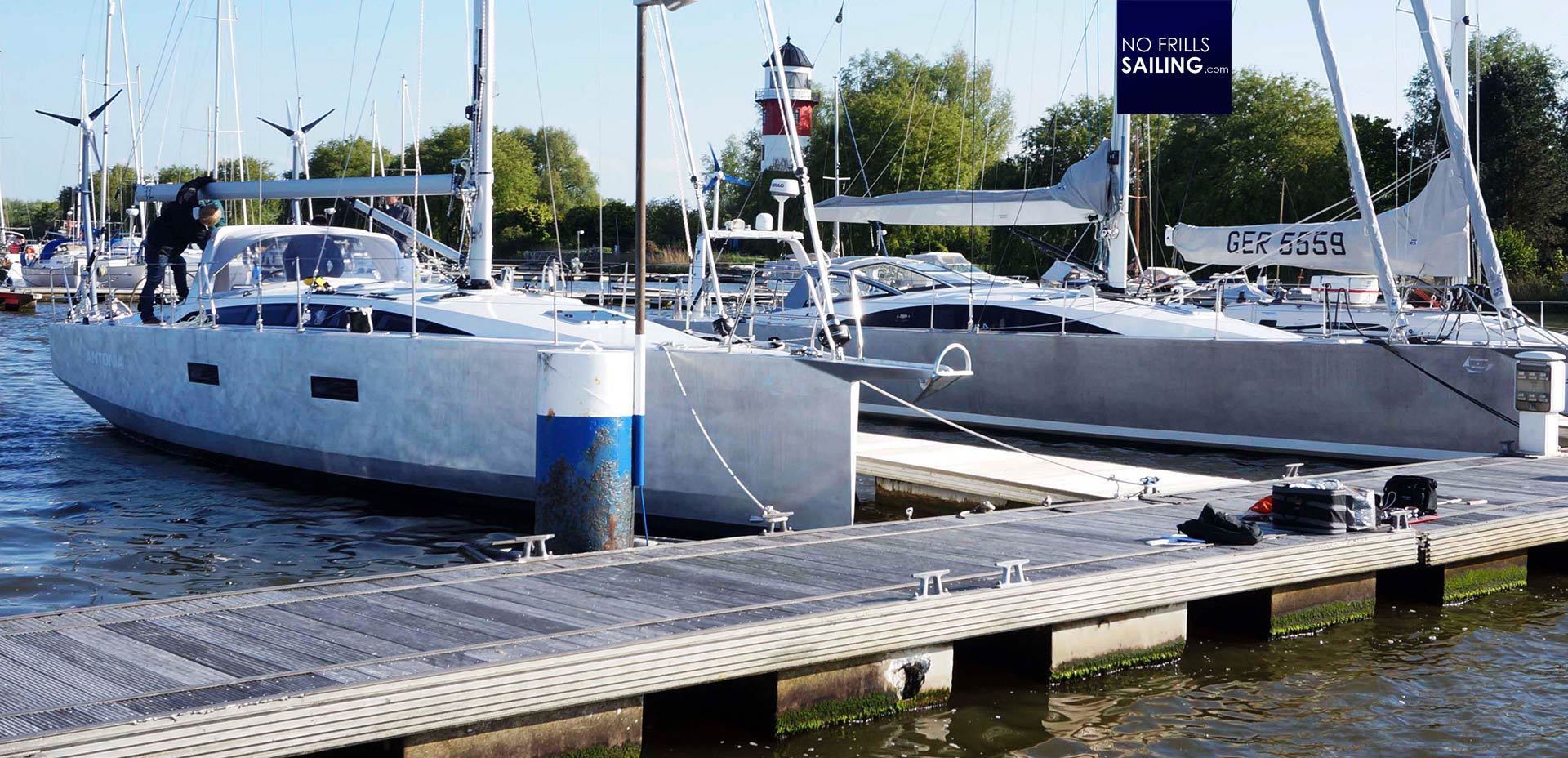
Well, looking at Martin Menzner´s own brand, the adorable aluminium-made Berckemeyer yacht , he himself delivers gorgeous, fast and worldwide renown sailing yachts – most of them with distinctive hard chines in the stern section, just a very few without. As Martin Menzner is not just a yacht designer but a keen sailor (and as a multi-times German Open and Kiel Week-winner on his J80 on PIKE ) as well who knows how a boat should be performing.
The Origins of Hard Chines in Racing
“Hard chines, or let´s say, wide aft sections in boat design derive from the planning power boats or, if you look at sailboats, small jolly boats just as the 49er or 14/18-footers.”, he starts: “These boats are made to displace as less as possible and remind more of a surf-board. Their most characteristic feature: They quickly get into surf-mode, meaning to plane.” Martin explains that the equation to get a boat into planning-mode is making it as light as possible and add a wide stern section with as less wetted surface as possible. “This effect can be scaled up to big racing boats. So, adding a wide stern and hard chines quickly became the formula for fast planing raceboats.”
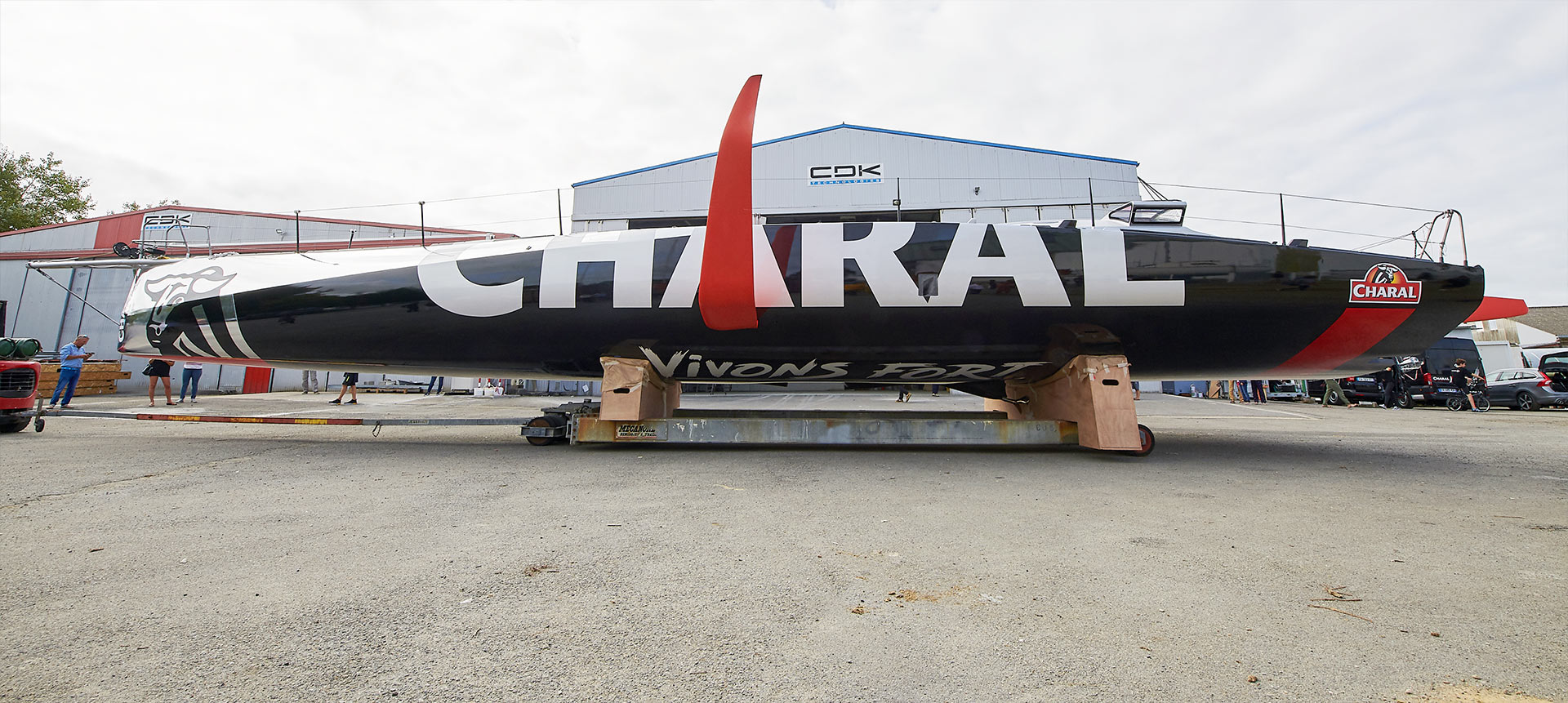
But it´s not just the wide stern section: “You want to prevent the boat from sucking itself to the water surface. So, adding a flat and wide stern was combined with the hard chine – this combination of design features made the boats entering plane-mode quickly, especially on reaching points of sail and at the same time prevented the fast hull to suck itself to the surface hence slowing down.” So far, so good: I have experienced the thrill of sailing on a fast, planing boat several times aboard a Pogo 40 – a truly addictive kind of sailing. The later conceived Pogo 12.50 featured a hard chine hull and is still one of my favourite fast cruisers.
Hard Chines in Cruising Boat Design
Hard chines and wide sterns entered cruising yacht design some years ago. Big production brands adapted to the design features and now hulls which carry max width up to the end, flat underwater hulls with least wetted surface as possible, double rudders and – you name it – hard chines are a commodity on cruising boats, just as the new Jeanneau 410 or all new Beneteau Oceanis-designs, like the 51.1 , 46.1 and even their smallest, the Oceanis 30.1 : “I would say, it´s just about aesthetics”, say Martin. Now we are talking business …
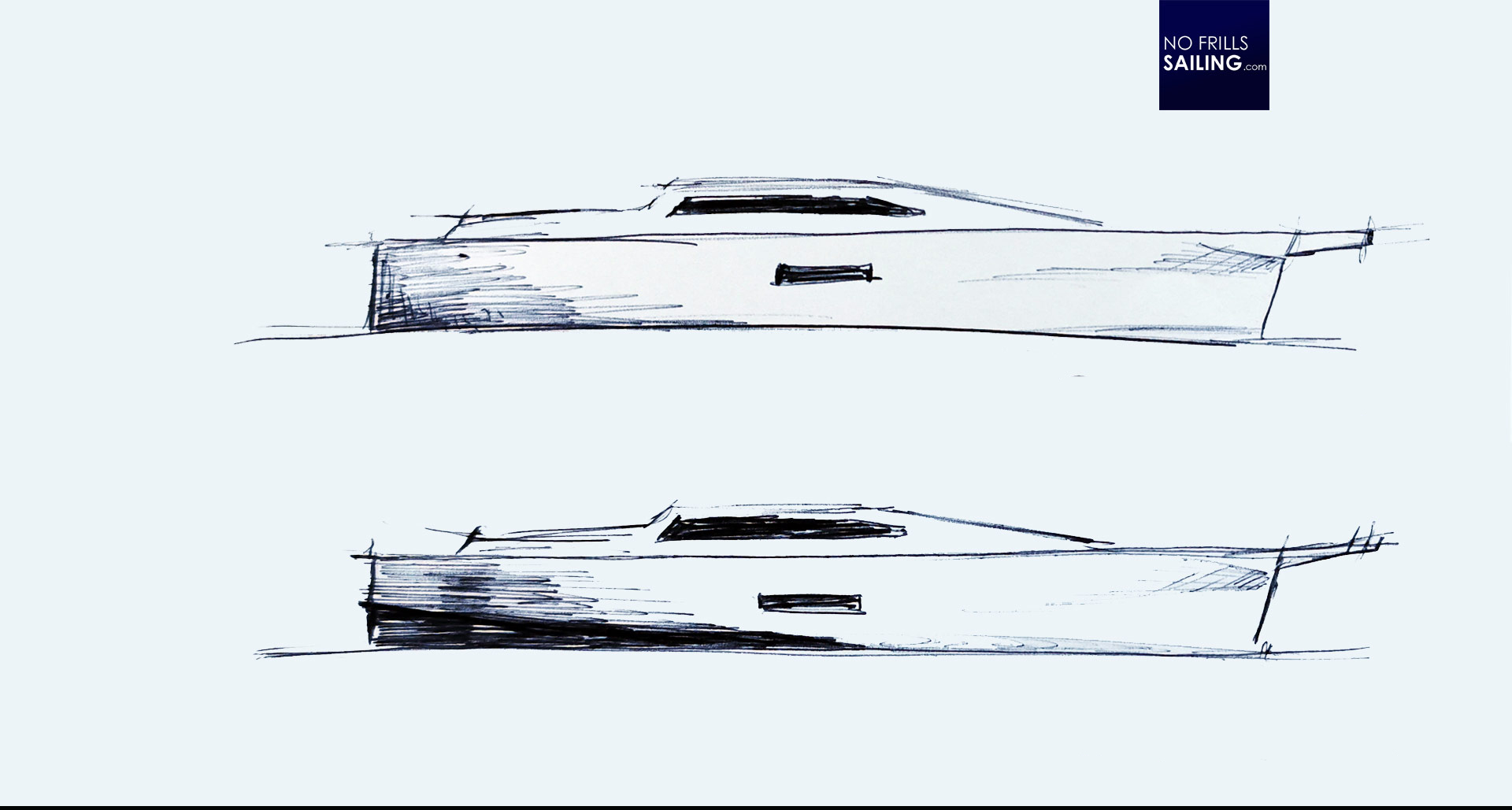
„Just as I explained when we talked about inverted bows lately, I would say that hard chines on cruising boats are first and foremost a question of pleasing the eyes of the owners. It´s about transferring images seen in the exciting lines of a racing yacht to a cruising boat. Promising speed and performance.” He adds: “To be precisely: It reduces the high freeboard optically. As hulls become flatter and flatter by at the same time increased demand for head room, it´s a nice trick to kind of reduce freeboard-height when looking at the boats.”
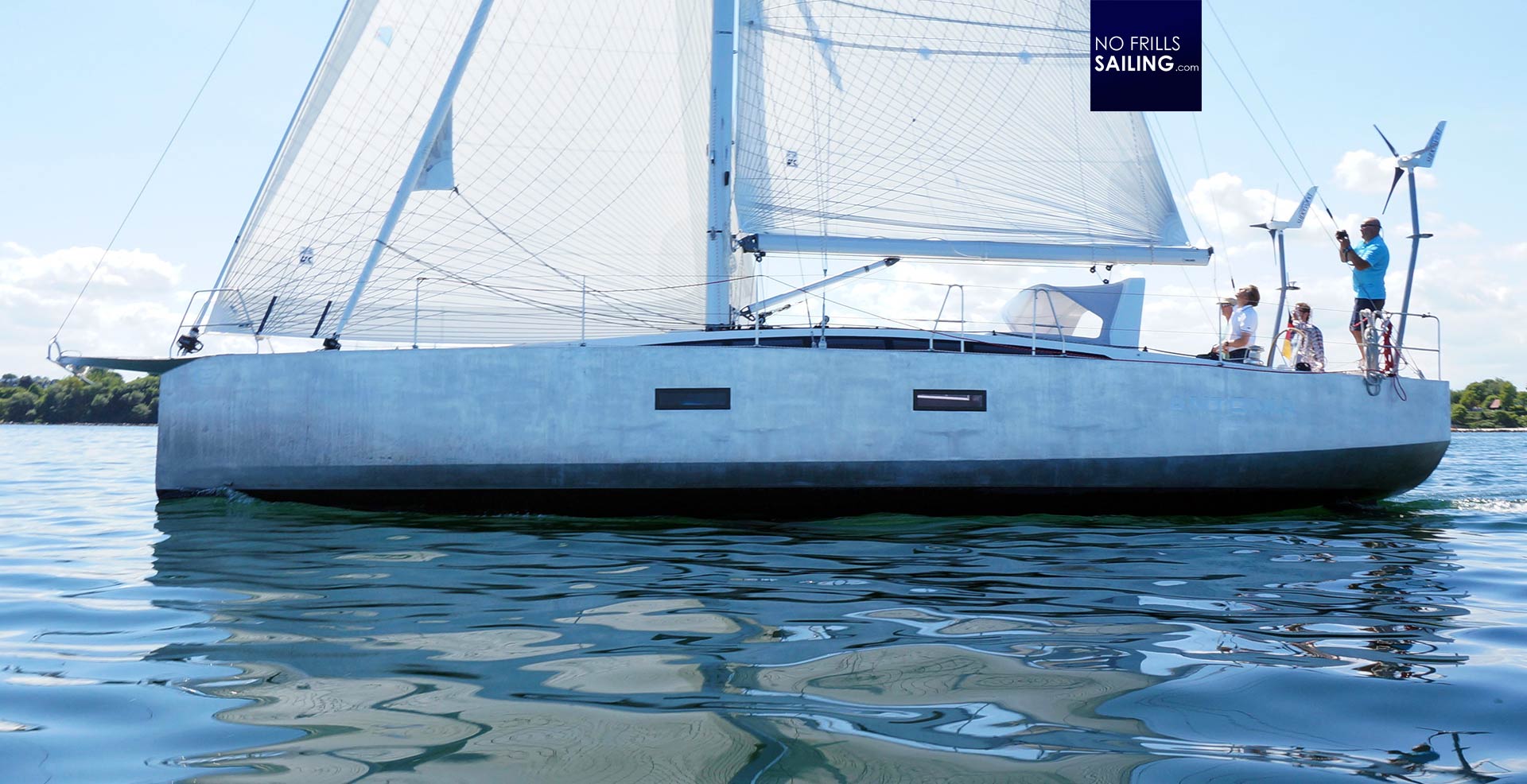
It really works for his own designs, the Berckemeyer Yacht, as well as for other boats. So in a way, the hard chine in the aft section is much more than just a visual reference to planing raceboats and a trend in yacht design but has a visual impact in the appearance of cruiser. “That´s just the beginning”, says Martin: “There is indeed more to the chine, even in cruiser-design.”
Advantages of Hard Chines in Cruising Yachts
He shows me the Berckemeyer BM 45 AUDACIA with a classic round frame, which was up for sale recently but quickly found a new happy owner. She is one of the few “classic” hull-shaped designs by Martin as her previous owner insisted on a semicircular frame. Her stern section looks awesome, very beautiful and perfectly crafted . “And here is – especially valid for aluminium boats – the critical point.” Crafting a perfectly rounded hull shape means much, much more effort for the boat builders. That is why a Cigale or Allures aluminium yacht´s hull is more expensive than the relatively easily built hard-chined hulls of an Ovni . “At least for metal boats that´s a big thing”, implies Martin: “Not so much for GRP-boats since laminating process is the same, but the big production companies do benefit from a hard chined stern in another way.”
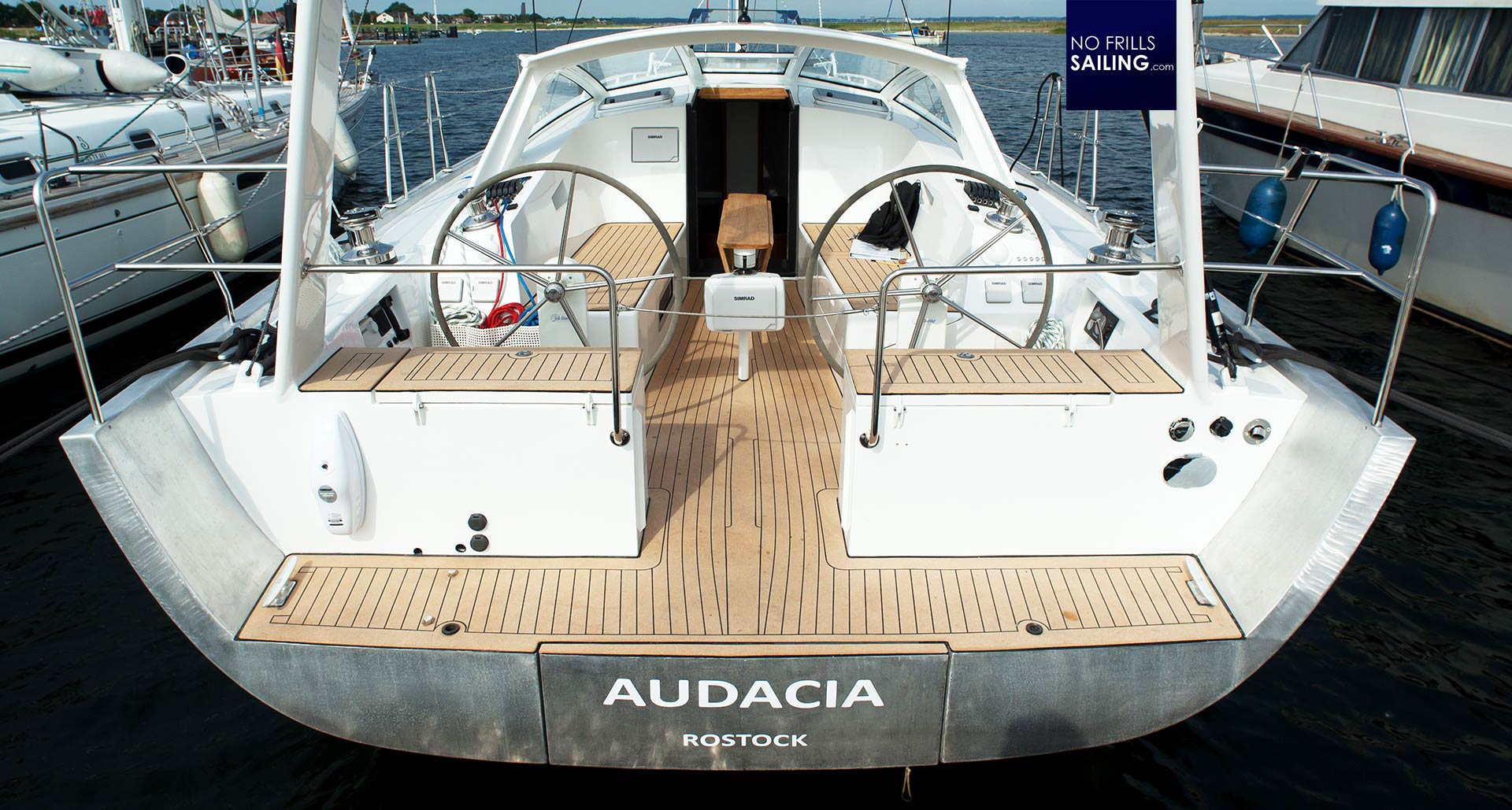
“Of course there is a noticeable increase of volume created in the aft cabins in a hard chined hull than it is achieved in a classic boat. Even when the maximum width is carried all the way back, you can clearly see the immense effect in internal volume here in aft cabins. So in a way, the big production boat companies can not only create a visually attractive product here but can also at the same time offer more comfort and volume in their boats.”

Surely with a hull design like this has an immediate effect on sailing characteristics: The hard chine, when sailing on a reaching point of sail, adds significantly to stabilize the boat as well as the leeward chine will work as a surplus stabilization when sailing with heeling upwind. The boats need less ballast which makes it lighter. On the other hand, boats as wide as these new generation cruisers must be fitted with a double rudder configuration.
Which way to go?
So is the current trend towards wide sterned hard chine yachts in cruiser-design the right way? For Martin Menzner the pros clearly outweigh the cons. More volume, more stability and better looks is definitely worth the price of having a doubled steering-mechanism installed. For aluminium yachts every chine reduces building costs and makes these boats a bit more competitive. “It´s definitely reasonable”, Martin agrees. On the other hand, BM 45 AUDACIA is an absolutely staggering design, timeless and beautiful.
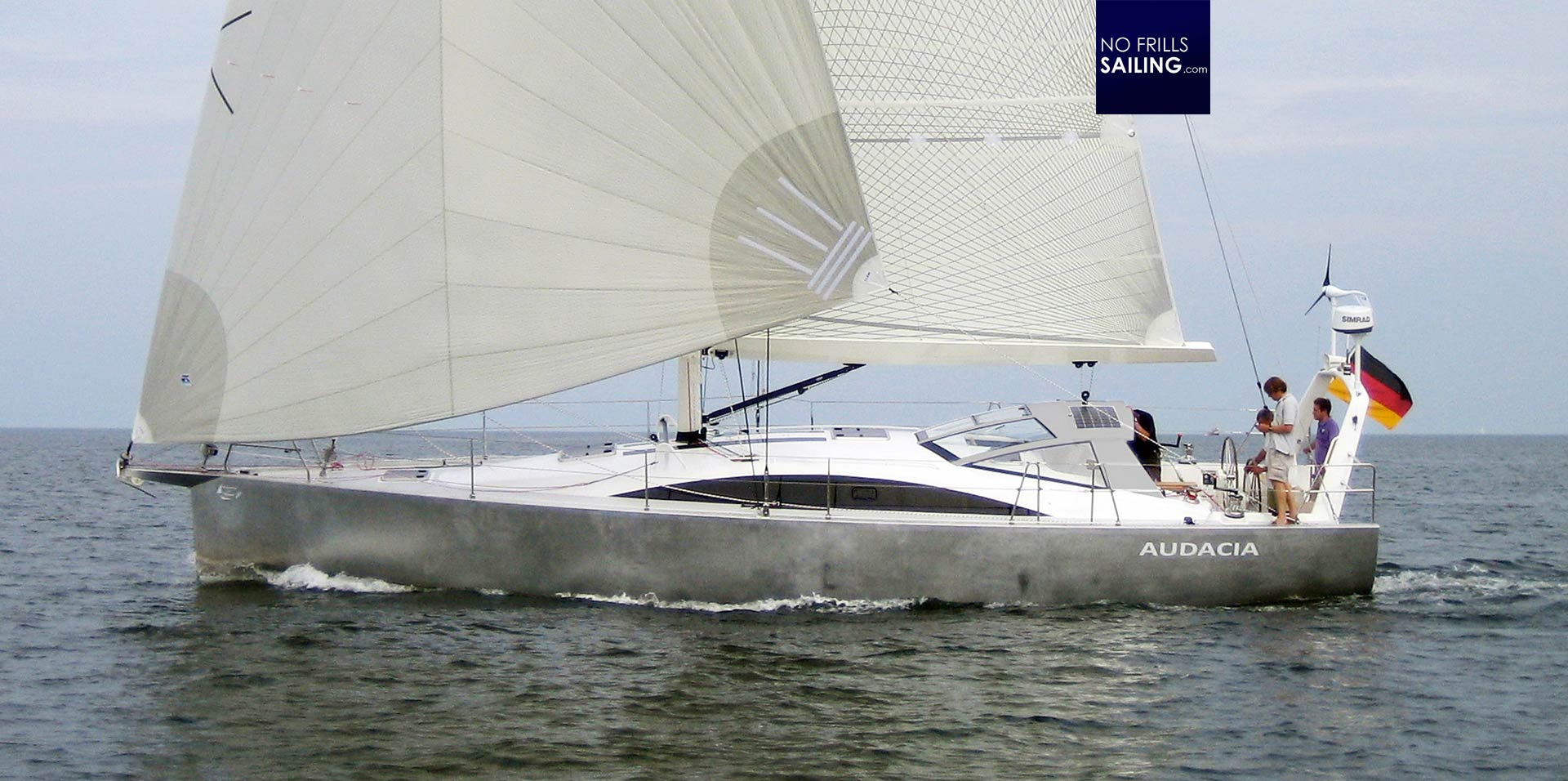
Seeing Beneteau adding forward chines 2018 with their new Oceanis 51.1 now makes absolute sense: Derived from top-notch racing yachts, proven by smaller companies like JPK or Pogo now the big names in the business have adapted and further developed this concept to fit the needs of their clients and markets.
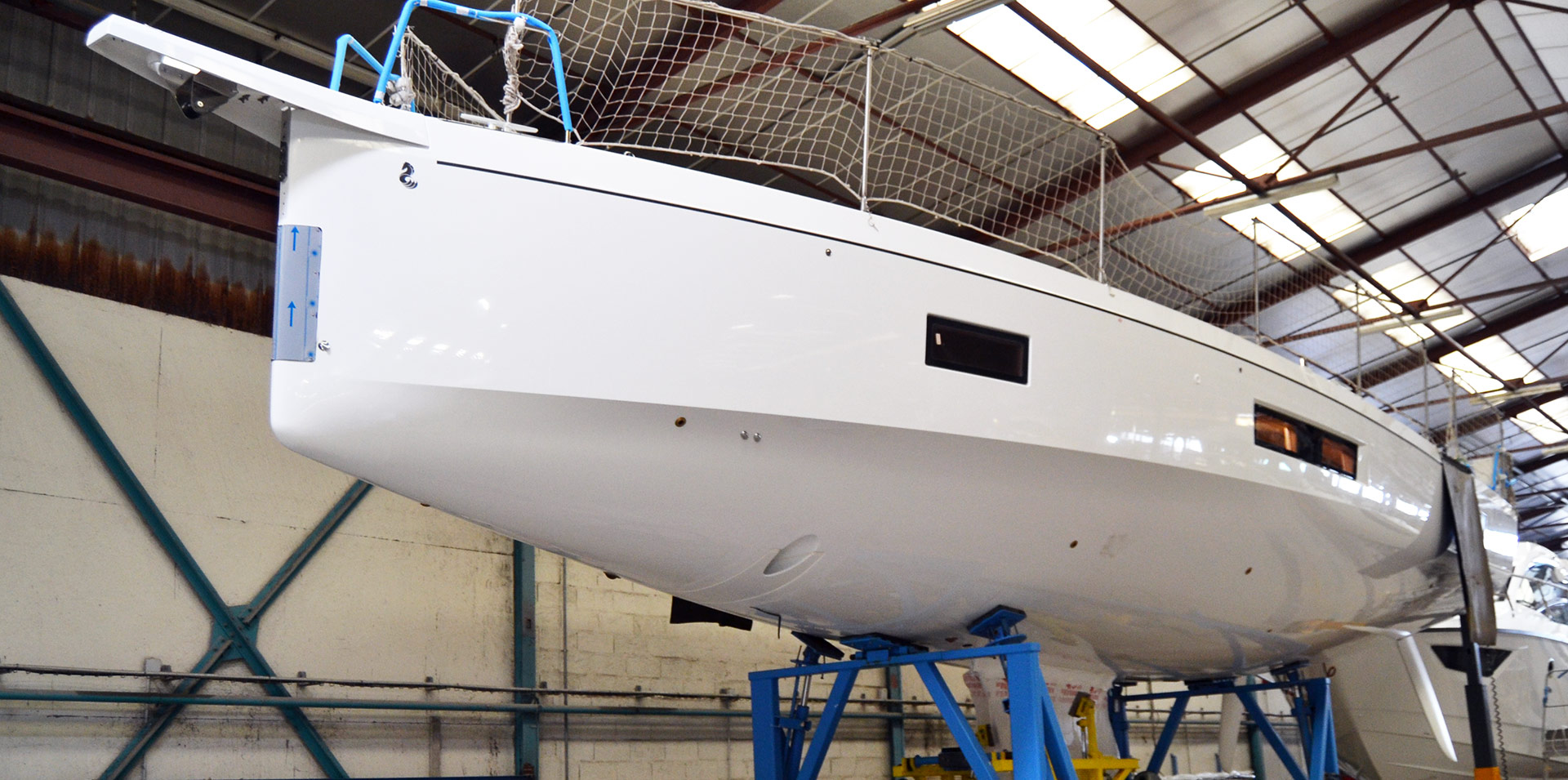
I found it highly interesting again to getting into Martin´s perspective for his BM Yacht-designs, boats which are bought by a very small and special clientele versus comparing this attitude with the views of the world´s market leaders in sailing pleasure craft. Which boat you choose is up to you but saying it with Martin´s words: “This is what yachts will be looking like even in 10 years because this is what people – the market – want right now and are seeing in sports sailing.”
Thanks Martin for another interesting conversation.
You may also like to read these interviews with yacht designers:
Martin Menzner on the perfect regatta-start
Javier Soto Acebal on Solaris yachts
Matteo Polli on appendages iterations

Boating Basics Online is reader-supported. When you buy via our links, we may earn a commission at no cost to you. Learn more
What is a Boat Chine? (Explained in Simple Terms)
Written by J. Harvey / Fact checked by S. Numbers
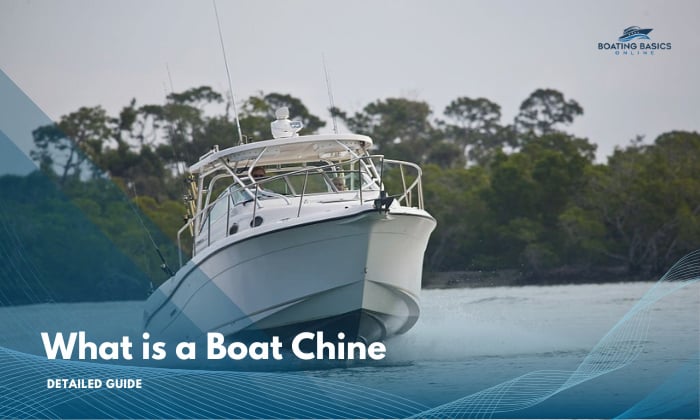
A true testament to the greatness of marine engineering is the fact that we can have hours of discussion about a specific boat part. For one, you’re probably here because you’ve been wondering, “What is a boat chine?”
The chine of a boat is a transition point where the side of the boat hull meets its bottom part.
It’s characterized by a sharp change of direction (ridge) in the bottom part of a boat. It plays a supporting role in enhancing the watercraft’s performance and stability.
Table of Contents
Definition and History of a Boat Chine
Role of chines in stability and performance, 1. soft chine, 2. hard chine, 3. reverse chine, 5. multi-chine hull, chine walk and its causes.
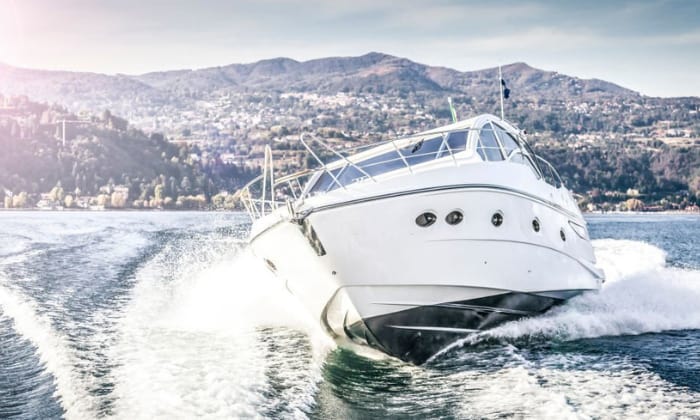
The official chine definition accepted by most marine experts is that they are the intersections where the hull’s side meets its bottom. This connection forms a sharp ridge that usually is located along the length of the hull, which is prominent in certain boat designs.
The history of chines is as old as the craft of boatbuilding itself.
- In the past, marine shipbuilders didn’t pay much attention to it and just found that incorporating a chine allowed them to simplify their construction process, considering how boats back then were mostly constructed of sheet materials.
- But once they started seeing its value in enhancing the vessel’s performance and stability, that’s when the experimentation and innovations started – and why we now have different chine hull types available.
It can come in various shapes and sizes and doesn’t always have a pointed, sharp look.
As such, its location can be anywhere on the hull where the said points meet, but given most designs, it can be considered a part of the boat’s underside.
- Chines pave the way to better stability. Although, in most circles, this is generally considered as only secondary stability, meaning the boat is less likely to roll over while traveling.
- We also can’t ignore how the chine lends to directional stability, especially during instances when you want your vessel to maintain its course.
- As for how chines benefit performance, we have to consider how flat-bottomed boats (associated with chine hulls) facilitate a planing hull. As we all know, such hulls are more amenable to better speed and efficiency.
Incidentally, if you’re interested in boat design, you’ll soon find that chine and lifting strakes design is an art in itself. It’s a favorite topic among boat design enthusiasts, particularly how it can be used to optimize stability and reduce spray, among other perks.
For instance, did you know that chine width should only be 2% (at most) of the total chine beam on each side?
Types of Boat Chines
Chines can be categorized based on their orientation and number on the hull. Counting them all, we arrive at five total types of boat chines. There’s an ongoing debate between hard chine vs soft chine, performance-wise, and I’ll let you be the judge based on the pros and cons of each one I shared here.
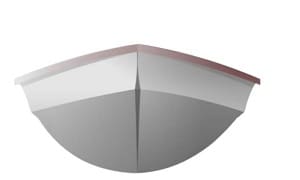
A soft chine has a more rounded and curved transition. This produces a gentler shape that makes it earn its name. It’s often the go-to chine for plenty of builders since it’s easy to build and maintain.
- Favored by most shipbuilders
- Cost-friendly
- The rounded bottom imparts more stability because it allows the boat to roll and return to position smoothly
- Provides a smoother ride experience
- The slightly higher angle makes it less efficient for planing, especially if you haven’t gained enough speed yet
- Doesn’t offer enough protection from water sprays
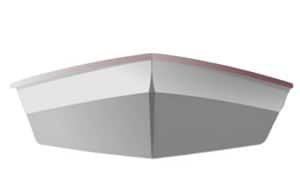
With a hard chine, there is no presence of curves at all. Rather, it’s characterized by a transition that’s more angular. This creates a distinct break in the hull’s shape, which is often visible to the naked eye.
- Can plane better
- Pushes water out and, thus, keeps everyone onboard dry
- Easier and faster to build
- Lacks the stability found in soft chines
- Generally requires more experience to handle
- Some designs lead to quicker wear and tear
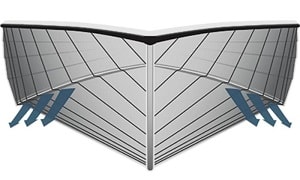
A reverse chine is characterized by sharp transitions that angle downward or upturned. It’s one of the newer designs and types of boat chine, built with practicality in mind.
- Such boats often keep water from splashing onto the deck while keeping propulsion smooth.
- It also makes the boat more than capable of handling choppier waters.
- Lastly, it aids the boat in maintaining its stability and buoyancy when making sharp turns.
- Not ideal for lengthy travel distances as it tends to consume a lot of fuel at top speed
- Not beginner-friendly
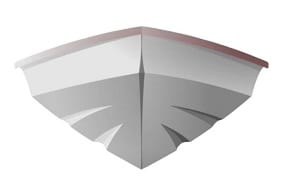
This type of chine is called such because it produces a “V” shape on the boat’s underside. It’s not as popular as most chines due to its highly impractical design.
- Not complicated to construct
- Tends to have poor stability
Related: V hull vs Flat Bottom
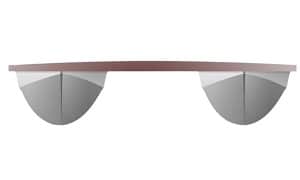
Multi-chine hulls can either be two-chine or three-chine hulls. Usually, more chines means more stability, strength, and buoyancy.
- Has a good balance of strength and ease of construction
- Allows more volume at the waterline while keeping the topsides vertical. This means more interior space and storage
- More aesthetically pleasing than most chine designs
- Pales in comparison to rounded hulls in terms of overall strength
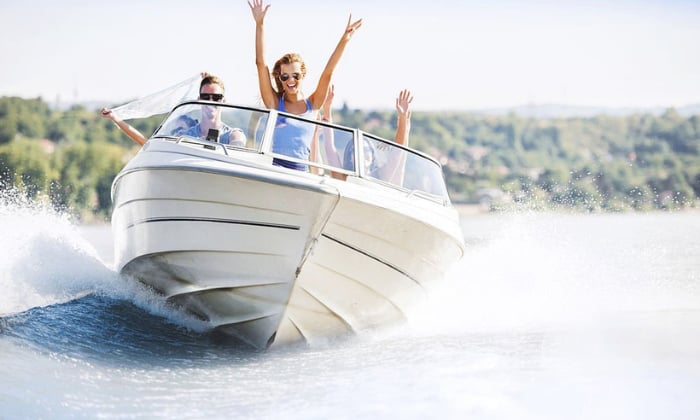
Chine walking is when the boat rocks from side to side because it loses its ability to balance on its keel.
It usually happens because a V-hull boat accelerates to the point that it starts to lift out. As it does so, the wetted surface on the V-shaped portion of the hull decreases, causing the loss of balance.
It can be tied to a number of causes, namely:
- The boat’s speed – chine walking occurs more often at higher speeds.
- The hull’s shape – V-hull boats are more prone to do it because of the sharp angle of the chine. Irregularities in design can disrupt the balance, too.
- Water conditions – choppier conditions result in chine walking.
- High-lift running pads – these are found in V-shaped boats to increase their lift. However, they reduce the wetted surface area and lead to the same balance issues.
- Operator inexperience – it can be avoided if you know how to manage your throttle, trim, and steering.
For a detailed explanation of chine walking, I suggest you watch this video:
And, that’s all the juice regarding the question, what is a boat chine? There’s no denying that these seemingly subtle design features on a boat’s hull can have a big impact on how it performs. Not to mention that they’re stylish in their own right.
Their benefits to boat stability make them indispensable for certain boat designs. They may have their downsides, but constant innovation proves they can be overcome – and offer even more advantages to vessel performance.

“My intention from the first day establishing Boating Basics Online is to provide as much help as possible for boaters who want to experience a first safe and convenient trip. So feel free to join us and share your beautiful journeys to the sea!”
🚚 FREE US SHIPPING ON ORDERS OVER $25 🚚

What is a Boat Chine and What are the Differences?

The chine of a boat refers to the change in angle in the cross-section of a vessel's hull. If you are looking at a boat straight on from the front or back, the bottom of the hull can be many different shapes. Some are extremely pointed while others are on the rounder side of the spectrum. What are the differences in boat chines? Do some of them perform certain functions other than others? Let's dive into the world of boat chines and exactly what are the differences between them.
History of Boat Chines
As with most things, it would behoove us to take a look at the history of boat chines. Obviously even the earliest boats had some sort of rudimentary chine, but it wasn't referred to as such. The first boats which were at least partially engineered were dugout canoes, which were built by hollowing out a log. These boats had rounded bottoms, likely due to the shape of the log that it came from. While this was serviceable, it left a lot to be desired so humans did what they do best and continued to engineer the boat chine.
Enter the planked hull. Traditional planked hulls were generally built by placing wooden planks parallel to the flow of water and this 'spine' was attached to bent wooden frames that served as ribs. The spine is referred to as the keel while the ribs are usually just called ribs. You can learn more about the keel in our blog ' Does a Sailboat Need a Keel? ' Planks were attached to these ribs and this produced a largely rounded hull, with a sharp bottom edge to form the keel. These rounded types of chine are called a 'soft chine'.

As innovation continued, the hard chine developed. This was a hull with a hard angle that does away with the rounding that was popular in the past. After the development of the steeply angled chines, there came the multi-chine hulls. These multi-angle boat chines fit almost any purpose that can be conceivably thought of. If you're unsure what sort of boat chine a certain vessel has you should keep in mind that these angles can be seen most easily near the bow.
Types of Boat Chines
A V chine vessel consist of two parts and basically forms a large 'V' shape at the bottom of the boat. While this shape is relatively easy to construct, that is about the only strong suit that it has. The V chin is one of the least stable shapes available, and for this reason alone it is very rarely seen.
A two chine hull is made up of a flat bottom and 90 degree angled sides. This model is extremely spacious and leaves plenty of room for cargo while remaining very stable. You'll often see this sort of construction on cargo ships for obvious reasons. If you've got a lot of stuff that needs to move across the water the two chine hull is the one to utilize!
One of the most common chine builds is the 3 chine hull. This model features an extremely wide V shape that extends out from the keel. Then sides over 90 degrees are extended up from each end of the V shape.

Multiple chines are especially valuable on larger ships that operate in rough conditions regularly. The wave is broken by the multiple angles instead of slapping against a single flat surface. Stepping of the chine also allow for less rocking and rolling for the same reason, the wave's impact are spread out over a longer period of time.
Multiple chines are also good for high-speed boating turns. As a boat or ship gains speed it will lift out of the water, otherwise known as planing. With less of the hull contacting the water the vessel becomes laterally unstable, which might seem like a bad thing, but this instability allows for the hull to pivot along its length and managed to stabilize turning at high speeds.
No matter what type of boat chine your boat happens to have you'll want to keep your hull clean with our Better Boat Instant Hull Cleaner . Make sure the rest of your boat is just as stunning as that newly cleaned hull with our marine metal polish .

Differences of Boat Chines
We've gone over a few of the applications of the different kinds of boat chines above, but there are even more comparisons that we can make. How about dryness? Well, the harder chine will push water out and away from your boat while the smaller angles of the soft chine will inevitably allow some water to spray over the sides. The hard chine will plane at much lower speeds due to the flatter surfaces.
While it sounds like the hard chine has some distinct advantages, these hard angles will also concentrate most stress in a smaller area which can lead to some massive wear and tear on your boat. Soft chines are easier to manufacture and maintain which is probably why they are used so widely in the boating world. If you've read some of our past blogs you'll know that I'm not an adrenaline junkie, I take things nice and slow and I'm on the water to relax so a soft chine is just fine. Heh, that rhymes. If you really want to relax, try floating around with this waterproof Bluetooth speaker .
On top of that, while hard chines can offer speed I did mention that they are much less stable. Why is that exactly? Well, a boat with a rounded bottom can get tossed around and roll quite a lot but it usually ends up rolling back into place. A hard chine flips over much easier, and much quicker for that matter. It can be very difficult to deal with a hard chine unless you have a ton of experience under your belt.

- choosing a selection results in a full page refresh
- BOAT OF THE YEAR
- Newsletters
- Sailboat Reviews
- Boating Safety
- Sailing Totem
- Charter Resources
- Destinations
- Galley Recipes
- Living Aboard
- Sails and Rigging
- Maintenance
- Best Marine Electronics & Technology
Hard Chines
- By Cruising World Staff
- Updated: January 10, 2011
This year’s new boat fleet featured several boats with aft sections that had more than a hint of hard chine. The question is: Do these creases in the hull improve performance? The answer is: The added buoyancy aft may help the hull dig in on upwind beats, and be flat and fast downwind, but by the looks of the chines we saw in Annapolis, creating hull lines with a more modern and angular look may have been just a important as performance considerations. Check out the chines.
To read more Cruising World reviews of Beneteau sailboats, click here . To visit Beneteau America’s website, click here .
first 30 profile.jpg
Jeanneau409.jpg, img_6689.jpg, img_6685.jpg.
- More: beneteau , keelboat , monohull , Sailboats
- More Sailboats
New to the Fleet: Pegasus Yachts 50
Balance 442 “lasai” set to debut, sailboat review: tartan 455, meet the bali 5.8, route planning in the face of climate change, how to rig everything in your favor, imtra named employee-owned company of the year.
- Digital Edition
- Customer Service
- Privacy Policy
- Email Newsletters
- Cruising World
- Sailing World
- Salt Water Sportsman
- Sport Fishing
- Wakeboarding
- Oceanis 30.1
- Oceanis 34.1
- Oceanis 37.1
- Oceanis 40.1
- Oceanis 46.1
- Oceanis 51.1
- Oceanis Yacht 54
- Oceanis Yacht 60
- FIGARO BENETEAU 3
- Heritage Sailing Yacht
- Flyer 7 SUNdeck
- Flyer 7 SPACEdeck
- Flyer 8 SUNdeck
- Flyer 8 SPACEdeck
- Flyer 9 SUNdeck
- Flyer 9 SPACEdeck
- Antares 7 Fishing
- Antares 8 Fishing
- ANTARES 11 FLY
- Gran Turismo 32
- Gran Turismo 36
- Gran Turismo 41
- Gran Turismo 45
- Swift Trawler 35
- Swift trawler 41 Sedan
- Swift trawler 41 Fly
- Swift Trawler 48
- Grand Trawler 62
- Heritage Powerboats
- Future Owners
- A REMARKABLE ANNIVERSARY
- Our History
- Our Architects and Designers
- Our philosophy
- Our Innovations
- Your way to ownership
- Event calendar
- Tests and Awards

- Description
- Key Features
- Specifications
The Oceanis 45 is no exception in keeping with Beneteau tradition. Years of innovation and precise attention to detail leave a distinguished performance in her wake.
NAVAL DESIGNER : FINOT - CONQ ET ASSOCIÉS
INTERIOR DESIGNER : Nauta Design

Exterior design
Built to combine safety, luxury and performance, the Oceanis 45’s distinctive hard chine promotes stability and increases interior space. Boasting a large cockpit with dual helms, open deck plan, roomy seating and a transom that doubles as a swim platform, this yacht corners the market in function and comfort.
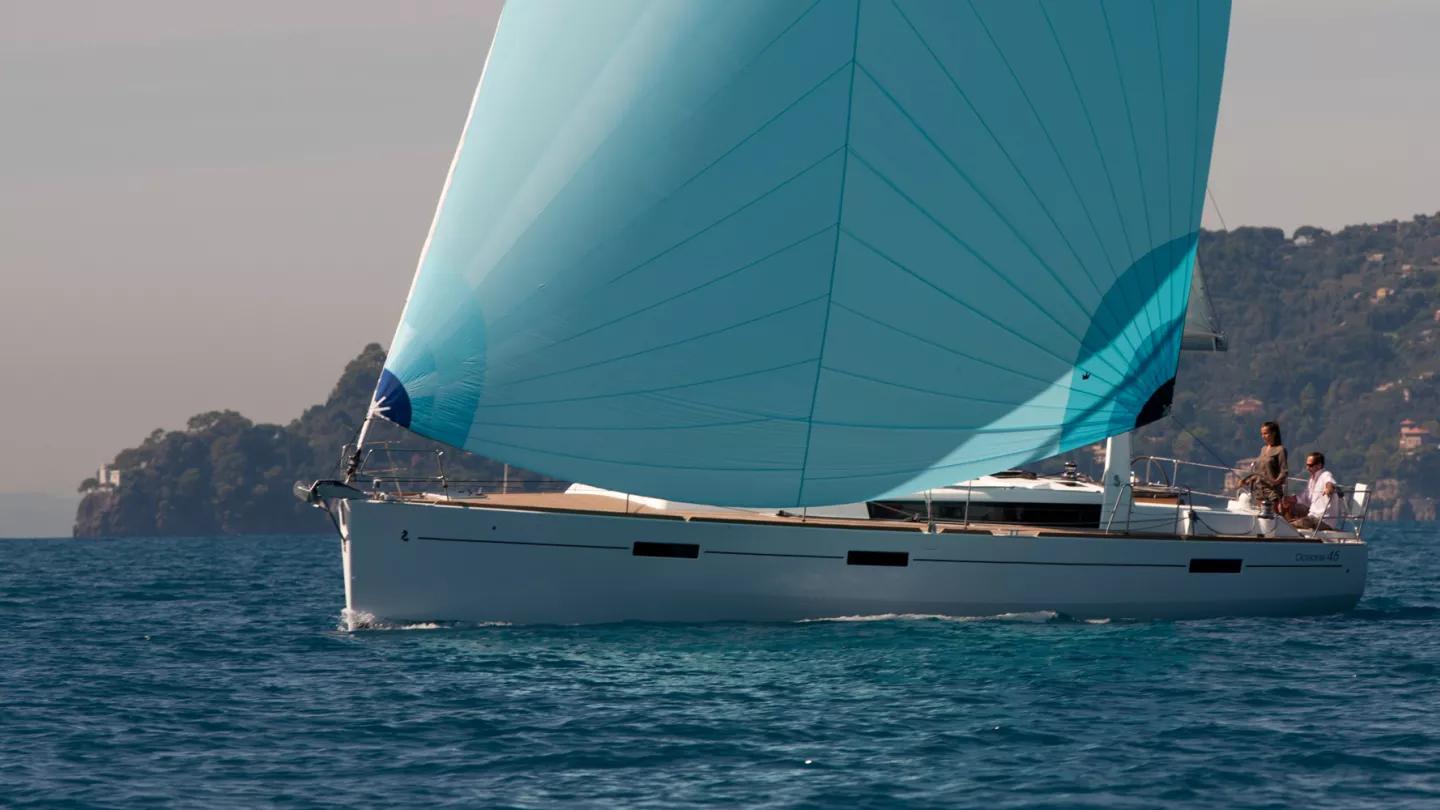
Interior design
Intelligent use of space allows a range of options below deck, including two heads with a choice of two, three, or four cabins. The skilfully designed interior, in either contemporary light oak or traditional mahogany, is bright and maximizes storage space.
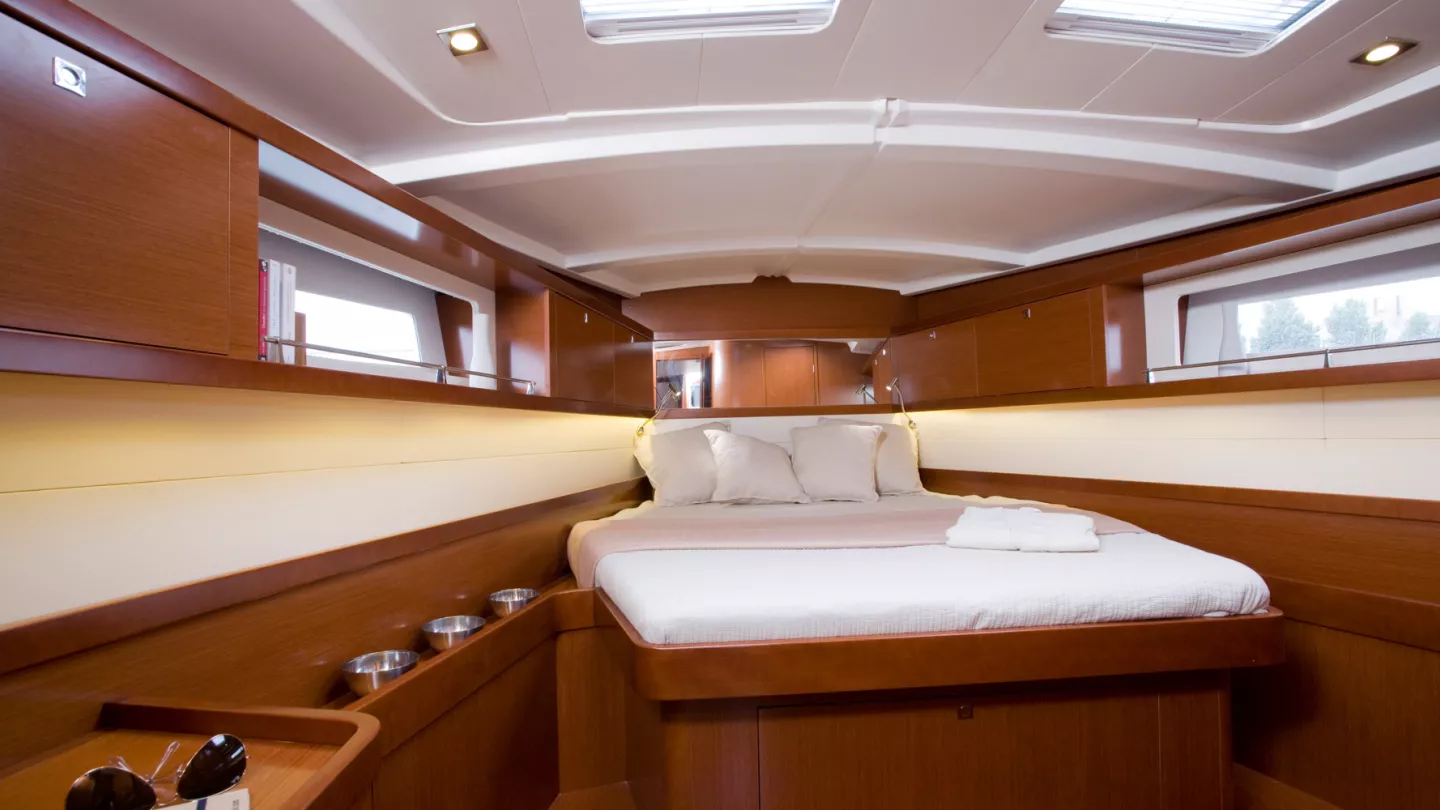
Confidently answering the call of the ocean
The Oceanis 45’s many innovations simplify life on board as much as they do sailing. The ocean beckons.
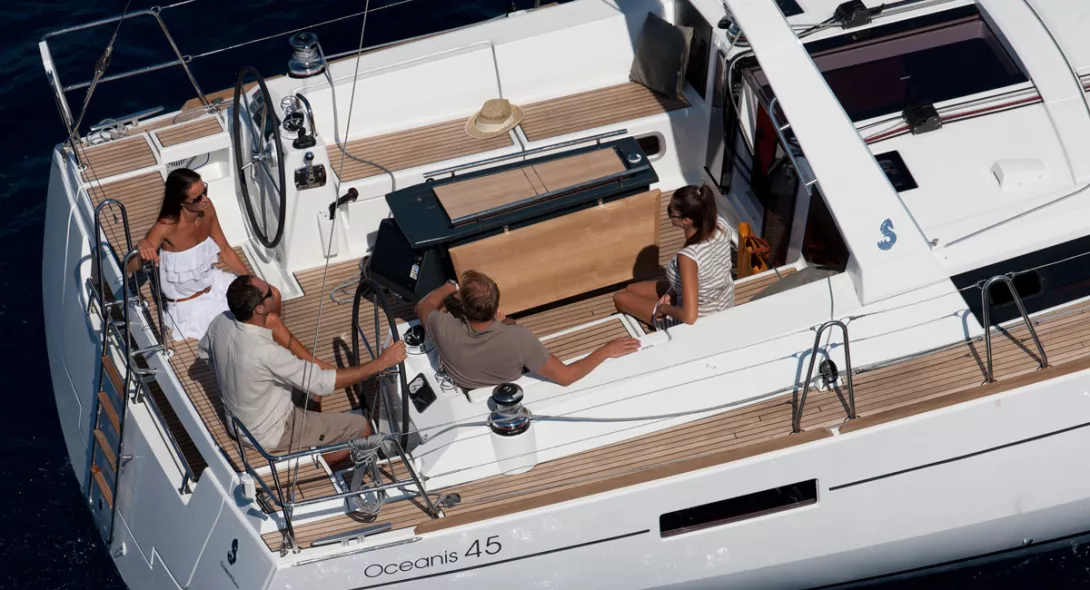
Safe and very convivial, the enormous cockpit is equipped with a table that can contain a refrigerated icebox. It also features a tactile multi-function screen and outdoor lighting.
45° companionway
An important characteristic of the latest generation of large Oceanis yachts, the 45° companionway connects the sizable cockpit with the boat’s spacious interior, contributing considerably to the ease of movement and lifestyle onboard.
Performance Pack
To optimize performance, a set of Performance Sails, combined with the German System that produced the ability to trim all the sails from the helm is a desired option.
Virtual tour
Characteristics.
Length Overall
Beam overall
Light displacement
Air Draft Max
Fuel Capacity
Water Capacity
Max. engine power
CE Certification
A10/B11/C12
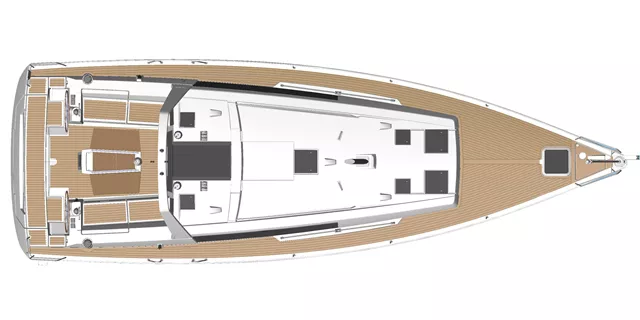
- CE certification A10/B11/C12
- B&G Electronic Pack
- Twin steering station
- Sail drive engine
- 9 flush deck hatches, 2 long plexiglass on roof and 2 companionway plexiglass, 6 hull portholes, door and companionway hatch glazed
- Drop-down transom, opening completely, converting into a swim platform (9'4" x 2'6"). Electrically-controlled opening. Natural solid wood decking on swim platform. Removable stainless steel swim ladder doubles up as an entry ladder
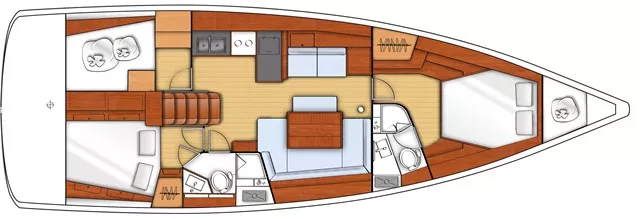
- Spacious master cabin with ensuite head, separate shower. Aft cabin with double bed (6'9" x 4'11" x 3'9") and storage on either side of the bed
- L-shaped galley: compact laminated worktop, double stainless steel sink
- Two heads with toilet and separate shower
- Comfortable gently sloping 45° companionway
- Sliding chart table (against forward bulkhead or between the 2 seats or against galley) and mobile seats (on one side or on either side of the chart table).
- 9 flush deck hatches, 2 plexiglass on roof and 2 companionway plexiglass, 6 hull portholes, door and companionway hatch glazed
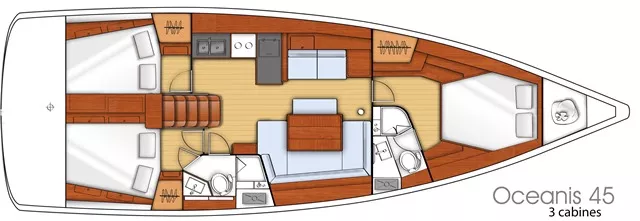
- Spacious master cabin with ensuite head, separate shower. Aft cabins with double beds (6'9" x 4'11" x 3'9") and storage on either side of the bed
- Large lengthwise fitted galley: compact laminated worktop, double stainless steel sink
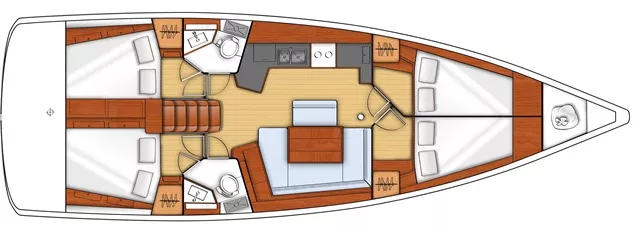
- Two fore cabins for two with hanging locker, aft cabins with storage on either side of the bed
- Two heads with toilet
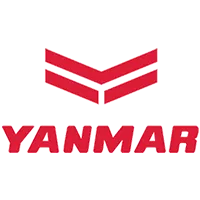
BENETEAU Yachts Rendez-vous 2019 – Sets Sail to Malta
Customer care.
Buying a BENETEAU doesn’t have to be a daunting task. We have teams of experts to guide you through the entire process – everything from sea trials, financing, and customization to after-sale commissioning, service, and maintenance. We are proud to have one of the largest, most highly-regarded dealer networks in the world. We’re ready to provide you with the assistance and expertise needed to launch you and your BENETEAU on a lifetime of happy, rewarding, and memorable voyages.
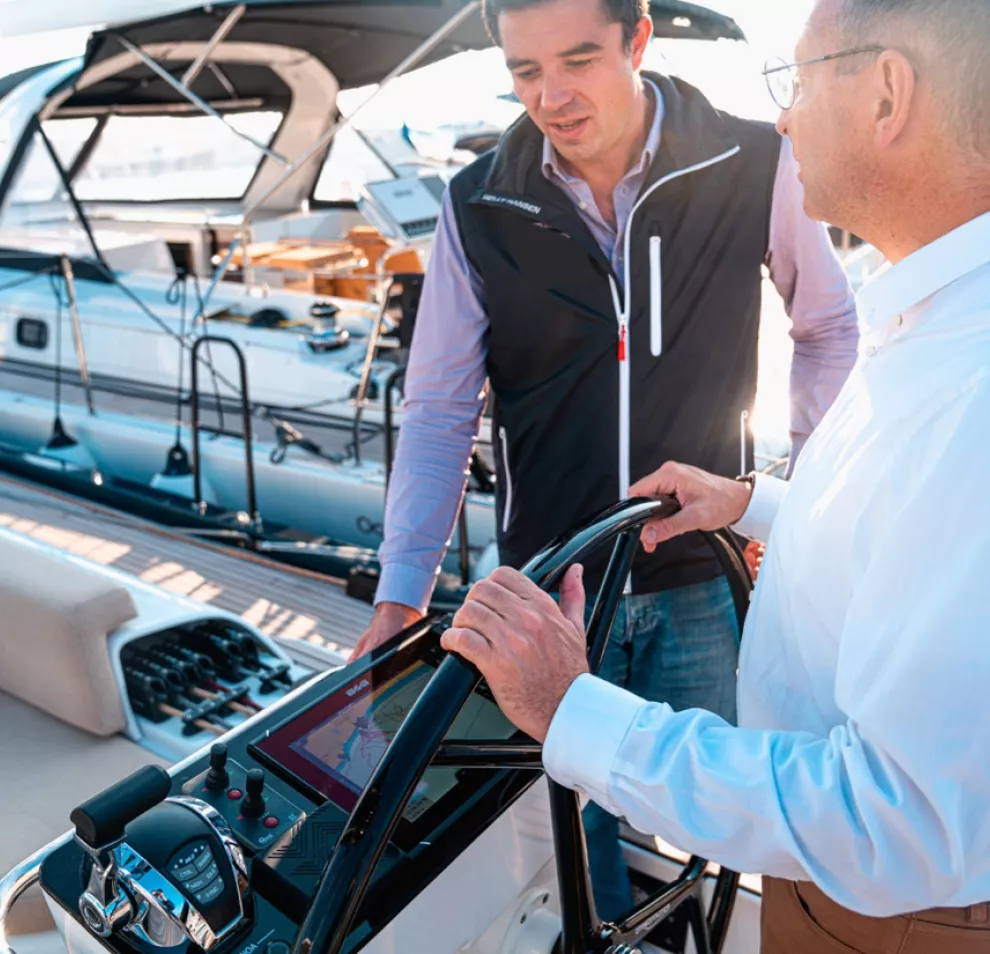
Other models in the range
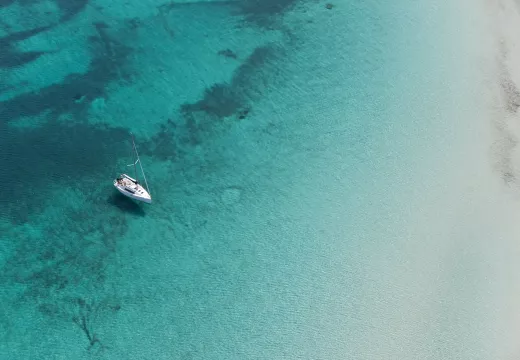
9.66 m / 31’8’’
3.39 m / 11’1’’
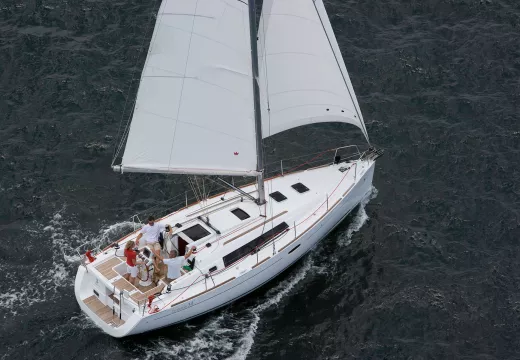
10.34 m / 33’11’’
3.65 m / 12’
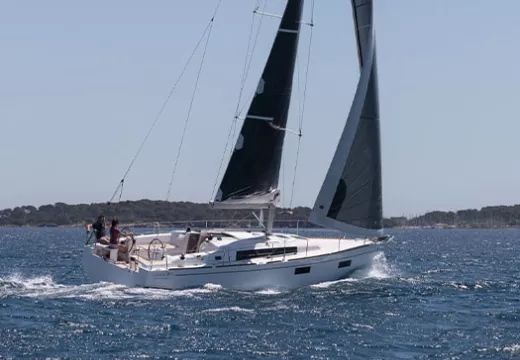
Oceanis 38.1
11.8 m / 38’9’’
3.99 m / 13’1’’
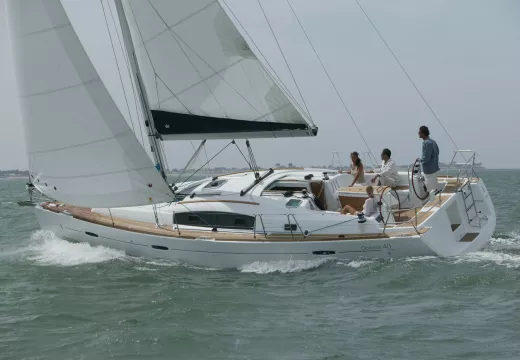
Oceanis 35.1
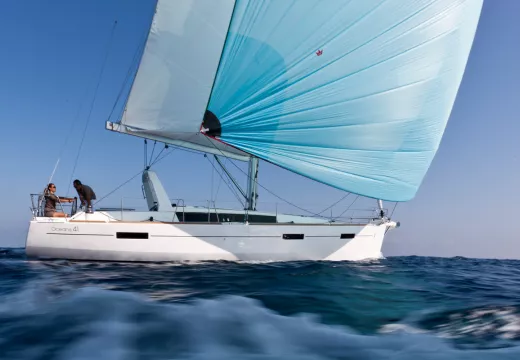
12.43 m / 40’9’’
4.2 m / 13’9’’
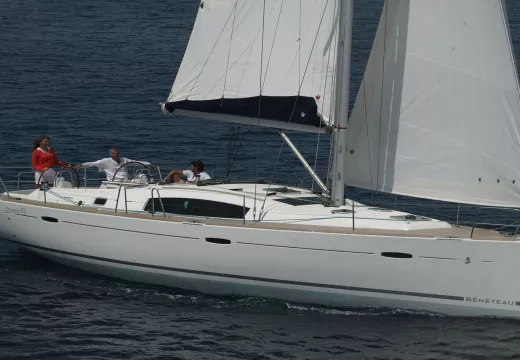
13.1 m / 42’12’’
4.12 m / 13’6’’
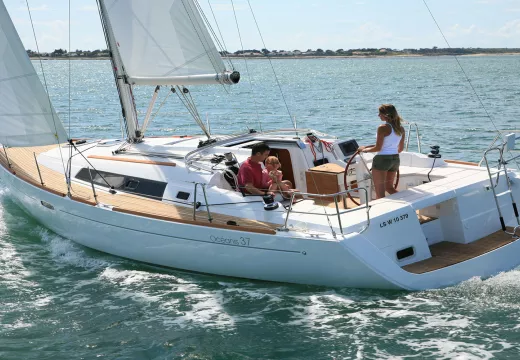
11.48 m / 37’8’’
3.92 m / 12’10’’
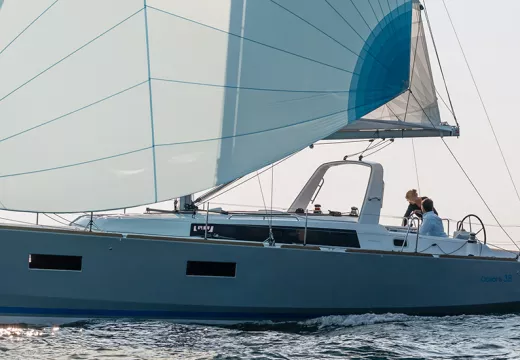
11.15 m / 36’7’’
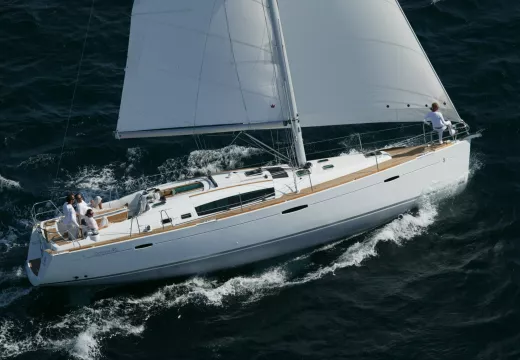
14.4 m / 47’3’’
4.25 m / 13’11’’
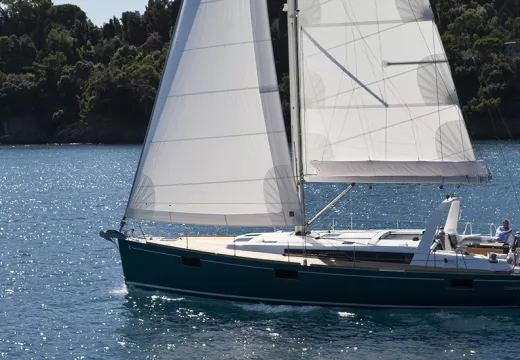
14.6 m / 47’11’’
4.74 m / 15’7’’
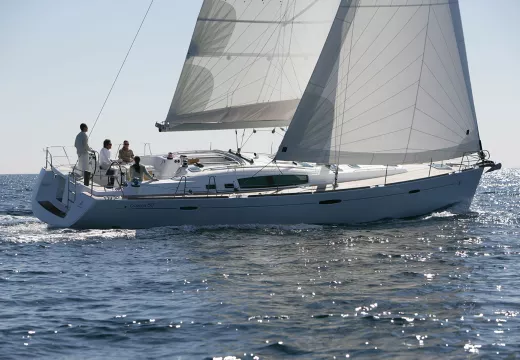
16.78 m / 55’1’’
4.96 m / 16’3’’
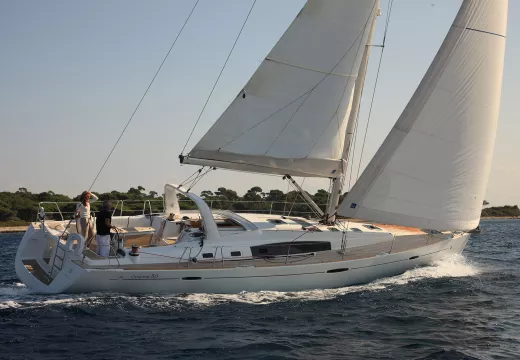
OCEANIS 50 NEW
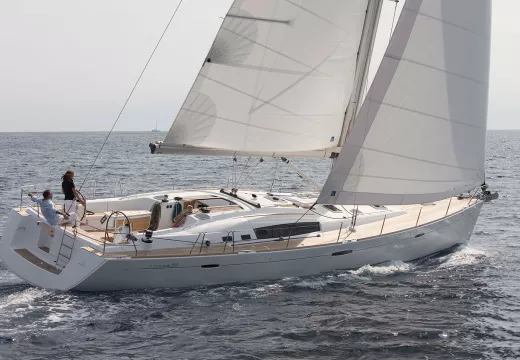
16.7 m / 54’9"
4.9 m / 16’1’’
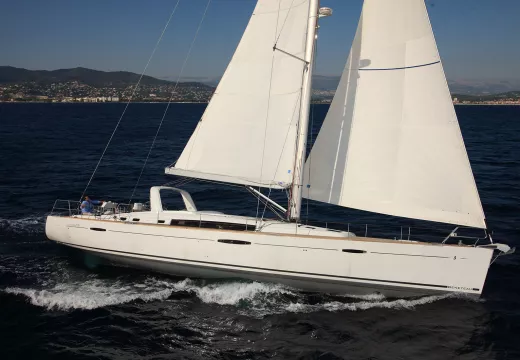
18.24 m / 62’3’’
4.99 m / 16’4’’
Select your area and your language
- Chinese, Simplified

Boat Chines Demystified: Exploring the Intricacies of Marine Engineering
Boat chines, an essential aspect of watercraft design, play a critical role in a vessel’s stability, performance, and handling. To understand their importance, we need to delve into the intricacies of boat design, covering topics like boat hulls, boat stability, and hydrodynamics.
In this comprehensive article, we’ll explore boat chines in-depth, examining their purpose, characteristics, and impact on various types of watercraft.
The Significance of Chines in Boat Design
Boat chines are the lines that form the intersection between a boat’s hull bottom and its sides. They primarily serve to enhance the hydrodynamics, stability, and overall performance of a vessel. The design of chines can significantly impact a boat’s maneuverability, tracking, speed, and efficiency. With an emphasis on boat customization, marine engineering aims to develop the optimal chine design for specific watercraft applications.
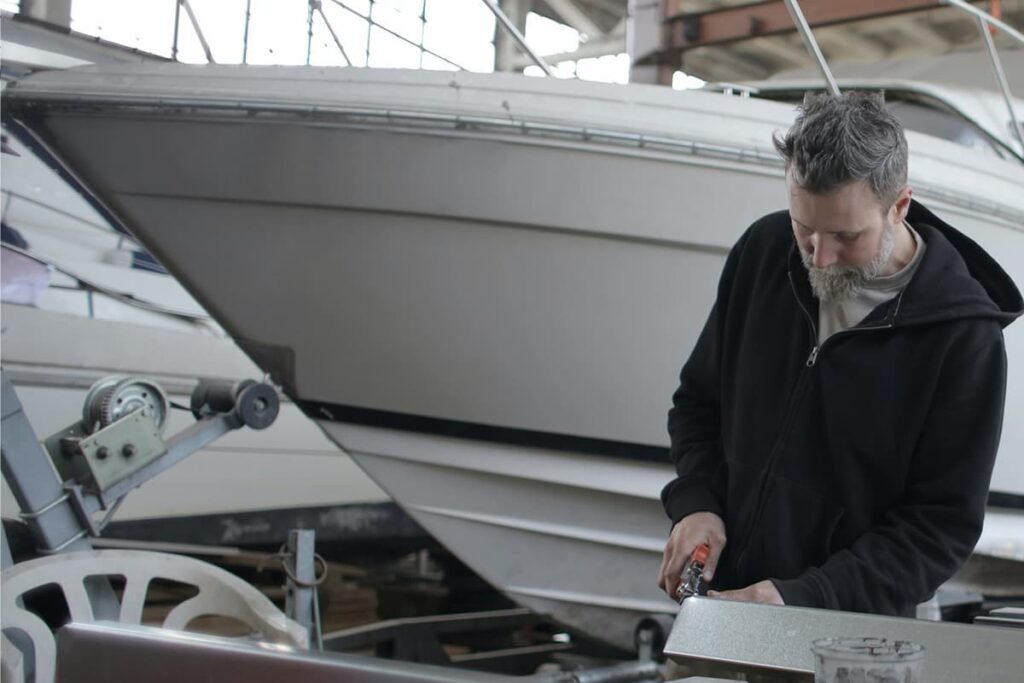
Hard Chines vs. Soft Chines: The Key Differences
Understanding the differences between hard chines and soft chines is vital for any boat enthusiast or marine engineer. Hard chines have a sharp, angular transition between the hull bottom and the sides, while soft chines feature a more gradual, rounded curve.
Hard chines offer several advantages, including increased stability, especially when a boat is at rest or moving slowly. They also provide a more significant planing surface, enabling the vessel to reach higher speeds with less drag. Powerboats, racing boats, and some sailboats often feature hard chines for enhanced performance and maneuverability.
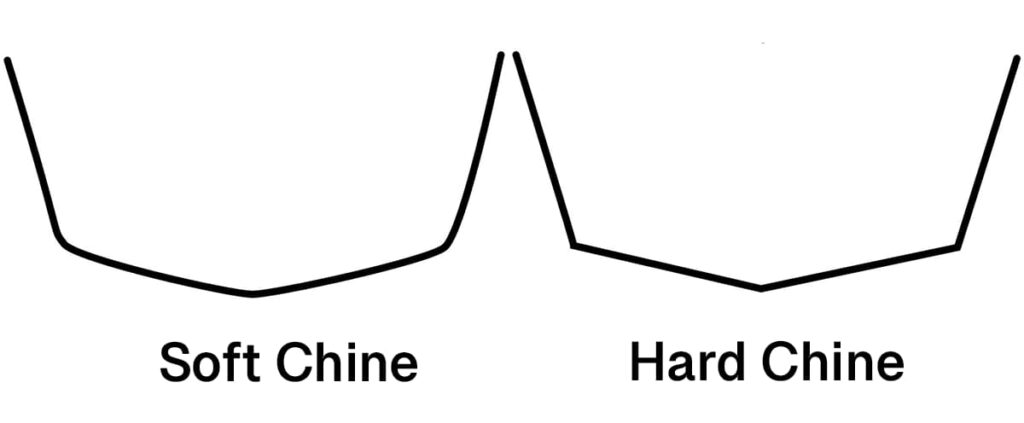
On the other hand, soft chines are known for their improved handling in rough waters and their ability to reduce the boat’s tendency to roll. With their smooth, rounded design, soft chines contribute to a gentler, more comfortable ride. You’ll often find soft chines on cruising boats, kayaks, and canoes, where stability and comfort are prioritized over speed and performance.
The Chine’s Role in Boat Construction and Aesthetics
Chines not only impact a boat’s performance but also play a crucial role in its construction and aesthetics. The chine part of a boat influences its overall shape, which in turn affects its appearance and how it interacts with water.
The choice of chine design depends on the intended use and desired characteristics of the watercraft. For example, racing boats typically feature hard chines for their speed and maneuverability advantages, while cruising boats may lean towards soft chines for a smoother, more comfortable ride.
Moreover, the chine design can impact the boat’s construction process . Hard chines can simplify the building process, as they often require fewer materials and less complex assembly. Conversely, soft chines may necessitate more intricate craftsmanship and a more extended construction timeline.
Chine Angle: A Critical Factor in Boat Performance
Another essential aspect of boat chines is the chine angle, which refers to the angle formed by the intersection of the hull bottom and sides. This angle directly impacts a boat’s hydrodynamic properties and performance.
A greater chine angle often results in better stability when the boat is at rest or moving slowly. However, it may also cause increased drag when the boat is moving at higher speeds. A smaller chine angle, on the other hand, can improve the boat’s performance at higher speeds, as it reduces drag and enables the vessel to slice through the water more efficiently.
Marine engineers and boat designers must carefully consider the chine angle when customizing a watercraft, striking the perfect balance between stability, performance, and efficiency.
The Impact of Chines on Various Watercraft Types
Chines play a significant role in the design and performance of various watercraft, including powerboats, sailboats, kayaks, and canoes
. The choice of chine design largely depends on the intended use and desired characteristics of the watercraft in question.
Powerboats often feature hard chines to optimize their planing surface, speed, and maneuverability. The increased stability provided by hard chines also allows for better handling in tight turns, a crucial feature for boats built for speed and performance.
Sailboats can have either hard or soft chines, depending on their intended use. Racing sailboats typically have hard chines to enhance their speed and performance, while cruising sailboats might have soft chines for better comfort and stability in rough waters.
Kayaks and Canoes
Kayaks and canoes generally feature soft chines for improved handling in rough waters and reduced rolling tendencies. The smooth, rounded curve of soft chines allows these smaller watercraft to cut through the water with less resistance, ensuring a more comfortable and stable ride.
Chines and Strakes: Understanding the Difference
In the context of boat design, chines and strakes are two distinct features with specific functions. As we’ve discussed, chines are the lines where the hull bottom meets the sides. Strakes, on the other hand, are longitudinal ridges or stiffeners on the boat hull’s exterior, designed to enhance the vessel’s strength, rigidity, and hydrodynamics.
Strakes can improve the boat’s tracking, stability, and speed by directing water flow along the hull and reducing turbulence. While both chines and strakes play essential roles in a boat’s performance, they serve different purposes and should not be confused with one another.
The Future of Boat Chines: Innovation and Customization
As marine engineering and watercraft design continue to evolve, we can expect to see even more innovation and customization in the realm of boat chines. Designers and engineers are constantly experimenting with new chine designs and materials to improve the stability, performance, and efficiency of boats across various applications.
From racing boats to cruising vessels, the choice of chine design will remain a critical aspect of watercraft development. By understanding the nuances of boat chines, boat owners, designers, and enthusiasts alike can better appreciate the intricate world of marine engineering and make more informed decisions about their watercraft.
In conclusion, boat chines are an integral component of watercraft design, impacting a boat’s stability , performance, and handling. By understanding the differences between hard and soft chines, the role of chine angle, and the unique considerations for various watercraft types, we can truly appreciate the art and science of marine engineering.
With constant innovation in the field, the future of boat chines looks bright, promising even better performance and customization for watercraft enthusiasts around the world.
Frequently Asked Questions (FAQ) about Boat Chines
What is the purpose of chines on a boat.
Chines serve to enhance a boat’s hydrodynamics, stability, and overall performance. They impact a boat’s maneuverability, tracking, speed, and efficiency, as well as its construction and aesthetics.
What is the chine part of a boat?
The chine part of a boat refers to the lines that form the intersection between the hull bottom and the sides. It influences the overall shape of the boat, affecting its appearance and how it interacts with water.
What is the difference between a chine and strake on a boat?
Chines are the lines where the hull bottom meets the sides, while strakes are longitudinal ridges or stiffeners on the boat hull’s exterior. Chines primarily affect hydrodynamics, stability, and performance, while strakes enhance the vessel’s strength, rigidity, and hydrodynamics.
What are hard chines vs. soft chines?
Hard chines have a sharp, angular transition between the hull bottom and the sides, offering increased stability and a more significant planing surface. Soft chines feature a more gradual, rounded curve, providing improved handling in rough waters and reducing the boat’s tendency to roll.
About the author
I worked as an officer in the deck department on various types of vessels, including oil and chemical tankers, LPG carriers, and even reefer and TSHD in the early years. Currently employed as Marine Surveyor carrying cargo, draft, bunker, and warranty survey.
Latest posts

Fiberglass vs. Steel: Which Is More Reliable?
Shipping professionals should get the most from their investment, so which is more reliable: steel vs. fiberglass? Here’s how to determine the better option.

What Does a Longshoreman Do?
Longshoremen play a critical role in the global supply chain, bringing billions worth of cargo into the country. So what does a longshoreman do exactly?

The Ocean Warming Effects on Marine Life
The last few decades have seen ocean temperatures rise as climate change begins to affect maritime industries worldwide. Here are the ocean warming effects on marine life seen so far.
- New Sailboats
- Sailboats 21-30ft
- Sailboats 31-35ft
- Sailboats 36-40ft
- Sailboats Over 40ft
- Sailboats Under 21feet
- used_sailboats
- Apps and Computer Programs
- Communications
- Fishfinders
- Handheld Electronics
- Plotters MFDS Rradar
- Wind, Speed & Depth Instruments
- Anchoring Mooring
- Running Rigging
- Sails Canvas
- Standing Rigging
- Diesel Engines
- Off Grid Energy
- Cleaning Waxing
- DIY Projects
- Repair, Tools & Materials
- Spare Parts
- Tools & Gadgets
- Cabin Comfort
- Ventilation
- Footwear Apparel
- Foul Weather Gear
- Mailport & PS Advisor
- Inside Practical Sailor Blog
- Activate My Web Access
- Reset Password
- Customer Service

- Free Newsletter

Ericson 34-2 Finds Sweet Spot

How to Sell Your Boat

Cal 2-46: A Venerable Lapworth Design Brought Up to Date

Rhumb Lines: Show Highlights from Annapolis

Solar Panels: Go Rigid If You have the Space…

Leaping Into Lithium

The Importance of Sea State in Weather Planning

Do-it-yourself Electrical System Survey and Inspection

When Should We Retire Dyneema Stays and Running Rigging?

Rethinking MOB Prevention

Top-notch Wind Indicators

The Everlasting Multihull Trampoline

What Your Boat and the Baltimore Super Container Ship May Have…

Check Your Shorepower System for Hidden Dangers

DIY survey of boat solar and wind turbine systems

What’s Involved in Setting Up a Lithium Battery System?

The Scraper-only Approach to Bottom Paint Removal

Can You Recoat Dyneema?

How to Handle the Head

The Day Sailor’s First-Aid Kit

Choosing and Securing Seat Cushions

Cockpit Drains on Race Boats

Re-sealing the Seams on Waterproof Fabrics

Safer Sailing: Add Leg Loops to Your Harness

Waxing and Polishing Your Boat

Reducing Engine Room Noise

Tricks and Tips to Forming Do-it-yourself Rigging Terminals

Marine Toilet Maintenance Tips

Learning to Live with Plastic Boat Bits
- Sailboat Reviews
Practical Sailor Reviews Seven Performance-Sailing Dinghies
Agile, fun boats like the classic sunfish and new hobie bravo keep the smile in summer sailing..
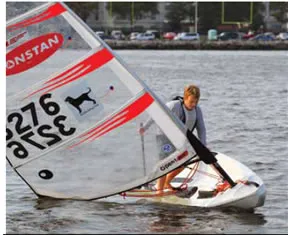
Photos by Ralph Naranjo
Messing around in small boats is a global theme-one thats embraced by pond-bound pram sailors, river riders, lake voyagers, and all of us who call salt water home. The purpose of this sailing dinghy profile is to highlight seven very interesting little sailboats. Some are new designs, and others have stood the test of time, but all are currently being manufactured, and each drives home just how much fun sailing close to the water can be.
This isn’t a shootout among anorexic speedsters or a report on the best tender that doubles as a sailing dinghy. Its a look at perennials like the Optimist, Sunfish, and Laser-legendary competitors that have helped spawn some of the best sailors in the world. But its also a look at three of the newest entries in the dinghy-sailing circle: Bics Open, Hobies Bravo, and Laser Performances Bug. These agile, new sailing dinghies are chock full of fun and boat-handling features to inspire kids of all ages to go sailing.
Well also take a look at Chesapeake Light Crafts kit approach to getting started-one that offers meaningful lessons and tangible rewards well before the boat ever hits the water.
Scale down an Open 60, add sail technology long favored by windsurfers, and put it into play in a tough thermo-formed hull, and you have the makings for a new kind of watercraft. The result is a very interesting blend of performance and reliability that targets adolescent interest. When all is said and done, Bics boat is more akin to a sit-down windsurfer than a traditional Blue Jay. And like all good boats, its vying for attention not just based on performance, construction quality, and style, but just as importantly, on the price tag stuck to the hull.
The Open Bics light weight and wide, flat stern section means that even small chop can be surfed; and bursts of planing on a reach add a zing factor to dinghy sailing. The Open Bic is already an International Sailing Federation (ISAF)-sanctioned class, and fleets are developing around the US. Another bonus: Its an easily portable boat that can be carried like a windsurfer, adding excitement to a Sunday picnic at the beach.
The thermo-formed polyethylene hull is a modified hard-chine design with lots of beam aft. Sailed flat, the boat is agile enough to surf wavelets, and with a shape thats ergonomically friendly to hiking, the ensuing heel on the upwind leg puts just the right amount of chine into the water. In light air, careful control of heel can significantly reduce wetted surface.
The design team that developed the Open Bic saw it as a transition bridge from Optimist sailing to a more performance-oriented dinghy. An interesting innovation is that the Open Bic can be sailed with an Optimists rig and blades. This buy the hull only approach can be a significant incentive for parents with children outgrowing their Opti as fast as their boat shoes. However it wont be long before the kids want the fully turbo-charged feel delivered with the Open Bics well-shaped 4.5-square-meters rig, sail, and nicely foiled blades.
Bottom line: The Open Bic is fast, agile, and buckets of fun for kids uninspired by sailing in the slow lane.
Just when you think that Hobie Cat Co. has covered whats possible in beach-cat innovation, their design/engineering crew comes up with a new twist that reinvents the wheel. The Hobie Bravo is a good case in point.
In a recent visit to Backyard Boats ( www.backyardboats.com ) in Annapolis, Md., we got a good look at the Bravo. Nearly as narrow as a monohull but still quite stable, this quick-to-launch beach cat packs plenty of get-up-and-go. Its a simple to sail, entry-level boat that fast tracks learning the steer, sheet, and hike trilogy. The boat features a single, midline rudder and roto-molded hulls. The shape of the hulls provides enough lateral plane to allow a crew to make headway to windward.
The narrow (4 feet), 12-foot Bravo uses crew weight and hiking straps to add to the righting moment once the breeze is up. Whats done with webbing on larger cats has been converted to a shallow, rigid deck well on the Bravo. It does raise the weight of the boat to 195 pounds, but it offers comfortable seating plus room for cushions and a cooler. Kids or grown ups can have a Tom Sawyer-Huck Finn type of adventure aboard this fun little sailing machine. Or the family on a beach picnic can set it up and take turns speed reaching along a sandy shoreline.
The furling mast supports a roachy sail with slightly slanted vertical battens, helping to shape the boomless mainsail. The result is convenient sail handling, decent performance, and superior safety. Theres no boom to clobber the crew, and the roller-furled sail and mast are easily stepped in the tripod-like receiver. This interesting set of struts raises the top bearing point of the mast step and spreads rig loads out to the hulls. The furling mainsail offers the ability to reef, a big plus in a building breeze or when teaching children to sail.
Like all of the boats in the Hobie lineup, theres a wide range of specialty parts and fittings that make the boats fast to rig and easy to handle. The kick-up rudder is hung on gudgeons mounted in the center of stern, and just as rig loads have been effectively spread via the tripod step, the energy radiating from the large rudder is spread athwartships via a contoured deck element.
Bottom line: The boat is quick to rig, easy to launch, and responsive to beginners-more experienced sailors will have just as much fun power reaching when the breeze is up.

A pocket-sized club trainer, the Bug is an evolution of the kids trainer/club racer that leverages lessons learned in Optis, Dyers, and Sabots. It pulls together the logic of a stable hull shape and simple-to-sail rig, and puts it all in a cost-effective package.
Lending to its success is designer Jo Richardss ergonomic, roto-molded hull, a fabrication that is as close to zero maintenance as a boat can get. The straight out-of-the-mold polyethylene skin gets a few decals, and theres no wood to refinish or gelcoat to wax. These tough, abrasion-resistant hulls have a bumper boat tolerance thats a big plus when it comes to kids learning to sail. Best of all, owners can start with a learn-to-sail rig and upgrade to a more performance-oriented mast and sail package (41 or 56 square feet) that kicks performance into the fast lane.
Oars and an outboard motor bracket can be added to turn the little sailboat into a dual-purpose dinghy. Even the bow painters means of attachment makes sense-no projecting hardware ready to knick the topsides of unintended contacts. Instead, theres a recessed hole in the stem allowing a line to be lead through and a knot used to keep the painter in place.
Bottom line: Aimed at club programs and families look for boats that can be transported on the car top, the Bug is easy to rig and definitely kid friendly. The fact that its manufacturer, Laser Performance, is an international interest and a major player in the performance dinghy industry means that this boat and its parts will be around for a while.
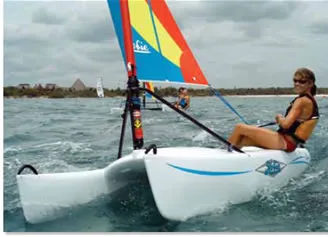
Photo courtesy of Hobie Cat Co.
Eastport Pram
Chesapeake Light Craft expedites boatbuilding for do-it-yourselfers looking to take their garage-built boats for a sail. The company pre-cuts parts, packs kits with all the materials, epoxy, and paint youll need, and leads homebuilders through a thoroughly detailed stitch-and-glue approach to assembly. Kits are available in various stages of completeness, ranging from plans only to the full package, including sail, hardware, running rigging, and paint.
The Eastport Pram is just shy of 8 feet, and the marine plywood and epoxy construction delivers a boat that weighs in, sans sailing rig, at just 62 pounds. Lighter than the comparatively sized Bug, this stiff, durable dinghy, rows like a real boat and sails comfortably with one or two aboard. In keeping with other good tender attributes, the Pram behaves under tow and is equally amicable when propelled by a small outboard or tacked up an estuary under sail.
Kit boatbuilding continues to have a niche following. Theres also an added-value feature worth noting: On one hand, the builder receives a box of pieces and the result of his or her endeavor leads to an aesthetic and utilitarian dinghy. In addition, the DIY skills the builder develops will be useful in other epoxy bonding, brightwork, or mono-urethane application projects. Such talents will benefit many other boat maintenance endeavors.
Whats hard to quantify is the sense of accomplishment derived from sailing a boat that you have built yourself. When the project is tackled in tandem with a child, spouse, or friend, the memories and the boat will last.
Bottom line: With neither sidedecks or a sealed hull, this is not a boat thats easy to recover from a capsize. So once the kids favor on-the-edge sailing in a building breeze, a non swamping, easier-righting boat is probably a better option. The Pram can then be put to use by their appreciative parents or grandparents.
Never in their wildest dreams did Bruce Kirby and Ian Bruce imagine that the Weekender (the Lasers original name) was destined to become an Olympic class sailboat and one of the most popular springboards for top-tier sailors in the world today. Originally envisioned as a car-topper for weekend campers, the cat-rigged, low freeboard sailing dinghy morphed from its original roots into a boat favored by college competitors and revered by generations of agile sailors of all ages. Even frostbiting winter sailors have locked onto the Laser.
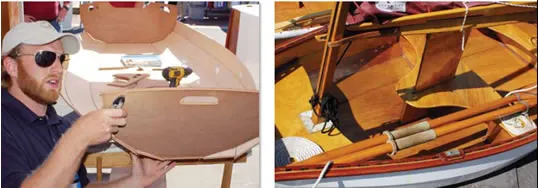
Designed in 1969, the Lasers first few years were anything but smooth sailing. Popularity grew quickly, but along with the limelight came plenty of consternation. Dubbed a surfboard not a sailboat by a growing cross-section of the yachting elite-many parents warned junior sailors to steer as clear of Lasers as they did sex, drugs and rock-n-roll. The campaign failed, and junior sailors in yacht club programs around the country fell into the grip of the new one-design dinghy-discovering the sailboats proclivity to plane.
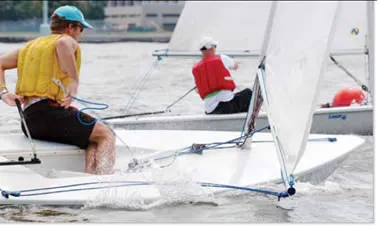
Dyer Dhows languished in boat sheds across the country as a new theme in sailing took hold. Dubbed fast is fun by sailor/engineer Bill Lee, the young Merlin of Santa Cruz, Calif., took the theme to big-boat sailing, merging California culture with the Laser logic of light displacement and planing hull shapes.
Best of all, the Laser embraced the ideal of a tightly controlled one-design class that put people on the water in identical boats and left winning and losing races up to sailing skill and tactics rather than a boats performance edge. For decades, the boat has been the single-handed sailors choice among junior sailing programs, and with the addition of the Radial, 4.7 and M rigs, smaller competitors have also found the boat to be a great sailing platform. Today, theres some lawyer saber-rattling over the sale of the design rights, but the boat remains more popular than ever.
The sleeved sail, two-part spar, daggerboard, and kick-up rudder make the boat a quick-to-rig and fast-to-get underway dinghy. Light-air efficiency is good for a one-design sailboat, but this means that as the breeze builds, the non-reefable sail can become a handful in a hurry. In fact, the boats Dr. Jekyll-and-Mr. Hyde demeanor is what builds talent among Laser practitioners. The big boys block the mainsail and blast off for the layline, while lighter sailors heavy-weather tactics include more nuanced de-powering and feathering. In light air, the tables turn, and the winner is often the sailor who planes quickest on the reaches. The old guards surfboard slam may have held some credence after all.
Bottom line: The Laser is a timeless classic thats easily transported and is built for performance. Its well suited to adrenaline-seeking teens as well as the more fit adult crowd.
Designed in 1947 by Floridian Clark Mills, the utilitarian Optimist could be made out of two sheets of plywood-and from its inception, the Optimist was meant to link kids with the water. Slipping into obscurity in the U.S., the little pram found fertile ground to grow in northern Europe. With just a few tweaks, the Scandinavians took Millss lines and parlayed them into whats become the favored junior sailing trainer for kids from Detroit to Timbuktu. Statistics show that there are about 30 builders worldwide putting out approximately 4,000 boats each year. With about 130,000 boats class registered and an estimated 300,000 total hulls built (amateur and pro), theres plenty of reasons to get excited about an Opti.
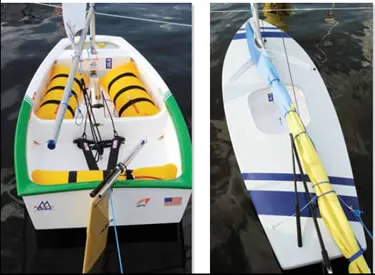
The example weve chosen is the USA-built McLaughlin boat, both a demonstration of high-quality FRP construction and modern manufacturing techniques. Its also a boat that can be purchased in a range of performance-inducing iterations-upgrades designated as club, intermediate, advanced, and professional versions. Like all performance sailboats, stiffness and strength-to-weight ratio is important. But class rules include a minimum weight, so the most competitive hulls meet the mandatory lower limit but use good engineering and building technique to reinforce the daggerboard slot and mast step and produce overall stiffness.
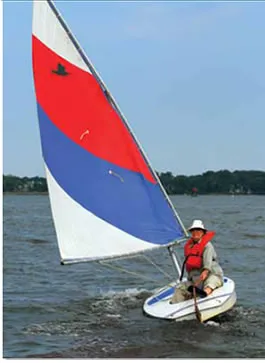
The low mast height and high aspect ratio sprit sail is very versatile, affording young (and small, 65 to 130 pounds) sailors a wide window of decent performance. The flat bottom, slab-sided hull is responsive to crew weight-driven trim changes, and the better the sailor, the more agile they become. Light-air performance is all about minimizing wetted surface and maximizing sail area projection. When the breeze starts to kick up, the sailor becomes the ballast, and the art of hiking, sheet handling, and tiller wiggling come into play.
Under careful adult supervision, two 6- to 8-year-olds can double-hand the friendly little dinghy, or one more-confident child can solo sail it. In fact, introducing kids to sailing with similar proportioned small prams has been a right of passage around for decades. A set of oarlock gudgeons can turn the pram into a functional dinghy thats also adaptable to the smaller Torqeedo outboard (www.torqeedo.com).
McLaughlin also markets a Roto-molded polyethylene version of the Opti and sells DIY kits for those who want to create their own wood version.
Bottom line: The Opti is like a first bicycle without the need for training wheels. The fact that at the last Olympics, over 80 percent of the winning sailors had gotten their start in an Optimist speaks well to the value of messing around in this particular dinghy.

Designed in 1951 by ice boaters Alexander Bryan and Cortland Heyniger, the hard chine Sunfish was the prototype board boat. In 1959, it made the transition into fiberglass, and over the following half-century, more than a quarter-million hulls would hit the water. Simplicity and decent sailing attributes combined with an attractive price to make the Sunfish the most popular one-design dinghy ever raced.
Far more than a platform for racers, these boats are an excellent training tool for sailors of all ages. Also built by Laser Performance, they reflect the fun of summer and put sailors in close contact with the water on which they sail. Its no surprise that the larger fleets coincide with warm water and many see going for a swim to be part and parcel of the low-freeboard experience.
The lateen rig is in keeping with the overall design concept and simplifies rigging. A short stub of a mast is stepped and a single halyard hoists the sail along with tilting V-shaped upper and lower booms.
The total sail area is nearly the same as the Laser, but the halyard hoist versatility of the lateen rig make it a handy beach boat and a little less daunting when the wind begins to build. The clean sail shape on one tack and deformation caused by the mast on the other tack are a slight drawback. The Laser rig is more efficient, but when caught out in a squall, its nice to be able to ease the halyard and dump the sail. Its also handy to be able to leave the boat tethered to a mooring, and the doused sail and short mast make it possible.
Multiple generations of sailors are often found sailing Sunfish, and the boat represents one of the best bargains to be found in the used boat market. When considering a pre owned boat, the potential buyer needs to take a close look at the daggerboard-to-hull junction and mast step, points where previous damage can create hard-to-fix leaks.
Bottom line: The Sunfish is a great beach boat that can turn a hot afternoon into a fun-filled water experience.
There were no losers in this group, and picking winners and runners-up proved a difficult task. The outcome had to be based on assumptions about how these boats would be used. For example, parents with a competitive 9-year-old who swims like a fish, always sprints for the head of the lunch line, and likes to steal bases in Little League probably have an Opti racer in the making. Less competitive junior sailors-future cruisers in the making-will do better learning aboard a Bug. Many newly formed sailing clubs target the boat as their trainer of choice.
The Bravo holds plenty of appeal for those with a lakeside cottage or a favored campground destination. Whether its a solo sail just before sunset or a fun race on Sunday, the quick to set up and put away features are a plus, and for those who feel that two hulls are better-the Bravo will hold plenty of appeal.
Serious competitors can campaign a Laser for life, and whether youre headed for a local district regatta or getting ready for the Olympic trials, the hull, rig, and sail remains identical-sort of like the Monaco Grand Prix being raced in a street legal Mustang.
Bic Opens new little speedster tickled our fancy, and as a trainer/performance boat crossover, it drew a strong nod of approval. Watching the junior sailors smiles as they sailed their Open Bics endorsed our opinion.
And if there is any boat that defines the essence of summer, the Sunfish takes the prize.
- The Art of Building with Thermal-setting Plastics
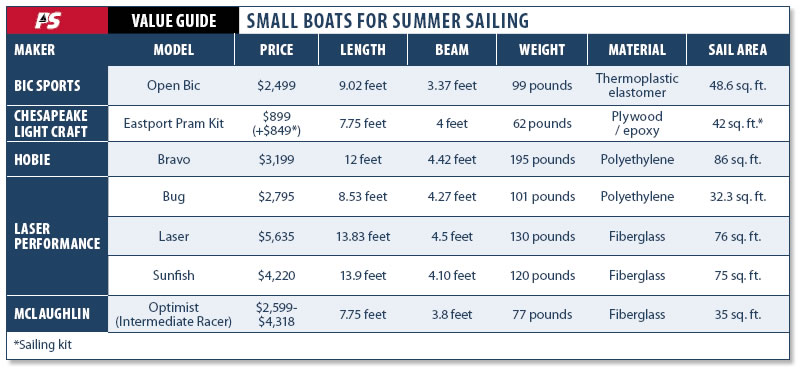
- Youth Safety Gear Top Picks
- Chesapeake Light Craft
- Hobie Cat Co.
- Las er Performance
- McLaughlin Boat Works
RELATED ARTICLES MORE FROM AUTHOR
Leave a reply cancel reply.
Log in to leave a comment
Latest Videos
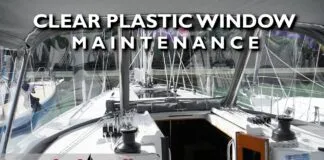
What’s The Best Vinyl Window Cleaner for Your Boat?

40-Footer Boat Tours – With Some Big Surprises! | Boat Tour

Electrical Do’s and Don’ts

Bahamas Travel Advisory: Cause for Concern?
- Privacy Policy
- Do Not Sell My Personal Information
- Online Account Activation
- Privacy Manager
- AROUND THE SAILING WORLD
- BOAT OF THE YEAR
- Email Newsletters
- Best Marine Electronics & Technology
- America’s Cup
- St. Petersburg
- Caribbean Championship
- Boating Safety

One-Design Showcase
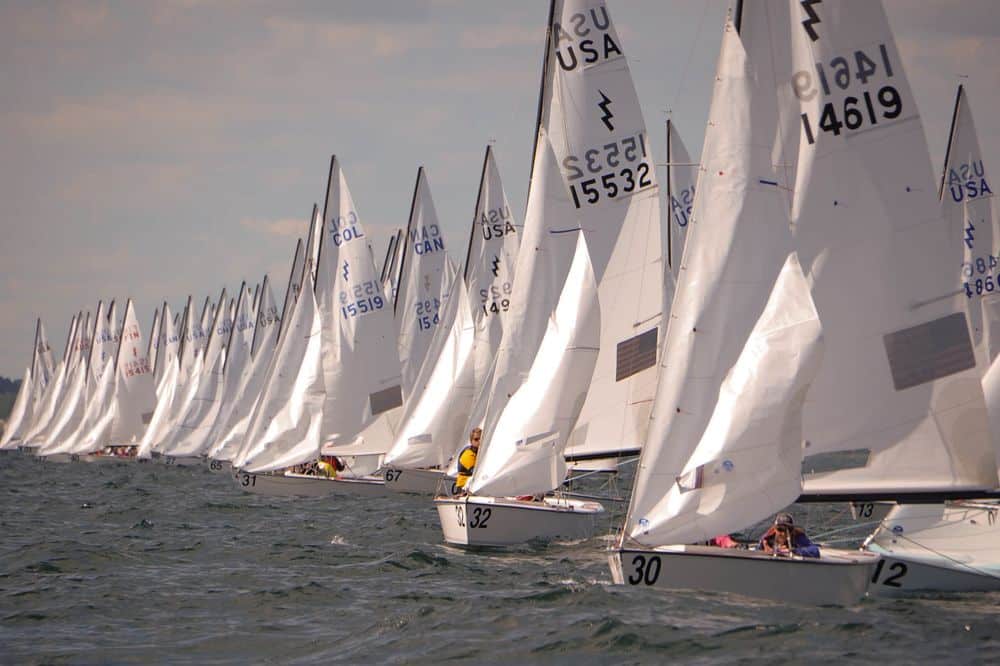
About the DN Iceboat
The Lightning offers a combination of performance and stability that eludes most one-designs. The Lightning’s hard chine and 130 lb centerboard give her the stability and power of a small keel boat going to weather in strong winds and allow her to carry a very large spinnaker for breathtaking off wind rides. The Lightning’s rig is simple, but offers sophisticated sail shape controls.
Our 19-foot trailerable centerboard sloop has evolved into one of the most popular and competitive one-design racing classes in the world. Awarded ISAF International Class status, the Lightning is sailed in more than 13 countries and in the Pan American Games, and the class provides a professionally-managed association that is among the largest in all of one-design sailing.
If you’re looking for a boat you can be proud to sail, one that offers dinghy handling with the performance of a sportboat, a refined design that’s free of fads, complete with the technology of today for both racing and daysailing – Get The Best Of Both Worlds. Get into a Lightning.
Class Information:
Class Contact: Laura Jeffers, Executive Secretary
Class Contact Email: [email protected]
Class Contact Phone: 727-942-7969
Class Website: lightningclass.org
Social Media: Facebook | Twitter | Instagram | Youtube
Class Specs
LOA: 19 ft.
Beam: 6 ft. 6 in.
Draft: 4 ft. 11 in.
Weight: 700 lbs.
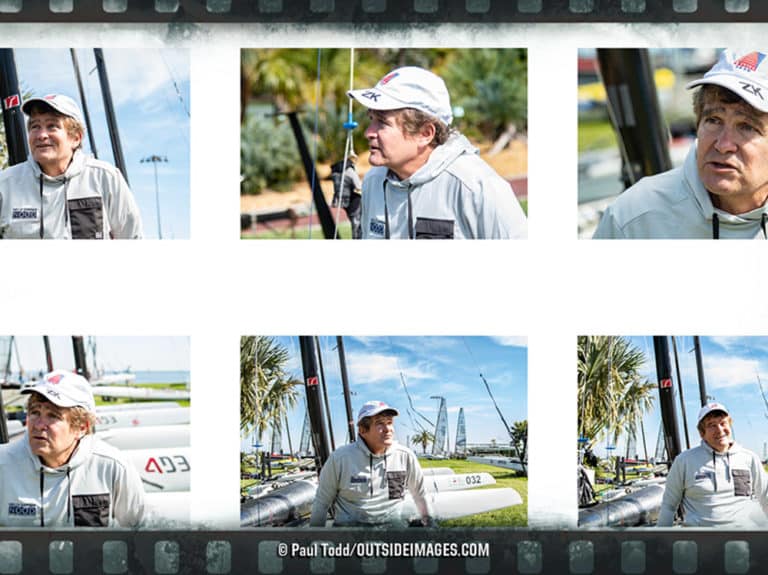
Spark Plugs: The A Class’s Emmanuel Cerf
At the Helly Hansen NOOD Regatta St. Petersburg, the mover and shaker of the A Class catamaran fleet builds his world championship field of dreams.
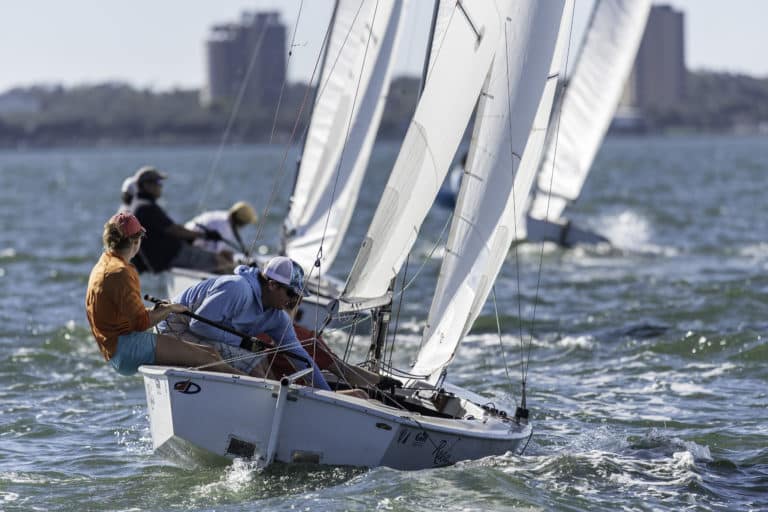
Snowbirds Descend Upon the Helly Hansen NOOD Regatta St. Petersburg
Tampa Bay locals have it good year-round, but it’s more fun when winter’s escapees come to play.
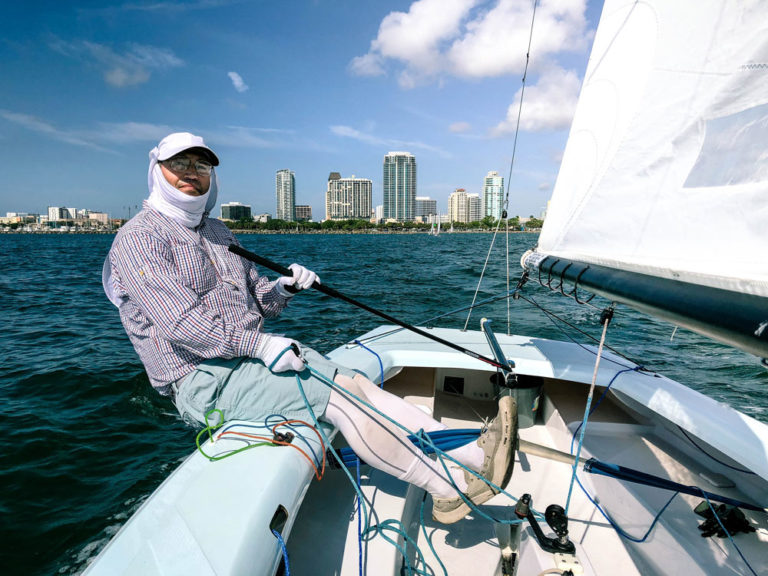
The Lightning Rod
The boat builder goes beyond family legacy in the Lightning Class, he’s bringing fresh energy to this vintage fleet.
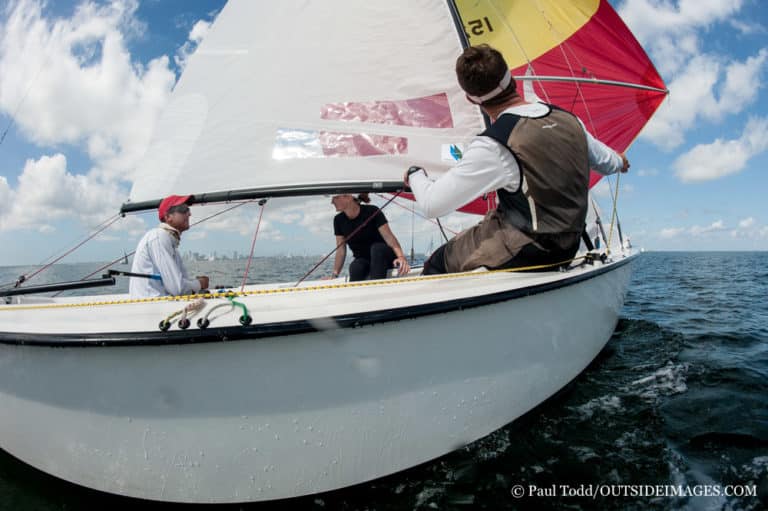
Inside the Class: Lightning
On the morning of the final race, we sat down with a Lightning class legend and the fleet’s next generation to see what they could learn from each other.

- Digital Edition
- Customer Service
- Privacy Policy
- Cruising World
- Sailing World
- Salt Water Sportsman
- Sport Fishing
- Wakeboarding

HARD CHINE AND MULTI CHINE PLYWOOD DESIGNS
We have found 17 items matching your search query..
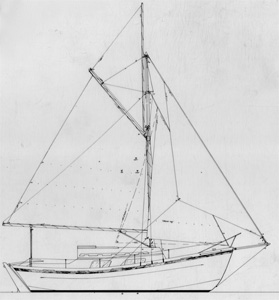
WHITE SQUAW
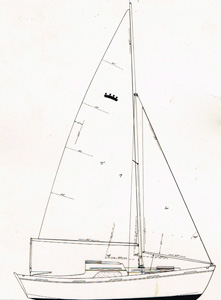
MAGELLAN CLOUD

DEBUTANTE IV
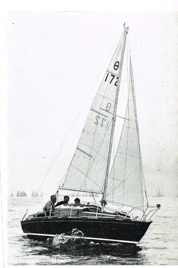
- Page 1 of 1
Basket Updated
Congratulations! Your basket has been updated, what would you like to do now?
What Is a Chine on a Boat and What Does It Do? Guide to Care
When you look at a boat, it’s not just a beautiful vessel gliding through the water; it’s a masterpiece of engineering and design. Every curve, every angle serves a purpose. One essential aspect of boat anatomy that plays a significant role in its performance and handling is the chine. Have you ever wondered what a chine is and why it’s important to understand it as a boating enthusiast? In this article, we will delve into the intriguing world of boat design and explore the concept of a chine.
A chine is a fundamental element of a boat’s construction that impacts its stability, maneuverability, and overall performance on the water. Simply put, it is the intersection where the boat’s hull bottom meets its sides. This distinctive feature can be seen as a defined edge or change in angle along the boat’s hull. Understanding the purpose and function of a chine is crucial for anyone who wants to gain a deeper appreciation for boats and enhance their boating knowledge.
Why is it important to understand boat anatomy, including the chine? Well, think of it this way: just as a car enthusiast appreciates the intricacies of an engine or a cyclist understands the mechanics of their bicycle, boating enthusiasts should have a grasp of the components that make up their beloved watercraft. Knowing how a boat is designed and constructed not only enhances your enjoyment and appreciation of the boating experience but also allows you to make informed decisions when it comes to purchasing, operating, and maintaining your vessel.
In the following sections, we will explore the concept of a chine in more detail, including its types, benefits, and considerations for boat design. We will also discuss specific boat types that showcase unique chine designs and provide practical tips for chine maintenance and care. So, whether you are a seasoned boater or someone who is new to the world of boating, let’s dive into the fascinating world of chines and uncover the secrets they hold for optimizing your boating adventures.
What is chine on a boat and what is the purpose of it?
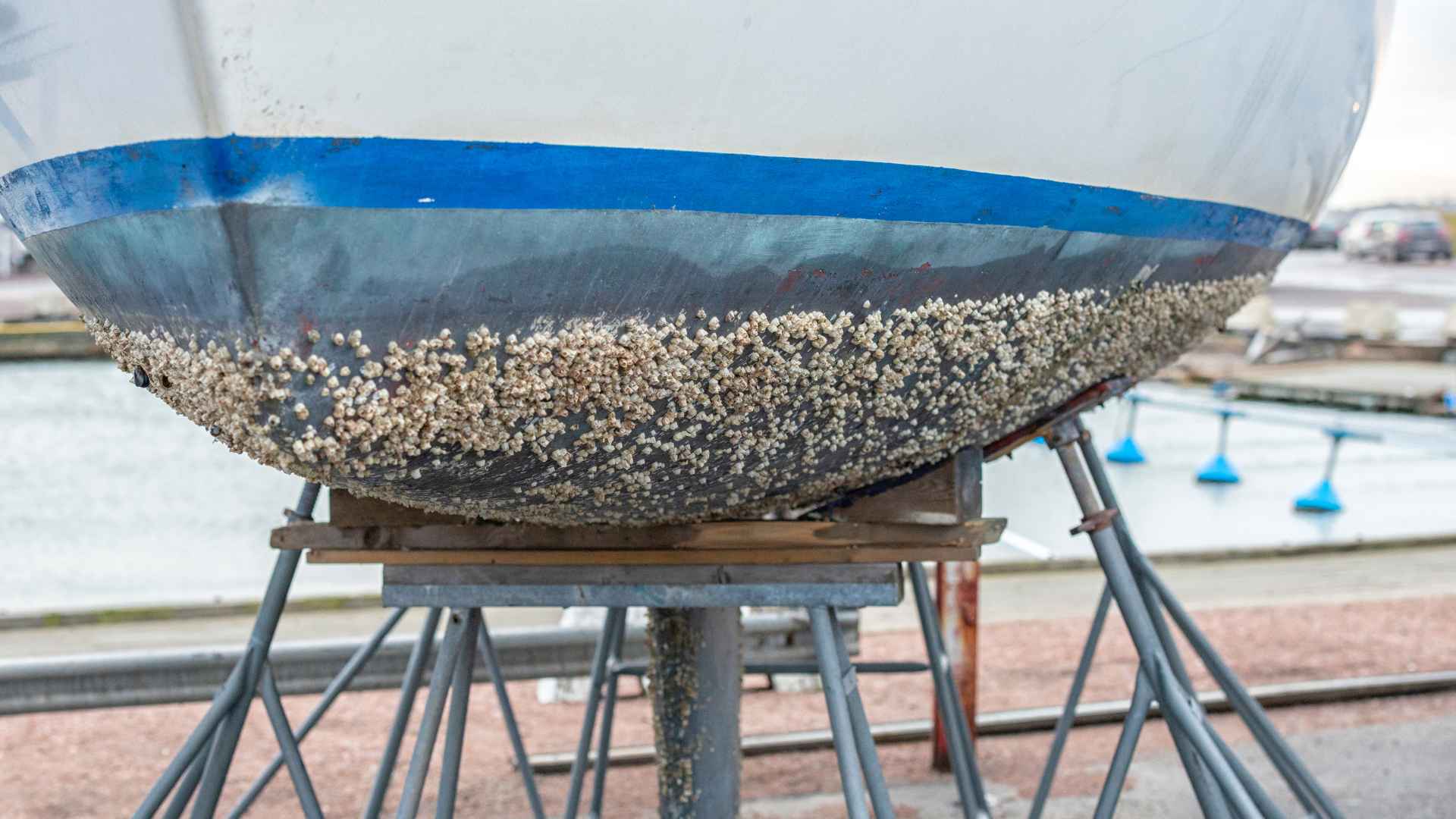
Definition of a Chine in Boat Design In the context of boat design, a chine refers to the distinct edge or angle formed at the intersection where the hull bottom meets the hull sides. It is a prominent feature that can be observed along the length of the boat.
Purpose and Function of a Chine on a Boat The chine serves several important purposes in boat design. Its primary function is to influence the boat’s stability, performance, and handling characteristics. The chine affects how the boat interacts with the water and plays a crucial role in shaping its behavior on the water.
How a chine affects the boat’s stability, performance, and handling?
- Stability: The chine significantly contributes to a boat’s stability, both at rest and in motion. It affects the boat’s resistance to rolling or leaning and helps maintain a balanced stance on the water. The shape and design of the chine can influence the boat’s ability to handle rough waters or challenging conditions.
- Performance: A well-designed chine can enhance a boat’s performance by improving its efficiency, speed, and handling characteristics. It can influence how the boat moves through the water, reducing drag and providing lift. The chine’s interaction with the water creates hydrodynamic forces that affect the boat’s overall performance.
- Handling: The chine plays a vital role in determining how a boat handles and responds to the helm. It affects the boat’s maneuverability, responsiveness, and ability to turn or corner. The design of the chine can influence the boat’s tracking, stability during turns, and overall handling characteristics.
It’s important to note that the impact of a chine on stability, performance, and handling can vary depending on the type of chine and the specific boat design. Different chine configurations, such as hard chines, soft chines, or multi-chines, offer unique characteristics and advantages based on the intended use and boating activities.
Understanding the purpose and function of a chine in boat design is essential for boating enthusiasts. It allows for a deeper appreciation of how a boat interacts with its environment and how design elements contribute to its overall performance and handling. In the next section, we will delve into the different types of chines commonly found in boat designs and discuss their characteristics and advantages.
What are the different types of chines commonly found in boat designs?
Different Types of Chines Found in Boat Designs Boat designs can feature various types of chines, each with its own characteristics and advantages. The most common types include hard chines, soft chines, and multi-chine configurations.
1. Hard Chines
Hard chines are characterized by sharp, distinct angles formed at the intersection of the hull bottom and sides. These chines create a noticeable change in the hull shape and result in a flat or planing surface. Hard chines provide excellent stability and lift, making them popular in powerboats, especially those designed for speed and efficiency.
They enhance the boat’s ability to plane on the water, offering good tracking and predictable handling. Hard chines can also increase the boat’s usable interior space, allowing for more volume below deck.
2. Soft Chines
Soft chines, also known as rounded chines, have a more gradual transition from the hull bottom to the sides, resulting in smoother curves. Unlike hard chines, soft chines offer a gentler, more forgiving ride.
They provide improved comfort, especially in rougher conditions, by reducing the tendency for the boat to slam or pound against waves. Soft chines are commonly found in cruising sailboats and displacement hull designs where comfort and seaworthiness are prioritized over speed.
3. Multi-Chine Configurations
Multi-chine configurations combine elements of both hard and soft chines. They feature multiple angles or facets along the hull, creating additional chines. These configurations provide a balance between stability and comfort, offering a compromise between the characteristics of hard and soft chines.
Multi-chine designs can enhance a boat’s stability at rest and in motion while maintaining a smoother ride compared to hard chines. They are commonly found in a variety of boats, including fishing boats, recreational powerboats, and certain sailboat designs.
Understanding the different types of chines allows boating enthusiasts to evaluate how each type aligns with their boating preferences, intended activities, and desired performance characteristics. The choice of chine type in boat design depends on factors such as the boat’s intended use, operating conditions, and the desired balance between stability and comfort.
What are the characteristics and advantages of each type of chine?
1. hard chines:.
Hard chines feature distinct, sharp angles where the hull bottom meets the hull sides. They create a flat or planing surface, resulting in a more angular hull shape.
Advantages:
- Stability: Hard chines provide excellent stability, both at rest and in motion. The sharp edges create a firm platform, making the boat less prone to rolling or leaning.
- Planing Efficiency: Hard chines enhance the boat’s planing ability by reducing drag and increasing lift. This allows the boat to achieve higher speeds more efficiently.
- Predictable Handling: The angular shape of hard chines improves tracking and offers predictable handling characteristics. This can be advantageous for activities such as racing or precision maneuvering.
- Increased Interior Space: The flat surfaces created by hard chines can increase the usable interior space of the boat, allowing for more storage or accommodations.

2. Soft Chines:
Soft chines have a smoother transition from the hull bottom to the hull sides, resulting in rounded curves and less pronounced angles.
- Comfort in Rough Conditions: Soft chines provide a more forgiving ride in rough waters. The rounded shape helps reduce the impact of waves, resulting in less slamming or pounding and increased comfort for passengers.
- Seaworthiness: The smooth curves of soft chines enhance the boat’s ability to handle choppy or challenging conditions, improving stability and reducing the risk of broaching.
- Reduced Resistance: The softer shape of chines minimizes drag, allowing the boat to maintain efficiency at lower speeds. This can be advantageous for cruising or long-distance voyages.
- Enhanced Bilge Support: The rounded shape of soft chines can provide additional buoyancy and support, particularly in displacement hull designs.
3. Multi-Chine Configurations:
Multi-chine designs feature multiple angles or facets along the hull, creating additional chines and a more complex hull shape.
- Balance between Stability and Comfort: Multi-chine configurations offer a compromise between the stability of hard chines and the comfort of soft chines. They provide a good balance for a variety of boating activities and conditions.
- Versatility: Multi-chine boats are versatile and can be suitable for various boating pursuits, including fishing, recreational cruising, and even racing, depending on the specific design.
- Improved Stability: The presence of multiple chines enhances stability, especially at rest. This can be beneficial for activities that require stability, such as fishing or water sports.
- Smooth Ride: Although not as forgiving as soft chines, multi-chine designs generally offer a smoother ride compared to hard chines, ensuring a comfortable experience for the occupants.
Understanding the characteristics and advantages of each type of chine allows boaters to choose a design that aligns with their specific needs, preferences, and intended boating activities. It is essential to consider the boat’s purpose, the operating conditions, and the desired balance between stability, performance, and comfort when evaluating different chine types.
What are the benefits of chines in boat design?

Chines in boat design offer several advantages that contribute to the overall performance and functionality of the vessel.
- Improved Stability: Chines enhance a boat’s stability, both at rest and in motion. They provide a wider stance and create additional buoyancy, reducing the likelihood of excessive rolling or leaning. This stability is particularly beneficial in rough waters or when performing activities that require stability, such as fishing or water sports.
- Increased Lift and Efficiency: Chines play a role in lifting the boat’s hull out of the water, reducing drag and increasing planing efficiency. The chines generate hydrodynamic forces that help the boat achieve higher speeds more easily, making it more efficient and fuel-efficient, especially in powerboats designed for speed and performance.
- Enhanced Maneuverability: Chines contribute to improved maneuverability and handling characteristics. They influence how the boat responds to steering inputs, allowing for more precise control and responsiveness. This is particularly valuable in situations that require precise maneuvering, such as docking or navigating tight spaces.
Address any potential drawbacks of chines, such as increased spray or reduced interior space
While chines offer numerous benefits, it’s important to consider potential drawbacks that may arise in certain situations or boat designs.
- Increased Spray: Chines can sometimes result in increased spray, especially in boats with hard chines. The sharp angles and flat surfaces of hard chines can cause water to be displaced more forcefully, leading to more spray. This can be a concern for those who prefer a drier ride or when operating in rough conditions.
- Reduced Interior Space: In some boat designs, particularly those with pronounced chines, the interior space may be compromised. The angular nature of chines can reduce the usable volume below deck or limit storage options. This can be a consideration for boaters who prioritize interior space or require ample storage capacity.
- Handling in Certain Conditions: While chines generally enhance maneuverability, they can also influence how a boat handles in specific conditions. For example, hard chines may have a tendency to “trip” or catch on waves during certain maneuvers, requiring careful handling. Soft chines, on the other hand, may exhibit a slightly different feel when cornering or turning, necessitating adjustment in technique.
It’s important to note that the potential drawbacks of chines can vary depending on the boat design, chine type, and individual preferences. Boat owners and enthusiasts should evaluate these factors in conjunction with their specific boating needs and priorities.
Understanding the benefits and potential drawbacks of chines allows boaters to make informed decisions when it comes to selecting a boat or assessing the performance characteristics of their current vessel. The next section will delve into important design considerations regarding chines and how they contribute to the overall boat design process.
How chine design factors into the overall boat design process?
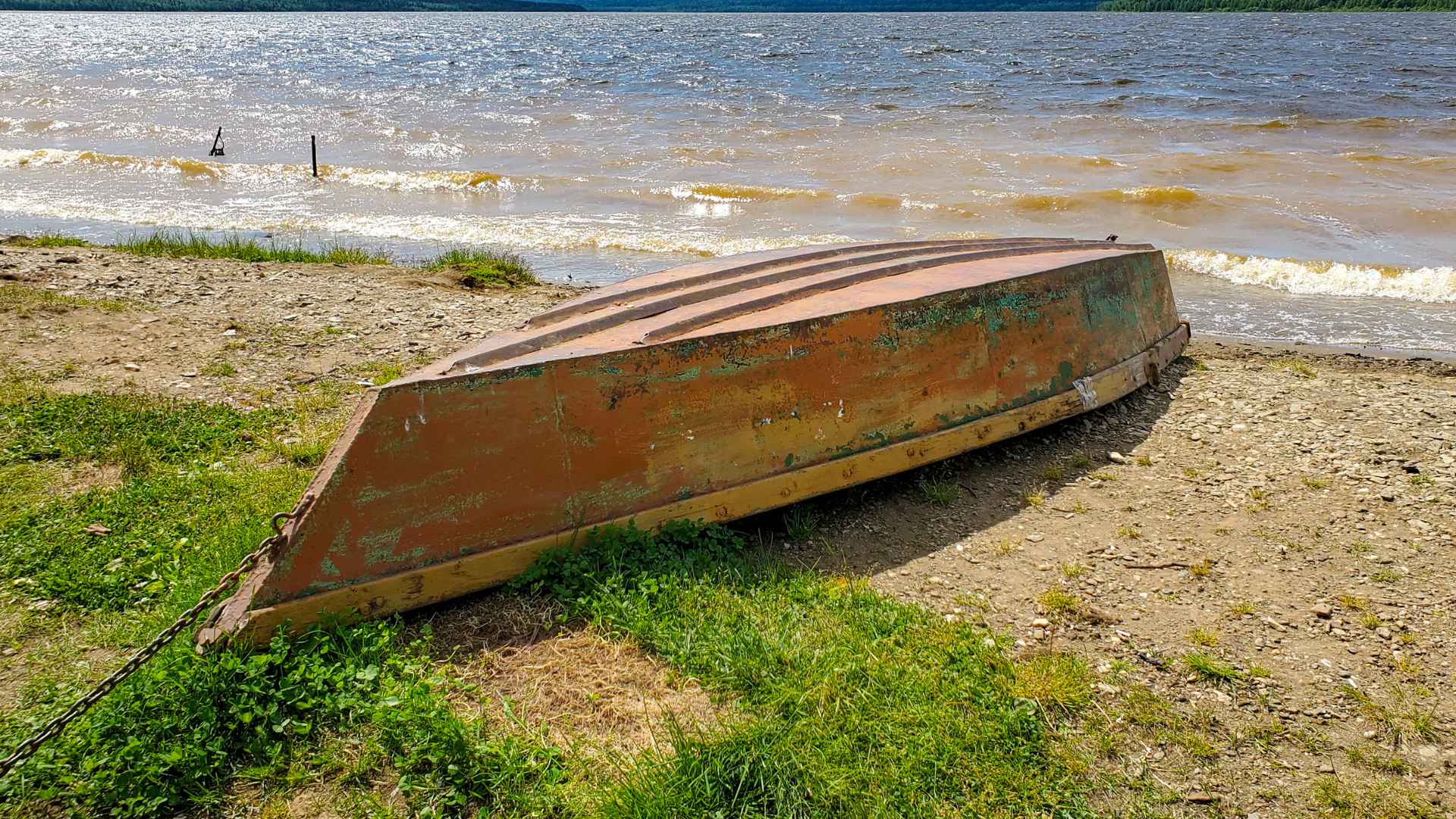
Chine Design in the Overall Boat Design Process Chine design plays a significant role in the overall boat design process, influencing various aspects of the vessel’s performance, functionality, and intended use.
- Performance and Handling: Chine design directly affects a boat’s performance and handling characteristics. The choice of chine type, such as hard chine, soft chine, or multi-chine, influences how the boat interacts with the water, its stability, maneuverability, and responsiveness to steering inputs.
- Stability and Seaworthiness: Chine design impacts a boat’s stability, both at rest and in motion. The shape and placement of chines contribute to the boat’s ability to maintain balance and resist excessive rolling or leaning. This is especially important for boaters who venture into rough waters or engage in activities that require stability, such as fishing or offshore cruising.
- Hydrodynamics and Efficiency: Chine design affects the hydrodynamics of the boat, influencing its efficiency, planing ability, and fuel consumption. The interaction between the chines and the water generates lift, reduces drag, and determines how the boat planes on the water’s surface. This consideration is particularly crucial for high-performance boats and those designed for speed or racing.
What is the relationship between chines, hull shape, and boat performance?
- Hull Shape and Chine Interaction: The shape of the hull, combined with the design and placement of chines, determines how the boat performs in different conditions. The hull shape influences factors such as speed, stability, maneuverability, seaworthiness, and comfort. Chines work in conjunction with the hull shape to optimize these performance characteristics.
- Balancing Stability and Performance: The selection of chine type and its integration with the hull shape involves finding a balance between stability and performance. For example, hard chines may offer excellent stability and planing efficiency, but they can result in a rougher ride in choppy waters. On the other hand, soft chines prioritize comfort and seaworthiness but may sacrifice some speed or efficiency.
How different chine designs are suited for various boating activities (e.g., fishing, cruising, racing)?
- Fishing: Boats designed for fishing often benefit from chines that offer stability at rest, a smooth ride in varying conditions, and good maneuverability for precise positioning. This can involve a combination of stability-enhancing chines, such as hard or multi-chines, along with softer chines to ensure comfort during long hours on the water.
- Cruising: Cruising boats prioritize comfort, seaworthiness, and fuel efficiency. Chines with rounded or soft contours are commonly used to provide a smoother ride, reduced spray, and increased comfort during extended voyages. These chines contribute to a more comfortable and predictable experience for those aboard.
- Racing: High-performance racing boats often feature hard chines that maximize planing efficiency, stability, and maneuverability. These chines enhance speed and allow for precise control, enabling racers to navigate tight courses and execute rapid maneuvers.
Design considerations for chines depend on the specific boating activities, performance requirements, and preferences of the boat owner. The choice of chine design should align with the intended use of the boat to ensure optimal performance and a satisfying boating experience. In the next section, we will provide examples of boat types known for their unique chine designs.
Let’s see examples of boat types that commonly feature specific chine designs.
Boat Types with Specific Chine Designs Different boat types often feature specific chine designs that are tailored to their intended use and performance requirements.
Fishing Boats:
- Flat-Bottom Chine: Some fishing boats, particularly those designed for shallow water fishing or angling in calm conditions, may feature a flat-bottom chine. This design provides stability at rest and allows for easy maneuvering in shallow areas.
- Modified V Chine: Many fishing boats utilize a modified V chine design, which combines the stability of a flat-bottom chine with the improved handling and ride quality of a V-shaped hull. This design offers a compromise between stability and efficiency, making it suitable for both inshore and offshore fishing.
Cruising Sailboats:
- Full-Length Chine: Some cruising sailboats incorporate a full-length chine design, which extends from bow to stern along the hull sides. This chine design helps improve stability, provides more interior volume, and increases the boat’s load-carrying capacity.
- Round-Bilge Chine: Cruising sailboats may also utilize a round-bilge chine design, which offers a combination of stability and comfort. The rounded shape of the chine contributes to a smoother ride, reduced slamming, and improved seaworthiness.
High-Performance Powerboats:
- Stepped Chine: High-performance powerboats often feature stepped chine designs. These chines include a step or discontinuity in the hull bottom, which reduces drag and improves planing efficiency. Stepped chines enhance speed and maneuverability, making them popular in racing or performance-oriented powerboat designs.
How different chines contribute to the characteristics of these boats?
- Fishing Boats: Chines in fishing boats enhance stability, allowing anglers to cast, reel in, and maneuver without excessive rocking or rolling. The specific chine design chosen for fishing boats prioritizes stability at rest, ease of movement, and precise positioning in various fishing conditions.
- Cruising Sailboats: Chines in cruising sailboats impact comfort, seaworthiness, and interior space. The selected chine design prioritizes a smoother ride, reduced slamming, and increased interior volume for comfortable and extended cruising.
- High-Performance Powerboats: Chines in high-performance powerboats focus on planing efficiency, speed, and maneuverability. The chosen chine design aims to reduce drag, enhance lift, and optimize the boat’s handling characteristics for high-speed pursuits.
Specific boat models or classes known for their unique chine designs
- Boston Whaler: Boston Whaler boats are known for their unique “unsinkable” design, which includes a hull with a pronounced V-shaped chine. This chine design enhances stability, contributes to a smooth ride, and provides increased buoyancy and flotation in case of flooding.
- Carolina Skiff: Carolina Skiff boats typically feature a modified V chine design, known as the “Carolina Flare.” This design provides excellent stability, enhanced lifting capabilities, and a drier ride, making it popular for fishing and inshore boating.
- Offshore Powerboats: Offshore powerboat classes, such as the offshore racing circuit, often incorporate stepped chine designs. These chines optimize planing efficiency, reduce drag, and enhance the boat’s performance and maneuverability at high speeds.
These are just a few examples of boat types and models that showcase unique chine designs and demonstrate how different chines contribute to their characteristics and performance capabilities. When choosinga boat, it’s important to consider the specific chine design and how it aligns with your intended use, performance requirements, and boating preferences.
Understanding the relationship between chine design and boat characteristics allows you to make an informed decision and select a boat that suits your needs. In the final section of this article, we will provide practical tips and guidelines for maintaining and caring for chines on your boat to ensure optimal performance and longevity.
Few tips and guidelines for maintaining and caring for chines on a boat.
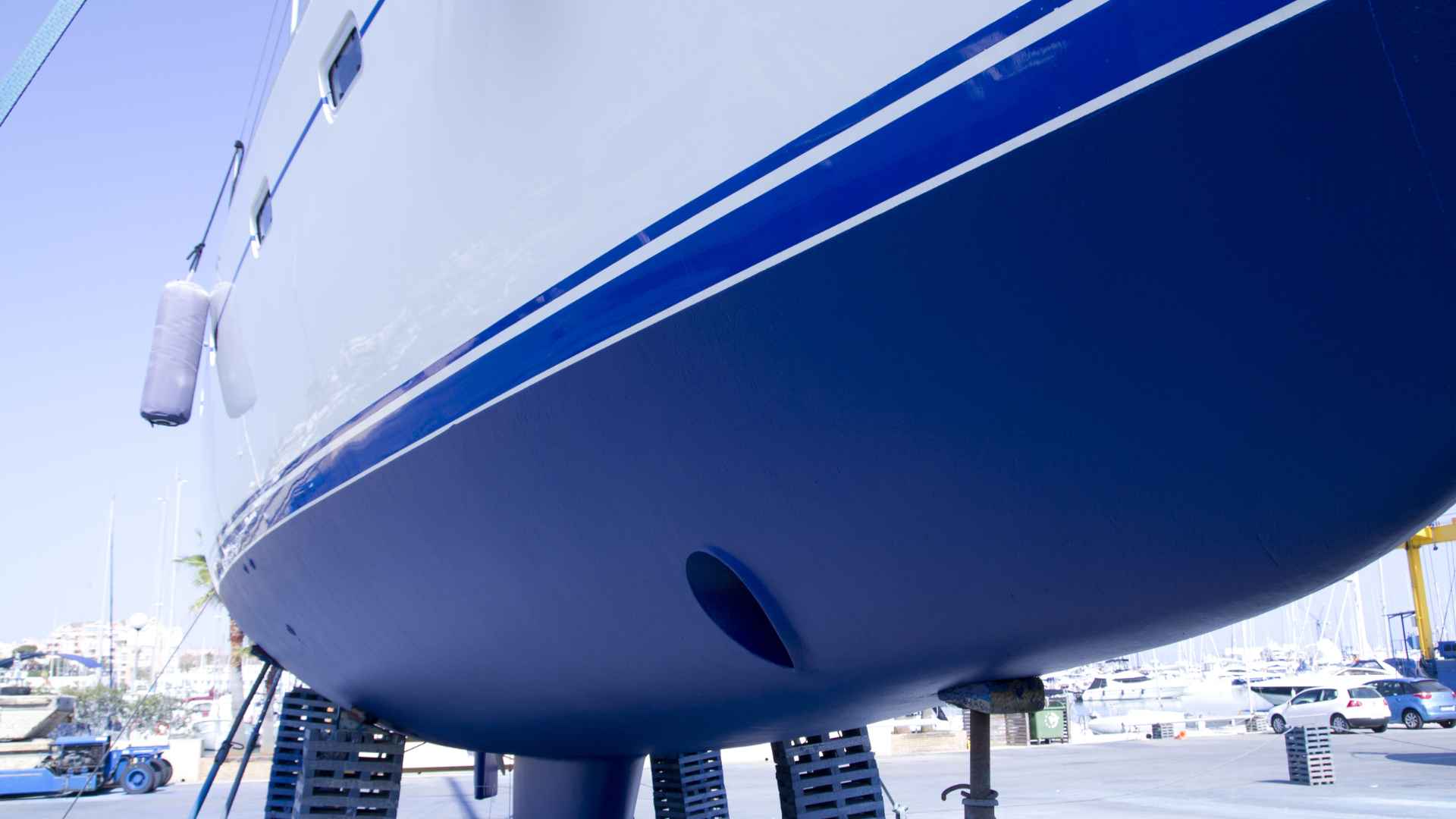
Proper maintenance and care of the chines on your boat are essential to preserve its performance, handling, and overall longevity. Here are some tips and guidelines to help you maintain and care for the chines:
- Regular Cleaning: Clean the chines as part of your routine boat maintenance. Remove any dirt, debris, or marine growth that may accumulate on the chines using a soft brush or sponge.
- Use Mild Cleaners: Use mild boat cleaners or soapy water to clean the chines. Avoid harsh chemicals or abrasive cleaners that may damage the hull or chine surfaces.
Inspection:
- Visual Inspection: Periodically inspect the chines for any signs of damage, such as cracks, scratches, or excessive wear. Look for any indications of impact or stress on the chine surfaces.
- Check Fastenings: If your boat has a chine that is secured with fastenings (e.g., screws or bolts), ensure they are tight and in good condition. Replace any loose or corroded fastenings promptly.
Repairs or Modifications:
- Address Damages Promptly: If you notice any damage or issues with the chines, such as cracks or significant wear, address them promptly. Consult a professional boat repair service or a boat manufacturer for guidance on repairs or modifications.
- Seek Professional Assistance : For complex repairs or modifications to the chines, it is recommended to seek the expertise of a qualified boat repair professional. They can assess the damage and provide appropriate repair solutions.
Regular Maintenance:
- Keep the Boat Protected: Use protective measures, such as boat covers or marine-grade wax, to shield the chines from UV rays and environmental elements when the boat is not in use.
- Regular Hull Maintenance: Follow a regular hull maintenance routine, including cleaning, waxing, and applying anti-fouling paint to protect the chines and the entire hull from corrosion and marine growth.
- Follow Manufacturer Guidelines: Consult the boat’s manufacturer or user manual for specific maintenance guidelines and recommendations related to the chines.
Regular maintenance is crucial to preserve the boat’s performance, handling, and longevity. By taking care of the chines, you ensure that they remain structurally sound and perform optimally. Neglecting maintenance can lead to increased wear, reduced stability, and potential water ingress, compromising the boat’s overall performance and safety.
Remember to consult professionals when necessary and adhere to manufacturer guidelines for your specific boat model. By properly maintaining and caring for the chines, you contribute to the long-term enjoyment and value of your boating experience.
Watch Extreme downturn chine (reverse chine) | Video
Top 5 FAQs and answers related to what is a chine on a boat
What is a chine on a boat.
A chine on a boat refers to the distinct edge or angle formed at the intersection where the hull bottom meets the hull sides. It is a prominent feature that can be observed along the length of the boat.
What is the purpose of a chine on a boat?
The primary purpose of a chine is to influence the boat’s stability, performance, and handling characteristics. Chines affect how the boat interacts with the water and play a crucial role in shaping its behavior on the water.
How does a chine affect a boat’s stability?
Chines contribute to a boat’s stability by providing a wider stance and creating additional buoyancy. The shape and design of the chine influence the boat’s resistance to rolling or leaning, helping it maintain a balanced stance on the water.
Does the type of chine design impact boat performance?
Yes, the type of chine design has a significant impact on boat performance. Different chine designs, such as hard chines, soft chines, or multi-chine configurations, offer unique characteristics and advantages. They influence factors like stability, efficiency, speed, maneuverability, and comfort.
How do chines affect a boat’s handling?
Chines play a vital role in determining how a boat handles and responds to the helm. They influence the boat’s maneuverability, responsiveness to steering inputs, and ability to turn or corner. The design of the chine can impact the boat’s tracking, stability during turns, and overall handling characteristics.

Throughout this article, we have explored the concept of chines in boat design and their significance in the boating world. Let’s recap the key points discussed:
- Chines are the distinct edges or angles formed at the intersection of the hull bottom and sides of a boat.
- Chines play a crucial role in boat design, influencing stability, performance, and handling characteristics.
- There are different types of chines commonly found in boat designs, including hard chines, soft chines, and multi-chine configurations, each offering unique advantages.
- Hard chines provide excellent stability, increased lift, and predictable handling, making them popular in powerboats.
- Soft chines offer a smoother ride, improved comfort, and enhanced seaworthiness, prioritizing comfort in cruising sailboats.
- Multi-chine configurations strike a balance between stability and comfort, making them versatile for various boating activities.
- Chine design factors into the overall boat design process, impacting performance, handling, and the relationship between chines, hull shape, and boat characteristics.
- Different chine designs are suited for specific boating activities, such as fishing, cruising, or racing, based on their performance characteristics.
- Proper chine maintenance and care are essential for preserving a boat’s performance, including regular cleaning, inspection, and addressing any damages promptly.
Understanding chines is crucial for boating enthusiasts, as it allows for a deeper appreciation of boat design and informed decision-making when evaluating, purchasing, or operating boats.
In conclusion, understanding chines in boat design is vital for boating enthusiasts, whether you are an experienced boat owner or someone new to the boating world. Chines have a significant impact on a boat’s stability, performance, and handling, influencing your overall boating experience. By considering chines when evaluating, purchasing, or operating boats, you can choose a design that aligns with your preferences, intended use, and desired performance characteristics.
So, as you embark on your boating adventures, remember to pay attention to the chines and their role in boat design. Explore the different types of chines, assess their benefits, and consider how they contribute to the specific characteristics you desire in a boat. With this knowledge, you’ll be equipped to make informed decisions and truly appreciate the intricacies of boat design. Happy boating!
Share What Is a Chine on a Boat and What Does It Do? Guide to Care with your friends and Leave a comment below with your thoughts.
Read What Are the Parts of a Sailboat and What They Do? Guide until we meet in the next article.
Similar Posts

How to Dock a Pontoon Boat Like a Pro?
The gentle lapping of water against the hull, the sun-kissed breeze on your face, and the laughter of friends and family—it’s no wonder pontoon boating is a cherished pastime. But amidst all the tranquility, there’s a skill that every pontoon boat captain must master: docking. Picture this—you’re returning from a day of leisurely cruising, and…
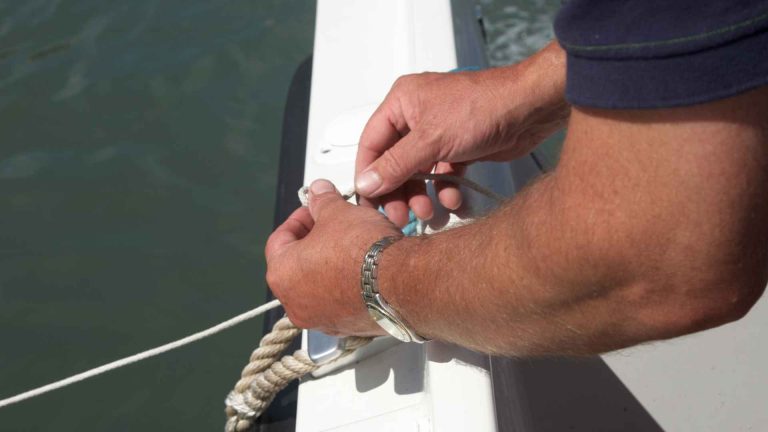
How to Tie a Boat to a Dock with Tides in 9 Steps? Guide
Tying a boat to a dock is an essential skill for any boating enthusiast. However, when tides come into play, it adds a whole new level of complexity to the process. Understanding tides and their impact on boat docking is of paramount importance to ensure a safe and successful docking experience. Additionally, employing proper boat…
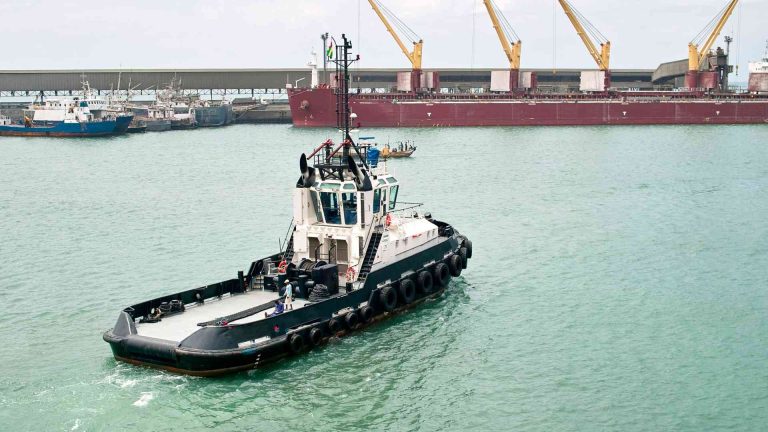
How Much Does a Tugboat Captain Make? Guide
The vast expanse of the world’s oceans holds an intricate network of marine transportation, where immense vessels navigate through challenging waters. At the heart of this maritime world stands the indispensable figure of the tug boat captain. These skilled professionals are entrusted with the crucial responsibility of guiding and maneuvering these mammoth vessels, ensuring smooth…
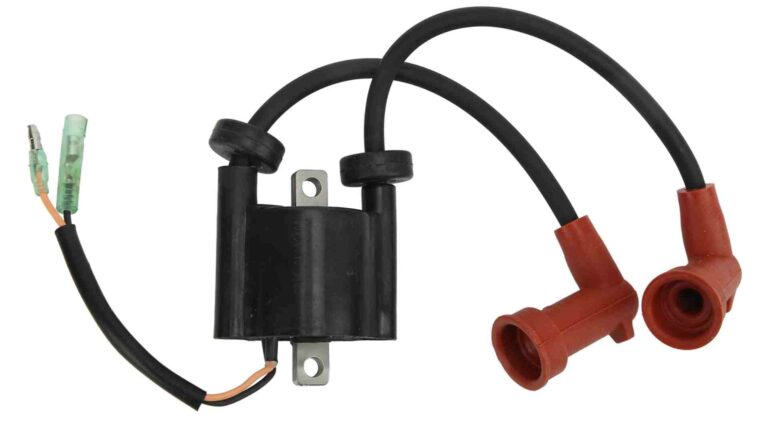
5 Symptoms to Detect a Faulty Outboard Ignition Coil
Outboard engines are the heart of many marine adventures, providing reliable power for boaters around the world. However, even the most robust engines can encounter issues, and a faulty ignition coil is a common culprit. In this comprehensive guide, we’ll explore the symptoms that can help you detect a malfunctioning ignition coil in your outboard…
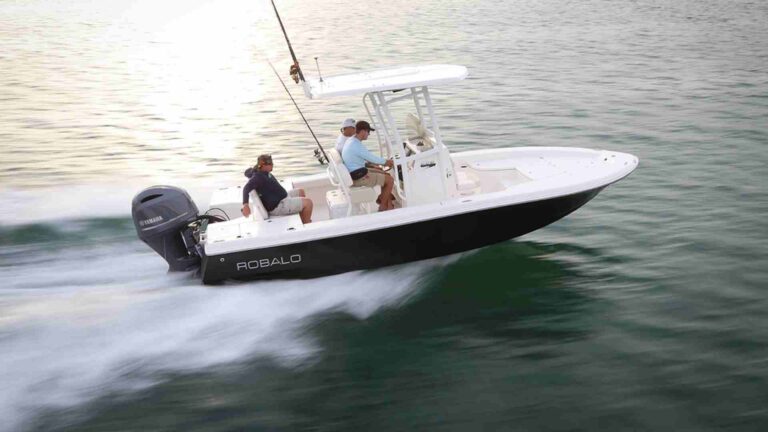
4 Most Common Problems with Robalo 226 Cayman Boat
The Robalo 226 Cayman: a sleek, sporty cuddy cabin renowned for its fishability, family-friendly features, and offshore prowess. But even these saltwater champions can develop gremlins that can turn your dream day at sea into a frustrating ordeal. Fear not, fellow captain! By understanding the most common problems Robalo 226 Caymans face, you can be…
![How to Store Fishing Rods in Boat Securely? [Effective Way] How to Store Fishing Rods in Boat Securely? [Effective Way]](https://boatsgeek.com/wp-content/uploads/2023/08/5-74-768x432.jpg)
How to Store Fishing Rods in Boat Securely? [Effective Way]
The tranquil dance of waves, the anticipation of a bite, and the thrill of reeling in a prized catch – fishing encapsulates the essence of serenity and excitement. Yet, amidst the allure of open waters, one crucial element often remains unsung: the art of securing and storing fishing equipment on a boat. The symphony of…

- Forum Listing
- Marketplace
- Advanced Search
- About The Boat
- Sailboat Design and Construction
- SailNet is a forum community dedicated to Sailing enthusiasts. Come join the discussion about sailing, modifications, classifieds, troubleshooting, repairs, reviews, maintenance, and more!
Hard Chines
- Add to quote
I have been seeing a number of sailboats with hard chines. What are the advantages or disadvantages of hard chines? I can see where longitudinal strength may be increased but what about sailing characteristics. It would seem to make the boat stiffer but I'd love to hear from someone who knows a little about design.
Faster said: Have you been following the 'Interesting Sailboats' thread? Plenty of discussion on all the 'new' designs, many of which have varying degrees of the chine approach. Must be something to them, the chines are working their way forward recently.. but for me it's hard to imagine that the vestigial 'chine' that you see on some Jeanneaus, e.g., would make much of a difference.. Paulo (PCP) will disagree with me on this..l. ... Click to expand...
Hard chines are a plus on shallow draft boats if I'm m not mistaken.
Thanks Faster I will take a look at that thread. I agree I dont see where some chines will make any difference
Fast mentions the Thunderbird ..... I have always been under the impression that hard chines as per the TBird were simply to make it easier and cheaper for the home builder. Our old VDS34 was multi chine in steel. Other VDS34s in cold moulded timber or glass were round bilge. Still and all I'm guessing the OP was talking about the chines apparent on more modern designs such as the Jeanneau Paulo posted rather than antiques like the TBird or VDS34.
Do not generalize about chines. Do not assume they are doing the same thing on different boats. The chines on a lightweight flyer and not there for the same reason they are on a Bentaeu mom and pop boat. On some boats chines are for performance. On other boats chines are for volume and have almost zero effect on performance. They look trendy and fool some people. On some boats chines are as effective as a spoiler on the trunk lid of an old Toyota.
The chines on the boat in your pic are there for volume. Look at the way that corner is digging in at the transom; That is textbook SLOW! That boat would be faster without that chine. They can get the stability they need with the right keel. That chine is all show and volume. Of course it "helps" stability. Any extra volume outboard aft will help stability. But that photo is the perfect example of a chine slowing a boat down. Heavy boats don't need chines.
Bob, not in this case, I mean volume. That boat has nothing except storage on the aft part of the boat (no aft cabins). The extra small volume would serve no purpose. The chines are there to limit heeling. That (and other similar boats) are designed to sail with very low heeling angles. The wives like that. Also to make very easy and safe downwind sailing. I agree that the the chines are not there for speed but even so that boat surprised many, include me by having a good sailing performance. Regards Paulo
Paulo: Could you dig up a photo of a VOR boat with chines blasting along at planing speed? I'd like to show a photo of chines working and you are so much better at research then I am.a
Perfecto Faster! Look how that stern is not digging in. Look how the water is streaming straight off the run and leaving the transom edge free and clear. This boat is performing like a high powered powerboat. It's planing with the power from it's huge rig driving a light hull with minimal rocker and chines. Chines help keep the buttocks flat. Your mom and pop cruising boat doesn't perform like this. It's too heavy, has too much rocker and too small a rig. If you wanted a very efficient 40' powerboat that maybe used a 35 hp diesel you would be operating in the same or similar performance realm as a mom and pop sail boat. I tank tested two hulls for such a high efficient powerboat. The client wanted to operate at 12 to 16 knots. Unfortunately that was well above the displacement hull speed of 8.26 knots. I designed two hull and two models were built, $9,000 USD per model. One model had a round bilge and the other had chines. My client spent over $50,000 on tank testing. At displacement speeds the round bilge model behaved beautifully. But above 10 knots things began to go wrong. By 14 knots the stern had sunk, the boat squatted and threw up a huge wake. The chine model worked OK at low speed but not as well as the round bilge model. More drag and more resistance at low speed was the peroblem. But once we got above 14 knots the chine hull was immensely more efficient. It just took a lot of horsepower. 16 knots was easy. We eventually got that hull to 20 knots. If you asked for a 40' power boat and you would be satisfied with hull speed, 8.5 knots, the best shape might be a double ender, the exact polar opposite shape to a chined hull. This is where most mom and pop boats operate, i.e. at or below displacement hull speed. I reviewed three new, modern European models last month for SAILING Two had chines. The boat without a chine was in almost every way a similar boat to the other two, just no chines. The no chine boat was designed by the Farr office. I am inclined to think they got it right.
Pauol: Yes, volume aft will increase stability every time. Sometimes a stiffer boat is a faster boat. But I look at that rooster tail fountain of water shooting up from that tranbsom and to me that does not look like the shape of speed. I agree with you, everyone likes a stiff boat.
Paulo: When I was doing those last three reviews I went on line and read a sailing report for one of the boats published by an English magazine. They claimed that the boat was fine until about 15 degrees of heel. Then the chine was immersed and they had a hard time past that point keeping the boat from rounding up. I think that can be a problem with any boat with an ultra wide stern. I've seen it myself. I was wondering what you thought of this. Do you think it is more of a problem consitant with this type of beamy, chined hull when pushed hard?
The boat reviewed was the Jeanneau Sun Odessey 349. But I have very little faith in the accuracy of sailing reports in magazines. They can hardly come down hard on boats that they advertise. I take them all with a grain of salt. US mags are the very worse. I've raced pretty much all my life. I know what it takes to drive a boat to weather. If someone tells me to restrict the heel angle upwind to less thean 15 degrees I would get very suspicious. You cannot get the most of a boat driving to weather with heel angle restricted to 15 degrees. That would be nice if popssible but it very seldom is possible. If you are talking about mom and pop loafing along and taking it easy I understand. If you are telling me that's how you get the most performance out of a boat I don't understand. Of course if you can pile fifteen 200 lb. crew members on the rail you might have something. I like the Pogo's but I'm pretty sure they do not fit my description of a "mom and pop" boat. I'm thinking more like the Sun Odessey, Dufour 410 or the Bavaria Cruiser 51. That was the group I reviewed.
bobperry said: The boat reviewed was the Jeanneau Sun Odessey 349. But I have very little faith in the accuracy of sailing reports in magazines. They can hardly come down hard on boats that they advertise. I take them all with a grain of salt. US mags are the very worse. ... I'm thinking more like the Sun Odessey, Dufour 410 or the Bavaria Cruiser 51. That was the group I reviewed. Click to expand...
bobperry said: Paulo: The information is all in my last post. Read slowly. The boat review was the Sun Odessey349. Don't recall the publication but it was English. I think they generally do the best and most honest job. But I don't speak French, Spanish or Italian. I do quite well with Mandarin though. Sun Odessey 349 was the bopat reviewed. The Bavaria is ther Farr desin and I said one boat has no chiones and that boat is the Farr design. The Farr designed Bavaria has no chines. Clear? Click to expand...
Paulo: Thanks, you are correct. It was a the review of the Dufour I wasa referring to. It was some time ago and I had forgotten. I usually would not read a sailing review because as I said I don't trust them, but in this case the information I received from Dufour did not included the designer's name so I was hunting around on the internet. Yes, that is a terrible review full of misinformation.
Tanks Bob. You have strong but honest opinions. That is quite rare on internet forums. I try to do the same. Regards Paulo
"You have strong but honest opinions." Thanks Paulo. I try not to be rigid. I like to think I am always ready to learn new things. I get annoyed when bad or just plain wrong information is passed off as fact.
Bob, some more food for thought: This discussion led me to look at the subject with more attention. Regarding chines I had already seeing designers defending them in what regards absolute gains in speed but I like pragmatism and reality over theory and it is so simple as this: If chines represented an effective gain in speed, in what regards top racing and top racing designers, everyone would be using them. Of course as it is a relatively new thing and the gains are small it would take time to spread but it will spread inevitably to all, otherwise even small that difference would make the boats less competitive. So, I had a look at top racing boats and new designs and a separation appears very clearly: Practically all solo boats, boats that are to be sailed with short crews or offshore over huge distances, extensively even with a crew, have them. Many, maybe even most, of the top regatta crewed boats don't have them even if recent designs. For instance the TP 52 don't have them or many of Ker Reischel and Pugh or Mills very recent designs. This leads me to consider very probable that the theory regarding gains in speed is not an absolute one and that the superior control of the boat in what regards easiness of sailing is much more at stake here. On a solo boat or in a boat sailed day and night in harsh conditions a more easy to sail boat can translate in a faster boat while on a regatta with a full crew it is possible to have the concentration and skill to dispense that easiness in what regards top performance meaning that even if it is much more dificult to sail (but slightly faster) a top sailor's crew will be able to go faster. Looking at the subject this way it is clear why it makes sense to use chines on cruising boats, since it as not to do with absolute speed but mostly with a better and easier boat control. It is not by accident that the improvements in rigging and design coming from open solo racers are the ones that have a more direct and faster utilization on cruising boats. Like on solo racers on cruising boats easiness is a very important characteristic in what regards sailing. Regards Paulo
bobperry said: ...... When a design feature becomes "fashionable", i.e. the spoiler on the Toyota, it's easy to find reasons why it make sense and is a worthwhile feature. None the less the choice of this feature is first driven by fashion. Of course the spoiler on the Toyota works. To a degree it works. Does it make the Toyota a better car? No. It's still a Toyota. It's just heavier now. Maybe some day in the future we'll look back and say, "Remember when we put chines on boats?" I've sailed under CCA, PHRF and IOR. I have seen a lot of features we thought made sense come and go. They seem right at the time. .. Click to expand...
Bob - let's see if I got this right. For a light boat with favorable D/L chines and wide stern with twin rudders may make good sense. For a cruiser ( your mom and pop boat) carrying significant weight in stores and fluids not so much. With chines one does get extra space but at a possible penalty of possible increased wetted surface in light air with decreased performance but decreased wetted surface and possibly a smoother run once boat is at its ideal degree of heel. With decreased rocker ride might be effected but downwind speed improved. Whereas traditional boats were very concerned about diagonals and non turbulent runs now concern remains about turbulence but parasitic drag and decreased wetted surface are modified by decreased water plane on heel produced by chined design. Am I close to getting the basics?
Out: I think you are spot on. For every condition and every type of boat there is an ideal shape. But we don't sail in a world with one "ideal" condition. One day it's upwind and the nexct day its downwind. The designer has to balance the desirable and undesirable characteristics of each type to come up with a good all round performer within the type. The best shape for a heavy boat will not be the best shape for a light boat. The best shape for a high powered boat will not be the best shape for a boat with a modest rig. One can only dream it was that easy.
I was not implying that rating formulae have anything to do with Mom and Pop chine boats. I was implying that some features make sense at a point in time when over time they are proven to be worthless or even detrimental. I have designed boats to several rules I am very familiar with how rating rules work. The Toyota spoiler example I used to show that while in reality the spoiler on the little Toyota is usless and just adds weight they put it there anyway. Why? Marketing. Fashion! On some of te Mom and Pop chine boats you post I woud be you that if I took (hypothetically) a big disc grinder and ground off chines you would not be able to tell the difference in feel or performance. I would not say that about all chine boats. I try not to generalize. But for some markets fashion is very important and in some cases I think this accounts for the chines.
- ?
- 173.9K members
Top Contributors this Month
Log in or Sign up
You are using an out of date browser. It may not display this or other websites correctly. You should upgrade or use an alternative browser .
Chine and stability
Discussion in ' Stability ' started by crowsridge , Mar 24, 2012 .
crowsridge Senior Member
Hello, So, my sons want a boat. Smaller sled, 15'. Jet. I want to have a very stable boat, but Im seeing conflicting info. One builder says a round chine is best. Then I see a sharp chine and still another reverse chine. I lean towards the reverse chine but would love youre educated input. Thanks, Chris
Petros Senior Member
Do not shop for a boat based on hard chine/round bilge thinking one is more stable over the other. You were misinformed. The design of the hull/cg height and other factors has more effect on stablity than hard chine or round bilge. You can get a bit more stablity with hard chines of identical hulls, but no two brands are identical, other factors have FAR more influence than chine/no chine. A good designer can make a hard chine hull behave identical to a round bilge one by trading off other design features. Usually a fast planing hull will come up on plan much faster with hard chines, and that is why there are used. If you are getting a heavy and slow boat, you will never come up on plane so rounded hull forms will have less drag. Primary stablity is what the designer choose, no matter the hull form they might use based on ability to plane and/or construction method. It really depends on your intended use and how much you want to compromise any or all of your desired performance ideals. Best to go try as many out at a local on-water boat show to get a better feel for how they behave. Buy based on the performance/bahavior you want, not on hard chine vs. round bilge. Good luck.
Sorry, I left out a part of info I see. I am looking at plans for building this boat. One build i saw here was a sheet of aluminum that was formed with a roller and break. First stage looked like a flat bottomed U then capped the stern and curved the bow up and towards the center. He claimed the wide roumd chine made it stable. A garvey style is a harder edge and the the Boston Whaler style have reverse chine. Sorry, I never think of just buying a boat any more
PAR Yacht Designer/Builder
The guy making the suggestion that the rolled chines, make his boat more stable is talking out his butt. A rolled chine or round bilge hull form, doesn't have any significant advantage or disadvantage in the stability department (all things being equal). Stability is considerably more complex then this, but boiled down to layman's terms, is purely a function of beam and weight location. A round bilge or rolled chine hull may be more "tender" initially, but only if the WL beam is decreased as a result of the bilge turn shape, in comparison to a hard chine form of similar dimensions. This isn't comparing apples to apples, so a moot consideration. The same would be true of a "reversed" chine, which I'll assume is a down turned lifting strake along the chine. Hydrodynamics and flow dynamics are pretty complicated subjects, which leads one to believe the aluminum builder is speaking about things, he clearly doesn't understand.
That makes sense. If it were better, the big boys would be doing it and saving all the weld and fab time of seperate parts and pieces.
What plans are your interested in?
I have a set already for the Glenn L Rogue Runner 20' version. Buy its more narrow than Id like. Bateau has the Garveys, but they lack style in my opinion. Still looking..........
messabout Senior Member
Crowsridge; why do you believe the Glen L boat is too narrow? Does your boat have a special application, requiring excess width, that you have not mentioned yet? How much power will you use and how fast do you wish to go?
Hi Messabout. I have plans for the Glenn L Rogue Runner. It is only 6' wide at the widest outside. Then there are the frame members and gussets. Here is one completed in the picture below. Lots of lost space and all the new boats are wider here. My boys just ordered one 25' sled thats 9.5' wide. Very nice, but I dont want to drop the 50K
Attached Files:
044roguelarson7.jpg.
Ike Senior Member
Are you planning on trailering this? If yes, then you don't want a boat 9.5 feet wide. frankly 6 foot beam on a 20 foot boat is more than adequate and stability has little relation to that as has been pointed out. What are you planning to do with this boat? That should be the major criteria that determines how big it is and what type of boat it is. You should not let yourself get bogged down in all these extraneous factors, length, beam type of chine etc. In boats form follows function. Boats are designed for a specific use and for ease of building depending on the material it's made of. Give us more info on how you plan to use this boat.
The 20' boat you're interested in is actually a stretch of a shorter design, so 6' seems a bit narrow, though is sufficient. You could have a 8' or 8' 6" beam on that 20' boat, but it will need more power (a lot more) to get the same preformance and your mileage will drop quickly, in comparison to the 6' beam version.
If you look at how much space is lost in that picture, you'll understand. I use it here at home in a river that gets very shallow during the summer. I will take it to the Columbia river(can be big water at times) and take it over to the coast to do some crabbing and clamming. On a nice day even go over the bar with it. Crab rings take a lot of space. Then you have buckets to put them in, bait, guests and gear. Why be crowded? 9.5' is legal trailer width. Yes it is a GL sanctioned length change. And you are right about narrow. It would feel like a canoe if I'm not careful about my choice. ; )
Oh. The 9.5' x 25' is just what the boys bought. They are branching out to guide service and need that much space. I'm good with the 8'x20'
johneck Senior Member
A difference between the bilge/chine is roll damping. There will be higher roll damping with a sharp bilge.
- Advertisement:
Hawkboat Junior Member
johneck said: ↑ A difference between the bilge/chine is roll damping. There will be higher roll damping with a sharp bilge. Click to expand...
Chine walk speedboat
Self-righting hard chined boat
Chinese ferry boat sinking (caused by storm?)
Will a DEEP spade rudder prevent chine tripping ?
Planing on the Chine
ISO 12217-1 Calculation Swamped Stability and Buoyancy Test
Origin of the 1,4 factor in dynamic stability weather criteria?
Stability Citeria related to ship size
Stability of multihull 'raft' design with high CG
- No, create an account now.
- Yes, my password is:
- Forgot your password?

JavaScript seems to be disabled in your browser. For the best experience on our site, be sure to turn on Javascript in your browser.
- Compare Products
ALL THE SUPPLIES YOU NEED TO GET YOUR BOAT BACK IN THE WATER ARE 10% OFF NOW! DISCOUNT APPLIED AT CHECKOUT

781-246-7401
Product Search
Proceed to checkout.

What is a Boat Chine?
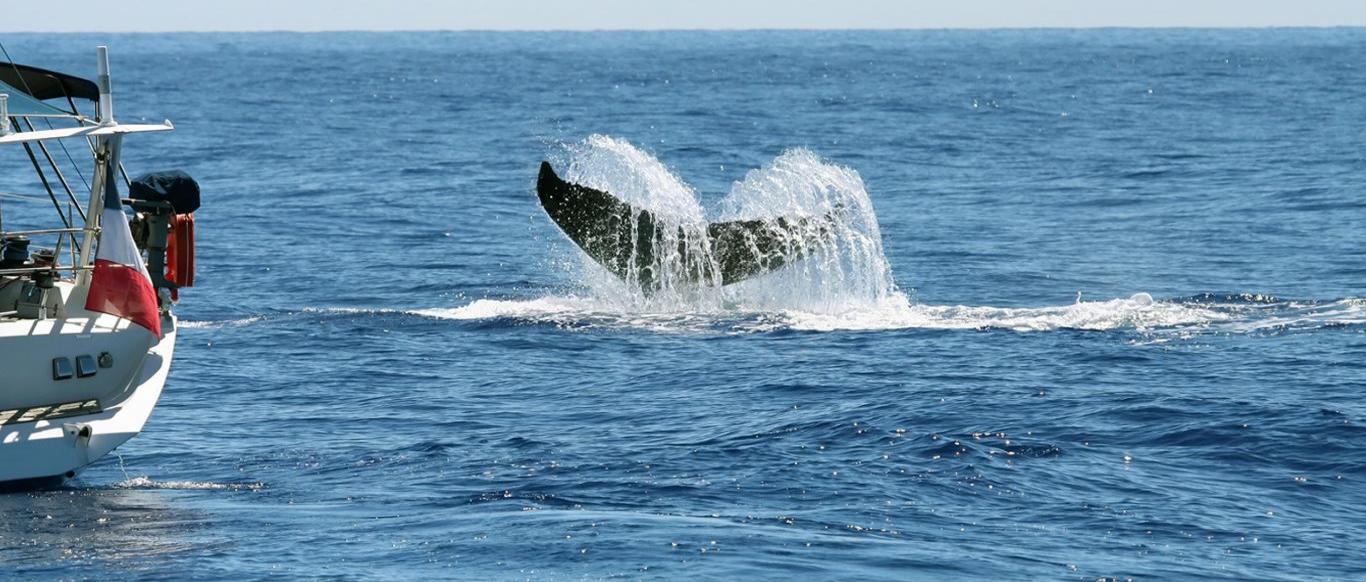
- Back to Blog
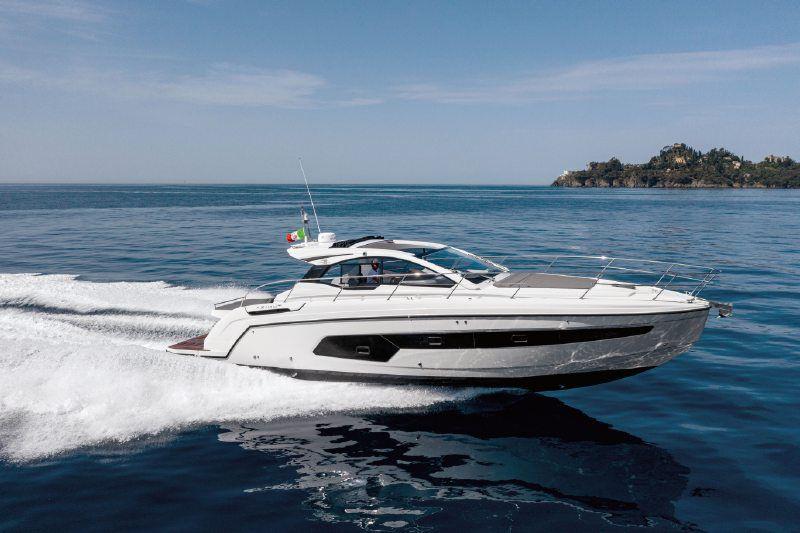
A chine on a boat refers to the sharp change in angle between the hull sides and the bottom. It runs lengthwise, parallel to the keel. The chine shape helps determine a boat's stability, maneuverability, and resistance in the water. There are three main types of chines used in recreational boat design:
A hard chine features a very distinct, sharp angle between the hull and bottom. This abrupt transition forms a firm, straight “edge” along the boat's sides. Hard chines are common in boats made from sheet plywood or aluminum, which can be bent sharply. They're also seen in fiberglass designs imitating the hard lines of traditional work boats.
Hard chines maximize interior volume by allowing increased beam. The firm edge adds lift when banking for turns, making the boat more responsive. However, the distinct corner can pound uncomfortably in choppy water. Tunnel hulls used for powerboats have very pronounced, exaggerated hard chines to increase stability and performance.
Semi-Displacement Hulls
Semi-displacement hulls blend a fine entry for cruising efficiency with flattened sides aft for greater stability and interior space. This creates a moderate chine shape as the hull transitions to the bottom. The chine is less distinct than a hard chine boat. Semi-displacement cruisers offer a compromise for occasional light planning combined with displacement cruising.
A soft chine transitions much more gradually from the hull sides to bottom with a rounded curve instead of a sharp edge. This gently radiused chine provides a smoother, more comfortable ride than hard chine boats, which pound more aggressively through waves. The rounded shape also slices smoothly with less drag. However, the gradual chine doesn't bank as tightly in turns.
Chine Advantages
- Interior space – Chines allow a wider, boxier hull shape that maximizes usable interior volume. This added beam provides more living space.
- Speed and efficiency – Hard chines generate lift when heeled over, helping the boat plane faster. A softer chine slices through water more efficiently.
- Stability – Flared topsides and flattened bottoms increase stability and reduce rocking motion, especially at rest. Wider chines resist heeling and rolling.
- Strength – Chines add strength to the hull structure. The angled shape provides stiffening and reduces flexing.
- Cost – Chine hulls can use less expensive sheet materials like plywood versus complex curved fiberglass shapes.
- Simplicity – Chine hulls are easier for amateur builders to construct than complex curved forms.
Chine Considerations
- Ride comfort – Hard chines transmit waves as pounding in choppy water. Softer chines provide a more comfortable ride.
- Speed – Soft chines won’t plane as easily given a similar power and weight. Hard chines plane faster.
- Directionality – Rounder chines allow easier turns and spinouts during direction changes.
- Weight – The greater hull volume and broader beam of chine designs tends to increase displacement and weight.
- Complexity – Soft chines require more complex curved planking and shapes during construction.
Chine Construction
Hard Chines
Hard chines lend themselves to simple construction using angled panels of plywood or planks. After joining the bottom panels to the sides, seal the inside corner with fiberglass tape for leakproofing. Hardeners can be used along the chine to add stiffness.
Soft Chines
Achieving a smooth, rounded chine requires precise bending of planks or curved panels. Softer angles need thicker hull materials to resist splitting. The use of steam or soaking allows the wood to gradually take shape around forms. Internal framing supports the smoother curve.
Fiberglass Chines
Fiberglass chines utilize molded shapes to create any style of chine. Rounded sections are formed with female molds made from chine plugs. Harder chines use male molds. Fiberglass allows the shape to be homogenously stiffened for a rigid, unified structure. Non-skid strips help prevent slipping on deck edges.
Choosing a Chine Design
The ideal chine shape for a boat depends on its intended use. Here are typical applications for each:
- Hard chines – High-speed powerboats, bass boats, jon boats, landing craft, pontoons. The sharp edge adds lift when banking.
- Semi-displacement chines – Cruisers, trawlers, military vessels. Balances speed with displacement efficiency.
- Soft chines – Sailboats, canoes, traditional designs. Smoother ride but less ability to plane.
- Variable deadrise – Combination of soft forward and hard aft, seen in offshore race boats and mod-V hulls.
While personal preference plays a role, carefully match the chine characteristics with the boat’s primary purpose. Consult a naval architect when questions arise about the right design. Properly implemented chines contribute significantly to a boat’s handling, performance and seaworthiness.
- The Future is Now: Boating's Cutting-Edge Trends for 2024
- A Step-by-step Guide on Removing Old Boat Lettering and Graphics
- Electric Principles for Boats: A Comprehensive Guide
- Navigating the Dangers: What to Do in a Lightning Storm on a Boat
- Navigating the Laws of Boating Under the Influence of Alcohol
Paddling.com
Hard chine vs. soft chine.
Why are soft chine designs so much more common? Have demo-ed many kayaks lately. Hard chine boats handle (turn) so much easier. It’s like having two hull shapes in one boat. Other than the increased wetted surface arguement, can anyone think of any other detriment to hard chine boats. Are hard chines more susceptible to broaching?
Funkier Secondary Stability
Soft chines give a more forgiving secondary stability. In most boats you can feel the boat at first resisting the lean and then increasing the tendency as you aproach the "Aw Crap" zone. Hard chine boats tend to have a very strong secondary but only in the "sweet spot". Its very easy to overdo it and end up wet.
My Take In the beginning hard-chine boats were easier to build and were refined for thousands of years. They handled well without rudders. With the advent of modern materials and molds people started building soft-chine boats just because they now could. True they are a little faster but most are dependant on add-ons to control them. Hard-chines are more of a paddlers boat… GH ducking…
more than hard versus soft Besides purely hard chined (Anas Acuta, Legend, Vela, etc) and soft chined (Outer Island, classic Pintail and Nordkapp, etc) there are many boats that fall between in their hull section. Actually most of the boats whose handling I like best are neither purely soft nor hard chined. My Romany is what NDK calls ‘modified hard chine.’ More precisely, it is soft edged hard chine. My Aquanaut is softer chined than my Romany. It looks soft chined when on the car next to my wife’s Explorer, or next to my friend’s Chatham 18, but next to another friend’s Outer Island it looks rather hard chined. It think the softer chined boats tend have broader more gradual secondary. Sometimes wholly soft edged soft chined boats seem to have no hang point on their secondary (e.g. Sirius). There are so many factors that impact a boats performance/personality that thinking in terms of hard versus soft chine is probably not worthwhile.
Agree I don’t have the range of experience with different kayaks that some here do, but your answer matches my own feedback. One thing I prefer about soft chines is how waves roll smoothly under the boat. With hard chines, there is definitely more of a slapping-smacking effect, and it is clearly audible also. Has an abrupt feel that I don’t like. Soft chines and free-moving hips feel more…fluid.
Construction Methods and Aesthetics
Chine shape has very little to do with all the performance things people claim. You can get any mix of primary and secondary stability, tracking, turning, or whatever with soft or hard chines - if all else is equal. Any one doubting this should look at Nick Shade's example of otherwise identical boats in both hard and soft chine versions: hard chine: http://www.guillemot-kayaks.com/guillemot/node/45/draw softer chine: http://www.guillemot-kayaks.com/guillemot/node/29/draw As he says: "The performance is almost identical. Modeling shows minor differences in stability, but they are below my threshold to detect on the water." The trouble is, people are not comparing the same boats like this. They are comparing very different boats - and assuming the differences have to do with the chines. Except for a very slight differences in the computer calculations - there should be no perceptible difference. Even the drag difference of the slight larger wetted surface with the chines is very minute (again, with otherwise identical hulls). The differences people feel are due to other factors like how flat the bottom, how much or little flare to the sides, how much rocker, etc, etc. The overall cross section shapes matter - and chines are a very small part of the overall cross section. Many "hard chined boats are relatively flat bottomed and have slab-like sides. The result is fairly box like cross section. Adding some degree of radius to the corners of that box will not do much to it's overall performance. Not all hard chined hulls are boxlike. My SOF in cross section is closer to round than square (more on this stuff here - scroll to end of post to see cross section drawing at the widest and flattest point of the hull): http://www.qajaqusa.org/cgi-bin/GreenlandTechniqueForum_config.pl/noframes/read/40610 Choice of chine shape is primarily about construction methods and materials. Not so much about the limitations of the materials either, but rather their strengths. Skin on Frame and Stitch and Glue plywood panel boats naturally are hard chined. The hull shapes and performance characteristic of these types can vary widely - and there are no "hard chine" performance qualities specific to these types. Rotomolded and composite boats tend to have softer chines because flat panels and sharp edges are not desirable/optimal on a molded shell. To get the most strength you want flowing compound curves, like an egg. Molding something flat is a a poor use of the technology. Again, there are no performance qualities specific to these types. Each process takes best advantage of its materials. Some composites do have hard chines - but this is more to get a desired look - with such design embellishments being used to elicit a certain feeling in the target customer. In other words: "styling". I doubt you'll ever get VCP to admit that about the Anas or Q-boat, or CD about the Caribou, as their performance jargon about "Greenland" and "hard chines" is a more powerful marketing tool than the styling itself (and some designers really do believe their own BS). If the customers enjoy the product - this marketing hype actually adds to their experience - so it's not really a bad thing. I have round hulls, very soft chine, soft chine, and hard chine kayaks. I like 'em all - but not because of chine type.
It is mostly which design is appealing to your eye. There is much speculation as to which hull design does this or that and I haven’t seen much of it to be true. Paddle a kayak and see if it has the handling characteristics you like. How a kayak performs has more to do with many other hull characteristics than hard chine or round hull.
Hard chine vs Soft chine Smoother ride. When people refer to hard chine and soft chine they are usually refering to a round chine boat and not the softened hard chine boat in Nick’s drawing. If you just soften a hard chine, yes, you won’t see much differerence. Many if not most of all commercial kayaks are designed on the computer these days and the speed of the hull is of prime importance. The computer model starts out with the ultimate shape which is a half circle for a hull. Many boat designers have just felt there was no need or benefit for hard chines that would ultimately slow down the hull speed. I do agree with the other poster in that I too find way smoother & greater secondary in the round chine boats. I do own three hard chine boats and enjoy paddling them.
Outer Island The Outer Island is a good example of the nuanced, fluid and confident feel possible in a truly soft chine boat. I marvel at my friend’s Outer Island. This boat rolls easier than any other boat I’ve paddled, yet has thouroughly reassurring stability - initial to final.
for the same reason fish aren’t hard chined. Water doesn’t flow smoothly around corners.
So many other factors My Vela is a single hard chined, then rather round on the bottom, wiggles around more than the Explorer LV but has fine secondary so no big deal. The Explorer has the modified hard chine of the Romany series. But the biggest diff that matters between these two boats isn’t in the chining. It’s in the fact that the Vela has a pretty tight bow and really needs the skeg to hold the fading stern in wind, and the LV has a pretty loose bow and is more equal in how the front and back get kicked around in stuff (especially if I trim the bow a little heavy). From the paddler’s seat, the latter stuff is much more noticeable than the chining. If I still had the Squall, which was a fully round-chined boat, I’d be saying that the boat’s overall stiffness in turning and in handling waves was much more of a factor in its diff’s from my present two boats than anything else.

Looksha "chines for maneuverability!"…AARRRRRRRGGGGGH
Extreme Differences in Extreme Condition One thing that makes a surf boat a surf boat is very hard, sharpe, low chines. http://www.cobrakayaks.com/kayaks/cobracat4.html Hard chines gives a lot more control on a steep wave face, but are much less forgiving than soft chines. You can really tell the difference in big, steep, short interval swells and/or breaking waves.
Broaching Regarding your last question, I have owned a fully soft-chined kayak (CD Squall), a sharp-edged, hard-chined kayak (Shearwater Merganser 16 S&G), and a soft-edged hard-chined (medium-chined?) kayak (WS Tempest 165). I still own the latter two kayaks and enjoy their different traits. But surprisingly, the rounded Squall was absolutely the most susceptible to suddenly broaching, despite being hard to turn without pronounced edging. The Merganser is easier to turn in calm water but harder to broach; possibly this is due not so much to type of chines as to the very sharp keel line. (Note: this is a MOVING turn, not sitting still and spinning around in circles, which it resists.) Once broached, though, it is like the Squall–somewhat hard to get back on track. The Tempest 165 will broach if I sit passively but I can always feel it coming and easily prevent or control it. Even if it does broach, it is much easier to correct than the other two kayaks. So, despite the fact that this boat still has a little of that hard-chine slap from beam waves, it is my favorite. I never feel like I am fighting this one. If you’re looking for a boat to buy, don’t get too hung up on what kind of chines it has. Paddle it and feel it.
Hard Chine Fish… There are a few but they are not very fast… Then again all fish have rudders. http://www.cowfishes.com/
Greyaks treatise should be a permanent pearl here.
Skegged fish handle better
Yeah I forgot about that. The Vela does have more of a tendency to catch on a wave face and be less forgiving about what I do next than the LV.
What Is A Chine? Exploring Definitions, Types, and Functions

A chine is an important feature in boat design that plays a crucial role in the overall performance and functionality of a watercraft. In simple terms, a chine refers to the intersection between the hull’s bottom and its sides . It is the sharp edge or angle that is formed where these two surfaces meet. Understanding the basic explanation and technical description of chines can provide valuable insights into their purpose and function.
Basic Explanation
At its core, a chine serves as a design element that contributes to the stability, balance, and hydrodynamics of a boat. By creating a distinct separation between the bottom and the sides of the hull, chines help regulate the way the boat interacts with water. They can influence factors such as maneuverability, speed, and overall performance.
Technical Description
From a technical standpoint, chines can take various forms depending on the type of boat and its intended use. There are three main types of chines: hard chine, soft chine, and multi-chine.
- Hard Chine : A hard chine is characterized by a distinct, sharp angle where the bottom meets the sides of the hull. This type of chine creates a more pronounced separation between the two surfaces, resulting in increased stability and a more defined water flow. Hard chines are commonly found in boats designed for speed, such as powerboats and racing sailboats.
- Soft Chine : In contrast to hard chines, soft chines have a more gradual transition between the bottom and the sides of the hull. This design creates a smoother water flow and enhances the overall maneuverability of the boat. Soft chines are often seen in recreational boats, fishing boats, and some types of sailboats.
- Multi-Chine : As the name suggests, multi-chine refers to boats that incorporate multiple chines along the hull. This design allows for even greater stability and maneuverability, particularly in rough or challenging waters. Multi-chine boats are commonly used in kayaks, canoes, and certain types of sailboats.
The purpose and function of chines extend beyond their impact on stability and balance. They also play a crucial role in ensuring the structural integrity of the boat. Chines help distribute the forces exerted on the hull, especially during high-speed maneuvers or when encountering waves. This distribution of forces helps prevent structural failure and enhances the overall durability of the watercraft.
Types of Chines

1. Hard Chine
A hard chine refers to a sharp angle or distinct edge formed where the hull side meets the bottom of a boat. This type of chine creates a noticeable break in the water as the boat moves, resulting in enhanced stability and improved tracking. Hard chines are commonly found in boats designed for speed and efficiency, such as powerboats and racing sailboats.
One of the primary advantages of a hard chine is its ability to provide excellent stability. The sharp angle creates a wider beam at the waterline, increasing the boat’s resistance to rolling. This stability is particularly beneficial in rough or choppy waters, allowing the boat to maintain balance and keeping the passengers comfortable.
Related: Can Buoys: A Guide to Their Marks and Meanings
Additionally, the hard chine design enhances hydrodynamic performance by reducing drag. The sharp angle helps to deflect water away from the hull, reducing friction and increasing speed. This design also contributes to better maneuverability, as the sharp chine provides a distinct edge for the water to flow along, allowing for precise and responsive handling.
However, hard chines can also have some disadvantages. The sharp edges can create a harsh ride in rough conditions, as the boat may tend to slam against the waves rather than slicing through them. Hard chines can also be prone to catching on obstacles or rocks, potentially causing damage to the hull.
2. Soft Chine
In contrast to hard chines, soft chines have a more rounded shape where the hull side meets the bottom. This design creates a smoother transition between the two surfaces, resulting in a softer ride and improved stability. Soft chines are commonly found in recreational and cruising boats, where comfort and versatility are prioritized.
The main advantage of a soft chine is its ability to provide a more comfortable and forgiving ride. The rounded shape allows the boat to gently roll with the waves, reducing the impact and providing a smoother experience for the occupants. This makes soft chines particularly well-suited for leisurely cruising, fishing, or simply enjoying a day on the water.
Another benefit of soft chines is their versatility. The gradual curve allows for a wider range of hull shapes and designs, accommodating various purposes and water conditions. Soft chines are often found in boats designed for stability, such as fishing kayaks or small sailboats, where the ability to maintain balance is crucial.
Despite their advantages, soft chines may not offer the same level of speed and efficiency as hard chines. The smoother transition between the hull side and bottom can create more drag, reducing overall speed. Additionally, soft chines may not provide the same level of responsive handling as their hard chine counterparts.
Related: A Comprehensive Guide To Marine Cranking Batteries: Types, Installation, Maintenance, And Troubleshooting
3. Multi-Chine
As the name suggests, multi-chine refers to a hull design that incorporates multiple chines. This type of chine offers a combination of the characteristics found in both hard and soft chines, providing a balance between stability, maneuverability, and comfort. Multi-chine hulls are commonly used in a wide range of watercraft, from small recreational boats to larger commercial vessels. The primary advantage of multi-chine hulls is their versatility and adaptability. By combining different chine angles and shapes, designers can optimize the hull for specific purposes and water conditions. This flexibility allows for a more customized approach, ensuring that the boat performs optimally in various scenarios.
Multi-chine hulls also offer enhanced stability, similar to hard chines. The presence of multiple angles or edges provides additional resistance to rolling, making the boat more stable and secure. This stability is particularly beneficial in rough waters or when carrying heavy loads, as it helps to maintain balance and prevent capsizing.
Furthermore, multi-chine hulls can provide a smoother ride compared to hard chines, thanks to the inclusion of softer transitions between the chine angles. This feature contributes to improved comfort and reduces the risk of the boat slamming against waves or choppy conditions.
However, it’s important to note that multi-chine hulls can be more complex to design and build compared to single chine options. The presence of multiple chines requires careful consideration of the angles, curvature, and overall hull shape to ensure optimal performance. Additionally, the inclusion of additional chines may increase the overall weight of the boat.
Purpose and Function of Chines
Chines play a crucial role in the design and performance of various watercraft. They serve multiple purposes and offer a range of benefits that enhance stability, hydrodynamics, and structural integrity.
Stability and Balance
One of the primary functions of chines is to provide stability and balance to a watercraft. Chines are the sharp edges or corners that run along the sides of a boat, kayak, or sailboat. Their presence helps in distributing the weight and buoyancy evenly, preventing the vessel from tipping over or rolling excessively.
Related: Living On A Houseboat: Benefits, Challenges, and Tips
When a boat leans to one side, the chine on that particular side increases the water’s resistance, creating a stabilizing effect. This ability to resist tipping is particularly important in rough waters or when making sharp turns. Whether you’re out for a leisurely cruise or engaging in water sports, chines provide the necessary stability to keep you safely afloat.
Hydrodynamics
Chines also play a significant role in enhancing the hydrodynamics of a watercraft. Hydrodynamics refers to the study of how water flows around and interacts with an object. The shape and design of chines influence the way water moves along the sides of a boat, ultimately affecting its speed, maneuverability, and overall performance.
Hard chines, characterized by sharp angles and distinct edges, create a more pronounced break in the water flow. This leads to increased lift and reduced drag, allowing the boat to cut through the water with greater efficiency. On the other hand, soft chines, with their rounded or curved edges, offer a smoother transition between the hull and the water, reducing turbulence and enhancing stability at lower speeds.
By carefully considering the shape and design of chines, boat designers can optimize hydrodynamic performance, ensuring a smoother and more enjoyable ride for boating enthusiasts.
Structural Integrity
In addition to stability and hydrodynamics, chines also contribute to the structural integrity of watercraft. They provide reinforcement and rigidity to the hull, making it more resistant to twisting or flexing under various conditions.
Chines act as additional support, especially in boats that experience high levels of stress, such as powerboats that navigate at high speeds or kayaks that encounter rough waters. By reinforcing the hull, chines help distribute the forces exerted by waves or impacts, reducing the risk of structural damage or failure.
Related: Features And Advantages Of A Fishing Boat Center Console
Furthermore, chines can also assist in preventing water from entering the boat, acting as a barrier that deflects splashing or spray. This feature is particularly beneficial for open kayaks or sailboats, where staying dry is essential for comfort and safety.
Overall, chines contribute significantly to the overall strength and durability of watercraft, ensuring their longevity and enabling them to withstand the rigors of various aquatic environments.
- Why do you think chines are crucial for stability in watercraft?
- Have you ever noticed how the shape of chines affects the speed and maneuverability of a boat?
- Can you think of any other ways chines contribute to the structural integrity of watercraft?
Chines in Different Watercraft
When it comes to different types of watercraft, chines play a crucial role in their design and performance. Chines can be found in various boats, including kayaks, sailboats, and powerboats. Each of these watercraft utilizes chines in unique ways, enhancing their stability, maneuverability, and overall functionality.
Chines in Kayaks
Kayaks are sleek and nimble vessels that are popular for recreational paddling, fishing, and even whitewater adventures. Chines in kayaks are typically designed to optimize stability and maneuverability in different water conditions.
One common type of chine found in kayaks is the hard chine. Hard chines have a distinct angular edge that provides excellent initial stability to the kayak. This feature allows paddlers to maintain balance and control, especially in calm waters or when making quick turns. Hard chines can also enhance the ability to carve and edge the kayak, making it an ideal choice for experienced paddlers who want precise control over their craft.
Another type of chine used in kayaks is the soft chine. Soft chines have a rounded edge, which offers a smoother transition between the hull and the sides of the kayak. This design provides greater secondary stability, making the kayak more forgiving and stable in rougher waters. Soft chines are often preferred by beginners or those who prioritize comfort and stability over maneuverability.
Related: A Comprehensive Guide To Marine Starting Batteries: Types, Installation, Troubleshooting, And Safety Tips
Kayaks may also feature multi-chines, which incorporate a combination of hard and soft chines. This design allows for a balance between initial and secondary stability, providing paddlers with versatility in different water conditions. Multi-chines can enhance the overall performance of the kayak, offering a compromise between agility and stability.
Chines in Sailboats
Sailboats are designed to harness the power of the wind and glide gracefully across the water. Chines in sailboats serve multiple purposes, including stability, hydrodynamics, and structural integrity.
Stability is a crucial factor in sailboats, as they rely on wind power to propel them forward. Chines in sailboats are designed to provide the necessary stability to counteract the force of the wind and prevent capsizing. The shape and placement of the chines contribute to the overall stability of the sailboat, ensuring a safe and enjoyable sailing experience.
Hydrodynamics, or the study of how water interacts with the boat, is another area where chines play a significant role in sailboats. The design of the chines can impact the flow of water along the hull, reducing drag and improving the overall speed and efficiency of the sailboat. Chines that are well-designed and properly integrated into the hull can enhance the performance of the sailboat, allowing it to slice through the water with minimum resistance.
Structural integrity is also a consideration when it comes to chines in sailboats. The chines help distribute the forces exerted on the hull, ensuring that the boat remains strong and stable even in rough conditions. By reinforcing the hull, chines contribute to the overall durability and longevity of the sailboat, making it capable of withstanding the rigors of extended voyages.
Chines in Powerboats
Powerboats, known for their speed and power, rely on chines to provide stability, hydrodynamics, and maneuverability.
Related: Guide To Painting A Boat: Preparation, Techniques, And Maintenance
Stability is crucial in powerboats, especially at high speeds. Chines in powerboats are designed to provide the necessary stability to keep the boat upright and balanced. This allows powerboat enthusiasts to enjoy thrilling rides without compromising safety .
Hydrodynamics also play a significant role in powerboats, as they need to cut through the water efficiently. Chines in powerboats are carefully designed to reduce drag and enhance the boat’s performance. By shaping the chines to direct water flow and minimize turbulence, powerboats can achieve higher speeds and better fuel efficiency.
Maneuverability is another important aspect of powerboats, particularly when navigating tight turns or congested waterways. Chines in powerboats contribute to their agility and responsiveness. The design of the chines allows the boat to maintain stability while executing sharp turns, making it easier for the driver to navigate through challenging conditions.
Advantages and Disadvantages of Chines
Chines are a fundamental design element in many watercraft, offering distinct advantages and disadvantages. Understanding these can help boat enthusiasts make informed decisions when choosing a vessel or modifying an existing one. In this section, we will explore the advantages and disadvantages of chines in detail.
Advantages of Chines
Chines bring several benefits to watercraft, enhancing their performance, stability, and maneuverability. Let’s delve into the advantages of incorporating chines into boat designs:
- Improved Stability : One of the key advantages of chines is their ability to enhance stability. By providing additional surface area along the hull, chines create greater buoyancy and resistance to rolling. This makes boats with chines more stable in rough waters and during sharp turns.
- Enhanced Maneuverability : Chines can significantly improve a boat’s maneuverability, allowing it to navigate tight spaces and execute precise turns. The sharp edges of chines act as hydrodynamic fins, providing better lateral control and reducing the boat’s tendency to slide or drift.
- Increased Planing Surface : Chines effectively increase the planing surface of a boat, making it easier for the vessel to achieve and maintain planing speeds. This is particularly advantageous for powerboats and sailboats, as it reduces drag and improves fuel efficiency.
- Structural Integrity : Chines can enhance the structural integrity of a boat by adding rigidity to the hull. The additional material and reinforcement along the chine line help distribute the forces exerted on the hull, making it more resistant to stress and potential damage.
- Ample Storage Space : Many boats with chines feature recessed areas or compartments along the chine line, providing extra storage space. This can be particularly useful for kayaks and small boats, allowing users to stow gear, fishing equipment, or personal belongings conveniently.
Disadvantages of Chines
While chines offer numerous advantages , they also come with certain disadvantages that should be considered. Let’s explore these drawbacks:
Related: Tips For Parking A Boat: Assessing, Avoiding Mistakes, And Docking Techniques
- Increased Draft : Chines can increase a boat’s draft, especially if they are wide or deep. This means that boats with chines may require deeper water to navigate comfortably, which can limit their usability in shallow or restricted areas.
- Reduced Speed in Displacement Mode : In displacement mode, where a boat operates at lower speeds and sits deeper in the water, chines can increase resistance and reduce overall speed. This is particularly noticeable in sailboats, where chines may hinder performance when sailing upwind.
- Potential for Spray : Depending on the design and shape of the chines, they can contribute to increased spray and splashing. This can be an inconvenience for passengers, especially in open boats or when traveling at higher speeds.
- Complex Construction : Building boats with chines can be more complex and labor-intensive than constructing those with a smoother hull design. The additional shaping and reinforcement required along the chine line can increase production costs and maintenance efforts.
- Aesthetics : While aesthetics are subjective, some boat enthusiasts may find chines less visually appealing compared to sleeker, more traditional hull designs. However, this is a matter of personal preference and does not impact the performance or functionality of the boat.
Chine Shape and Design Considerations
When it comes to designing watercraft, chine shape and design considerations play a crucial role in determining the performance and stability of the vessel. The angles and curvature of chines, as well as their width and depth, are key factors that boat designers must carefully consider. In this section, we will explore these aspects in detail to understand their significance and impact on different types of watercraft.
Angles and Curvature of Chines
The angles and curvature of chines have a direct influence on how a boat handles in the water. Chines can be designed with different angles, ranging from sharp to rounded. A sharper angle will create a more defined chine, resulting in a boat that is more responsive and maneuverable. On the other hand, a rounded chine will provide a smoother ride and better stability in rough waters.
To visualize this, imagine driving a car with square corners versus a car with rounded edges. The car with square corners will have sharper turns and may feel more agile, while the car with rounded edges will provide a smoother and more comfortable ride. The same principle applies to chines in watercraft.
Furthermore, the curvature of chines also plays a role in determining the boat’s stability. A boat with chines that gradually curve upwards towards the gunwale will have better stability, especially in rough or choppy waters. This design helps to deflect waves and prevents water from splashing into the boat, enhancing the overall safety and comfort of the occupants.
Chine Width and Depth
The width and depth of chines are equally important considerations in boat design. The width of chines refers to how wide they are in relation to the overall width of the boat. A wider chine provides increased stability, especially when the boat is at rest or moving at slower speeds. This is particularly important for kayaks, sailboats, and other watercraft that require a high level of stability.
On the other hand, the depth of chines determines how deep they extend into the water. A deeper chine will create more buoyancy and lift, allowing the boat to ride higher on the water. This can improve the overall performance and speed of the vessel, making it more efficient and easier to handle.
Related: Building A Boat: Materials, Design, Construction, Safety, And Maintenance
To better understand the concept of chine width and depth, let’s imagine a kayak designed for whitewater rafting. The kayak needs to be stable enough to handle the turbulent waters, and this is achieved by having wider chines. Additionally, the depth of the chines ensures that the kayak stays afloat even when it encounters strong currents or obstacles. In summary, the angles and curvature of chines, as well as their width and depth, are important considerations in boat design. These factors directly impact the stability, maneuverability, and overall performance of the watercraft. By carefully considering these design elements, boat designers can create vessels that excel in their intended environment, whether it be calm lakes, rough seas, or fast-flowing rivers.
- To ensure maximum stability and maneuverability, boat designers carefully consider the angles and curvature of chines.
- Chine width plays a crucial role in providing stability, especially at rest or slow speeds.
- The depth of chines impacts buoyancy and lift, affecting the boat’s performance and efficiency.
- The design of chines can be customized to suit the specific needs of different types of watercraft.
- By understanding the importance of chine shape and design considerations, boat enthusiasts can make informed decisions when selecting or customizing their vessels.
Maintenance and Repair of Chines
Maintaining and repairing chines is an essential part of boat ownership. Chines are subjected to constant stress and strain, especially during rough water conditions or accidental impacts. Regular inspections and timely repairs can help ensure the structural integrity of the chines and extend the lifespan of your watercraft. In this section, we will discuss how to inspect chines for damage and provide guidance on repairing damaged chines.
Inspecting Chines for Damage
Inspecting your chines for damage should be a regular part of your boat maintenance routine. By identifying and addressing issues early on, you can prevent further damage and costly repairs down the line. Here are some key steps to follow when inspecting your chines:
- Visual Inspection : Start by visually examining the chines for any visible signs of damage, such as cracks, chips, or deformities. Inspect both the outer and inner surfaces of the chines, paying close attention to areas where the chines meet the hull.
- Physical Inspection : Run your hands along the chines to feel for any irregularities or abnormalities. Look out for soft spots, dents, or areas that seem weaker than the rest of the chine.
- Tap Test : Gently tap the chines with a rubber mallet or your knuckles to listen for any hollow sounds. A solid, dull sound indicates a well-built chine, while a hollow or echoing sound may suggest delamination or damage.
- Water Test : Fill a spray bottle with soapy water and spray it along the chines. Observe for any bubbles or foaming, as this may indicate the presence of hairline cracks or leaks.
- Rot Test : Inspect the chines for any signs of rot or decay, especially in wooden boats. Use a screwdriver or awl to poke the chine and check for soft spots or areas that easily penetrate the surface.
Regularly inspecting your chines for damage allows you to catch issues early on and take appropriate action. If you notice any significant damage or suspect structural issues, it is recommended to consult a professional boat repair specialist for further assessment.
Repairing Damaged Chines
Repairing damaged chines requires careful attention and skill to ensure a proper fix. Depending on the extent of the damage, you may need to consider different repair methods. Here are some common approaches to repairing damaged chines:
- Fiberglass Repair : For fiberglass boats with cracked or damaged chines, fiberglass repair is often the go-to solution. Clean the damaged area and remove any loose or damaged material. Apply a layer of fiberglass cloth or matting over the damaged section, and then saturate it with epoxy resin. Build up multiple layers if necessary, allowing each layer to cure before applying the next. Sand and finish the repaired chine to match the surrounding area.
- Wooden Boat Repair : Traditional wooden boats may require a different approach when repairing damaged chines. If the damage is minimal, you can use epoxy or marine-grade adhesive to fill in cracks or gaps. For more significant damage, consider scarfing in a new piece of wood to replace the damaged section. This involves cutting a tapered joint between the new and existing wood, applying epoxy adhesive, and clamping the pieces together until fully cured. Once the repair is complete, sand and finish the chine to blend with the rest of the boat.
- Aluminum or Metal Repair : If your boat has aluminum or metal chines, repairing damage may involve welding or patching. Consult a professional metal fabricator or boat repair specialist to assess the damage and determine the appropriate repair method.
Remember, it is crucial to follow manufacturer guidelines and recommendations when repairing chines. If you are unsure about the repair process or lack the necessary skills, it is best to seek professional help. A well-executed repair ensures the structural integrity of the chines and maintains the overall performance and safety of your watercraft.
Related: Exploring Different Life Jacket Types: Inflatable, Foam, And Hybrid
Chines in Traditional and Modern Boatbuilding
Chines play an important role in both traditional wooden boats and modern fiberglass boats. These distinctive features are designed to enhance the performance and stability of the watercraft. Let’s dive into how chines are used in each boatbuilding method.
Chines in Traditional Wooden Boats
Traditional wooden boats have a rich history that spans centuries. In these boats, chines are typically incorporated into the design to provide additional stability and structural integrity. The chine in a traditional wooden boat is created by the intersection of the hull planks and the bottom of the boat.
One notable type of traditional wooden boat that utilizes chines is the dory. Dories are flat-bottomed boats with hard chines that extend from the bow to the stern. The hard chines on a dory help to improve stability and enable the boat to navigate through rough waters with ease. These chines act as mini-keels, assisting in maintaining balance and preventing the boat from capsizing.
Another example of chines in traditional wooden boats is the lapstrake construction technique. In lapstrake construction, overlapping planks are used to create the hull. The edges of these planks form chines, which not only add rigidity to the boat but also contribute to its overall performance in the water.
Chines in Modern Fiberglass Boats
With advancements in boatbuilding materials, fiberglass boats have gained popularity due to their durability and versatility. Chines are also an integral part of modern fiberglass boats, serving various purposes depending on the specific design.
In modern fiberglass boats, chines are often incorporated to enhance stability and hydrodynamics. A common type of chine used in fiberglass boats is the soft chine. Soft chines have a smooth and rounded transition from the hull to the deck, creating a more gradual shape. This design helps to improve the boat’s maneuverability and make it more forgiving in rough water conditions.
Related: What Is The Keel? Definition, Types, Materials, Design Considerations, And Maintenance
Multi-chine designs are also prevalent in modern fiberglass boats. These boats have multiple chines that extend along the hull, providing additional stability and buoyancy. The multiple chines create distinct planes on the hull, allowing the boat to ride on top of the water more efficiently. This design is particularly beneficial for powerboats and sailboats, as it reduces drag and increases speed.
In summary, chines have been used in both traditional wooden boats and modern fiberglass boats to enhance stability, balance, and hydrodynamics. Whether it’s the hard chines in traditional wooden dories or the soft chines in modern fiberglass boats, these features contribute to the overall performance and functionality of the watercraft.
In traditional wooden boats: – Dories utilize hard chines for stability in rough waters. – Lapstrake construction creates chines that add rigidity to the boat.
In modern fiberglass boats: – Soft chines provide smoother maneuverability and forgiveness in rough water conditions. – Multi-chine designs improve speed and reduce drag in powerboats and sailboats.
As boatbuilding techniques continue to evolve, the use of chines remains a fundamental aspect of designing watercraft that balance both form and function.
Chine Modifications and Customization
When it comes to boat customization, chine modifications are a popular choice among boating enthusiasts . Whether you want to enhance the performance of your boat or simply add a personal touch, adding or modifying chines can make a significant difference. In this section, we will explore two common chine modification techniques: adding chines to a boat and modifying existing chines.
Adding Chines to a Boat
Adding chines to a boat is a technique that involves attaching additional chine sections to the hull. This customization option is particularly popular for boats that lack chines or have shallow chines. By adding chines, you can enhance the stability and maneuverability of your boat, especially in rough waters.
One of the main advantages of adding chines is improved stability. The additional chine sections increase the boat’s ability to resist rolling and pitching motions, providing a more stable platform for various activities such as fishing or water sports. Moreover, chines can also improve the tracking of the boat, allowing for better control and smoother navigation. To add chines to a boat, you can choose from a variety of materials, including wood, fiberglass, or aluminum. The choice of material depends on factors such as the boat’s construction and the desired aesthetic. It is important to ensure that the added chines are securely attached to the hull to avoid any structural issues or water leakage.
Modifying Existing Chines
Modifying existing chines is another customization option that allows boat owners to optimize the performance and handling of their vessels. This technique involves altering the shape, width, or depth of the existing chines to achieve specific desired characteristics.
One common modification is altering the angle or curvature of the chines. By changing the angle, you can adjust the boat’s ride characteristics. For example, a sharper angle can provide better cornering abilities, while a more rounded chine can offer smoother transitions and improved stability.
The width and depth of the chines can also be modified to suit different purposes. Wider chines provide increased lift and stability, making them suitable for high-speed powerboats. On the other hand, narrower chines offer better agility and maneuverability, making them ideal for kayaks or smaller sailboats.
When modifying existing chines, it is crucial to consider the boat’s original design and intended use. Working with a professional boat designer or naval architect can ensure that the modifications are done correctly and in accordance with the boat’s structural integrity.
Pros and Cons of Chine Modifications
Chines in Historical and Cultural Context
Chines, an integral part of boat design, have a long and rich history that is deeply intertwined with both indigenous watercraft and the historical evolution of chine design. Understanding the cultural significance and the development of chines over time provides valuable insights into their purpose and function in modern boatbuilding.
Chines in Indigenous Watercraft
Indigenous watercraft across different regions of the world have incorporated chines into their designs for centuries. These boats were built by skilled craftsmen who understood the importance of stability and balance in their vessels. The inclusion of chines allowed these boats to navigate various water conditions, including rivers, lakes, and oceans, with greater ease and control.
In North America, for example, indigenous tribes such as the Inuit and Aleut people relied heavily on kayaks for hunting and transportation. These kayaks featured chines that provided exceptional stability in the often turbulent waters of the Arctic. The chines allowed the kayaks to maintain an upright position, making it easier for the paddler to navigate and maneuver.
Similarly, in other parts of the world, indigenous watercraft like outrigger canoes and dugout canoes also incorporated chines. These chines played a crucial role in providing stability, especially when these boats were used for fishing or long-distance travel. The chines acted as a stabilizing element, ensuring that the boats remained steady even in rough waters.
Historical Evolution of Chine Design
The historical evolution of chine design has been an ongoing process, with boatbuilders continuously refining and adapting the concept to meet their specific needs. Over time, different types of chines emerged, each with its own advantages and characteristics.
One of the earliest forms of chine design was the hard chine. This type of chine features a distinct, sharp angle where the hull meets the deck or sides of the boat. Hard chines were commonly found in traditional wooden boats, providing excellent stability and maneuverability. The sharp angle created by the hard chine allowed the boat to cut through the water with minimal resistance, making it ideal for sailing and fishing.
As boatbuilding techniques advanced, soft chines became more prevalent. Soft chines have a more gradual transition from the hull to the deck or sides of the boat, resulting in a smoother, rounded appearance. This design offers improved hydrodynamics, reducing drag and enhancing the boat’s overall performance. Soft chines are often found in modern fiberglass boats, where efficiency and speed are paramount.
In addition to hard and soft chines, the concept of multi-chine design emerged. Multi-chine boats have multiple angles or curves along their hull, creating additional stability and increasing the boat’s load-carrying capacity. This design is commonly seen in larger powerboats and sailboats, where stability and space are essential considerations.
The evolution of chine design has also been influenced by advancements in materials and construction techniques. Traditional wooden boats relied on the strength and flexibility of wood, while modern fiberglass boats take advantage of the lightweight and durable properties of composite materials. These advancements have allowed boatbuilders to experiment with different chine shapes and designs, pushing the boundaries of performance and functionality.
In conclusion, chines have a fascinating historical and cultural context that can be traced back to indigenous watercraft and the continuous evolution of chine design. The inclusion of chines in various types of boats, from kayaks to powerboats, highlights their importance in providing stability, balance, and enhanced hydrodynamics. As boatbuilding techniques continue to evolve, chine design will undoubtedly undergo further refinements, ensuring that boats of the future benefit from this centuries-old concept.
You may also like
- Sleeping On A Boat: Tips For Restful Nights On The Water
- Boost Your Boat’s Value: Key Factors, Tips, And Mistakes To Avoid
- Discover The Benefits Of A Marine Solar Battery Charger | Improve Efficiency And Save Costs
- Boost Your Boat’s Battery Life With A Solar Trickle Charger – Ultimate Guide
- 10 Custom Pontoon Boat Ideas That Will Blow Your Mind
- Discover The Best Boat To Dock Ramps For Convenient Loading And Unloading
- Discover The Benefits Of A Solar Deep Cycle Battery Charger
- Discover The Key To Boat Cover Longevity: Boat Cover Support Poles
- Unlock The Secrets Of KBB Used Boat Values And Maximize Your Boat’s Worth
- Maximize Your Boat’s Efficiency With A Solar Battery Charger

Franklin C. Miller is an experienced sailor and passionate boating enthusiast. With seven years of global exploration on waterways and coastlines, Franklin started BoatBlissBlog to share his knowledge, insights, and adventures with fellow boating enthusiasts.

How to Get Top Dollar for Your Boat (Even Without a Kelley Blue Book)

Famous Ship Names From History, Literature, Film, Mythology, Exploration, And Battles

Miami To Bahamas by Boat: A Comprehensive Guide for Smooth Travel

Channel Markers: Everything You Need to Know to Navigate Safely

Navionics Boating App: Your Essential Companion for Safe and Fun Boating
Leave a comment cancel reply.
Save my name, email, and website in this browser for the next time I comment.

IMAGES
VIDEO
COMMENTS
The Origins of Hard Chines in Racing. "Hard chines, or let´s say, wide aft sections in boat design derive from the planning power boats or, if you look at sailboats, small jolly boats just as the 49er or 14/18-footers.", he starts: "These boats are made to displace as less as possible and remind more of a surf-board.
Single-chine hulls are generally only seen on multihull sailboats, which often use two deep V-shaped hulls connected by akas to provide mutual stability. The two-chine hull (B), with a flat bottom and nearly vertical sides, was the first hard-chine design to achieve widespread use. This design provides far more stability than the single-chine ...
The chine of a boat is a transition point where the side of the boat hull meets its bottom part. It's characterized by a sharp change of direction (ridge) in the bottom part of a boat. It plays a supporting role in enhancing the watercraft's performance and stability. Table of Contents [ hide] Definition and History of a Boat Chine.
As innovation continued, the hard chine developed. This was a hull with a hard angle that does away with the rounding that was popular in the past. After the development of the steeply angled chines, there came the multi-chine hulls. These multi-angle boat chines fit almost any purpose that can be conceivably thought of.
In Paris, hard chines need not be confined to metal cruising boats. Here's a sporty fiberglass daysailer with a significant hard chine. More: beneteau, keelboat, monohull, Sailboats. This year's new boat fleet featured several boats with aft sections that have more than a hint of hard chine. The question is: Do these creases in the hull ...
Posts: 500. Re: Hard chine. Yes - The hard chine, when sailing on a reach, adds significantly to stabilize the boat. Going upwind the leeward chine also works as additional stabilization as it tends to lift the boat higher. So the boats need less ballast which makes them lighter and faster.
There is a noticeable hinge effect when a hard chine boat is leaned past as it's secondary stability whereas the rounded chine doesn't have the hinge effect Rather, it there is feel of progressive resistance to a point at which the secondary stability is overcomed. Yes, hard chine will carve better on a leaned turned but as someone also ...
Here attached also the Gene-Hull Sailboat 3.1 file with the example in place and the two parameters to change are in red, in cells B39 (to change 0 to 1 to trigger the hard chine) and B64 (to change 2 to 1 to reshape the sections) , you can do it yourself : change in B39, look at the drawings, then change in B64, look at the final drawings (it ...
Exterior design. Built to combine safety, luxury and performance, the Oceanis 45's distinctive hard chine promotes stability and increases interior space. Boasting a large cockpit with dual helms, open deck plan, roomy seating and a transom that doubles as a swim platform, this yacht corners the market in function and comfort.
Moreover, the chine design can impact the boat's construction process. Hard chines can simplify the building process, as they often require fewer materials and less complex assembly. Conversely, soft chines may necessitate more intricate craftsmanship and a more extended construction timeline. Chine Angle: A Critical Factor in Boat Performance
Composite multi-chine 38-40 feet sailboat plans. Discussion in 'Boat Design' started by Stefano Dilena, Feb 2, 2022. Joined: May 2021 ... These characteristics make not only for a fast boat, but also for an easier construction due to the hard chines, a more comfortable sailing due to the wide space on deck, and more space under the deck due to ...
The Open Bic is already an International Sailing Federation (ISAF)-sanctioned class, and fleets are developing around the US. Another bonus: Its an easily portable boat that can be carried like a windsurfer, adding excitement to a Sunday picnic at the beach. The thermo-formed polyethylene hull is a modified hard-chine design with lots of beam aft.
With a hard chine aft and more volume forward, this 65-footer will be fast on windward-leeward courses. "Grand Prix Launch" from our June 2008 issue
Received 456 Likes on 210 Posts. Re: Soft vs. Hard Chines. One of the differences is in the "dryness", the hard chine will spit the water out and away from the boat whereas the soft chine will allow some to spray up the side of the boat. Another is the ability to plane, as you can guess the hard chine has the flat surfaces which will help it ...
The Lightning's hard chine and 130 lb centerboard give her the stability and power of a small keel boat going to weather in strong winds and allow her to carry a very large spinnaker for ...
MAGELLAN CLOUD. Available with either hard chine plywood or a strip plank construction. Magellan Cloud is an aft cockpit staysail schooner developed from the Tavoy hull and using the same rig. Features are the worki. LOA. 10.67m. 35'0". Beam. 7.62m.
The choice of chine type in boat design depends on factors such as the boat's intended use, operating conditions, and the desired balance between stability and comfort. What are the characteristics and advantages of each type of chine? 1. Hard Chines: Hard chines feature distinct, sharp angles where the hull bottom meets the hull sides.
The boat without a chine was in almost every way a similar boat to the other two, just no chines. The no chine boat was designed by the Farr office. I am inclined to think they got it right. ... Then the chine was immersed and they had a hard time past that point keeping the boat from rounding up. I think that can be a problem with any boat ...
You can get a bit more stablity with hard chines of identical hulls, but no two brands are identical, other factors have FAR more influence than chine/no chine. A good designer can make a hard chine hull behave identical to a round bilge one by trading off other design features. Usually a fast planing hull will come up on plan much faster with ...
The chine is less distinct than a hard chine boat. Semi-displacement cruisers offer a compromise for occasional light planning combined with displacement cruising. Soft Chine. A soft chine transitions much more gradually from the hull sides to bottom with a rounded curve instead of a sharp edge. This gently radiused chine provides a smoother ...
Soft chines give a more forgiving secondary stability. In most boats you can feel the boat at first resisting the lean and then increasing the tendency as you aproach the "Aw Crap" zone. Hard chine boats tend to have a very strong secondary but only in the "sweet spot". Its very easy to overdo it and end up wet.
January 25, 2024. A chine is an important feature in boat design that plays a crucial role in the overall performance and functionality of a watercraft. In simple terms, a chine refers to the intersection between the hull's bottom and its sides. It is the sharp edge or angle that is formed where these two surfaces meet.
The history of boat chines in kayak design. The early skin kayaks of the Arctic relied on wooden ribs and longitudinal stringers for form. Those stringers were responsible for the single hard-chine, V-shaped hull of the Inuit or Greenland-style kayak and the multiple hard chines of the Aleutian baidarka design. It wasn't until the advent of fiberglass and plastic that builders designed ...